In My Korea

Korean Etiquette, Culture And Manners: 35 Useful Insights
Do you know what’s considered rude in Korea? Are you interested in learning some insights into Korean etiquette, culture, and manners so that you can impress people when you travel? Want to know if you should tip in Korea? Eager to find out more about Korean culture to help you understand your favourite K-Drama?
Whatever you’re interested in, these insights to Korean etiquette will show you what’s considered rude in Korea, how to make friends and socialise, what manners are expected when dining out, special rules for the Korean workplace, and lots more.
There are dozens of insights and my personal comments about Korean culture, including how strictly rules are followed, how Korean society is changing, how to avoid offending people, and how to make a great first impression in Korea.
Table of Contents
Find out all you need to know about Korean etiquette and gain a deeper understanding of Korean culture. It will open your eyes to the many cultural differences that make Korea such a unique and interesting place to explore and learn about.
Affiliate Disclaimer : This site contains affiliate links and I may earn commission for purchases made after clicking these links.
Why Learn About Korean Etiquette?
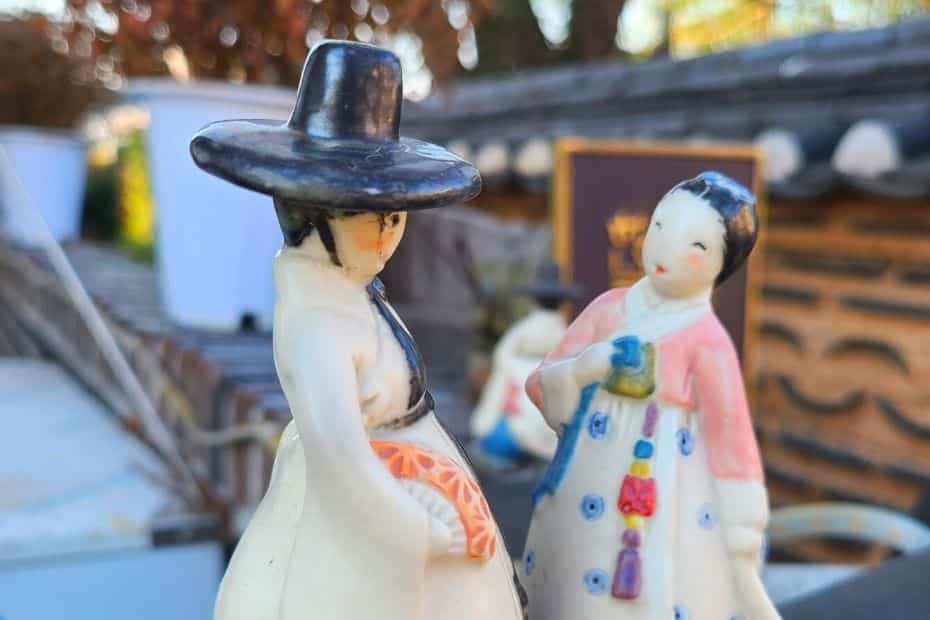
Korean etiquette rules, customs, and manners have developed over centuries, influenced various cultural factors. These factors include a strong hierarchy, Confucian ideals, and a sense of Han Spirit – a uniquely Korean emotion that embodies grief and resentment from centuries of suffering.
Not knowing about these uniquely Korean cultural rules can leave people feeling confused or upset when they travel to Korea or talk with Korean friends and encounter a situation or action they don’t understand.
This guide will stop you making embarrassing mistakes and cultural faux pas. It will also shine a light into the behaviour (hidden or open) of Korean people & society in general and help you understand why things happen the way they do.
This article covers a wide range of the most common Korean etiquette rules, customs, beliefs, and superstitions. It shows you how to display good manners and follow etiquette rules in various situations, such as when eating out, socialising, or at work.
In some sections there are Korean cultural insights and ‘ reality checks ‘ that show my opinion on these rules and how strictly they’re followed. I hope you’ll find them useful.
Now, here are the 35 tips that will teach you how to avoid being rude, how to follow Korean etiquette rules, how to show good manners, and how to make a good impression in Korea. Afterwards, there’s a guide to Korean culture and how it has shaped Korean etiquette. Be sure to read to the end.
I’m not Korean, nor have I formally studied Korean etiquette or culture in a professional manner. If there are any mistakes, I apologise and will correct them. The insights shared here are from what I’ve personally experienced from living in Korea since 2015, what I’ve learnt about from Koreans, and what I’ve researched from other sources.
These rules don’t apply to every single person or situation in Korea, and of course there are plenty of exceptions to every rule. This article is intended to introduce and explain common cultural differences you can witness in Korea and to help people understand more about Korean culture, etiquette and manners.
Planning to visit Korea? These travel essentials will help you plan your trip, get the best deals, and save you time and money before and during your Korean adventure.
Visas & K-ETA: Some travellers to Korea need a Tourist Visa , but most can travel with a Korean Electronic Travel Authorisation (K-ETA). Currently 22 Countries don’t need either one.
How To Stay Connected : Pre-order a Korean Sim Card or a WiFi Router to collect on-arrival at Incheon Airport (desks open 24-hours). Alternatively, download a Korean eSIM for you travels.
Where To Stay : For Seoul, I recommend Myeongdong (convenient), Hongdae (cool culture) or Gangnam (shopping). For Busan, Haeundae (Beach) or Seomyeon (Downtown).
Incheon Airport To Seoul : Take the Airport Express (AREX) to Seoul Station or a Limo Bus across Seoul. Book an Incheon Airport Private Transfer and relax to or from the airport.
Korean Tour Operators : Tour companies that have a big presence in Korea include Klook , Trazy , Viator , and Get Your Guide . These sites offer discounted entry tickets for top attractions
Seoul City Passes : Visit Seoul’s top attractions for free with a Discover Seoul Pass or Go City Seoul Pass . These passes are great for families and couples visiting Seoul – you can save lots.
How To Get Around : For public transport, grab a T-Money Card . Save money on Korea’s high speed trains with a Korea Rail Pass . To see more of Korea, there are many Rental Car Options .
Travel Money : Use money exchanges near Myeongdong and Hongdae subway stations for the best exchange rates. Order a Wise Card or WOWPASS to pay by card across Korea.
Flights To Korea : I use flight comparison sites such as Expedia and Skyscanner to find the best flights to Korea from any country. Air Asia is a good option for budget flights from Asia.
How To Learn Korean : The language course from 90 Day Korean or Korean Class 101 both have well-structured lessons and lots of useful resources to help you learn Korean.
What Is Considered Rude In Korea?
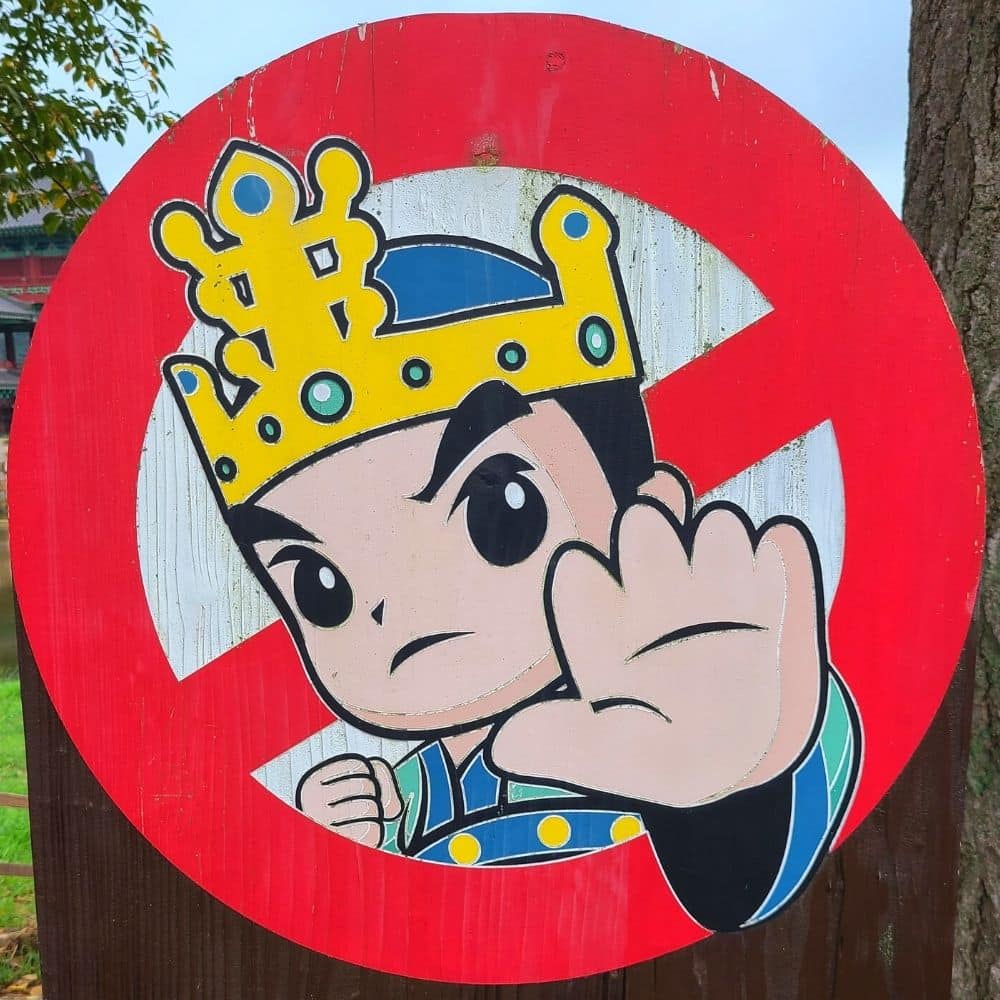
One of the most important things to know when travelling to a culturally distinctive place like Korea is how to avoid being rude. Knowing what is considered rude in Korea is not only useful to avoid difficult situations, but also to show Koreans that you’ve taken time to learn about their culture.
If it’s considered rude in your country, it’s probably considered rude in Korea. Things such as spitting, shouting, hitting people, swearing, and generally being obnoxious are definitely rude in Korea. I haven’t added them to this list as they should be obvious.
If you follow these rules and avoid these taboos, you will not only avoid cultural faux pas, you can start to make friends in Korea and show respect when you travel and engage with Koreans, at home or abroad.
1: Writing Someone’s Name In Red Ink

Koreans used to write the names of deceased people in red ink. Doing the same to a living person indicates that you either wish they were dead, or else want to do them harm.
This is a pretty serious etiquette mistake and I’ve been in trouble for doing it in the past. If you’re going to be writing in front of Korean people, be safe and stick to black or blue ink.
2: Wearing Shoes Inside Someone’s House
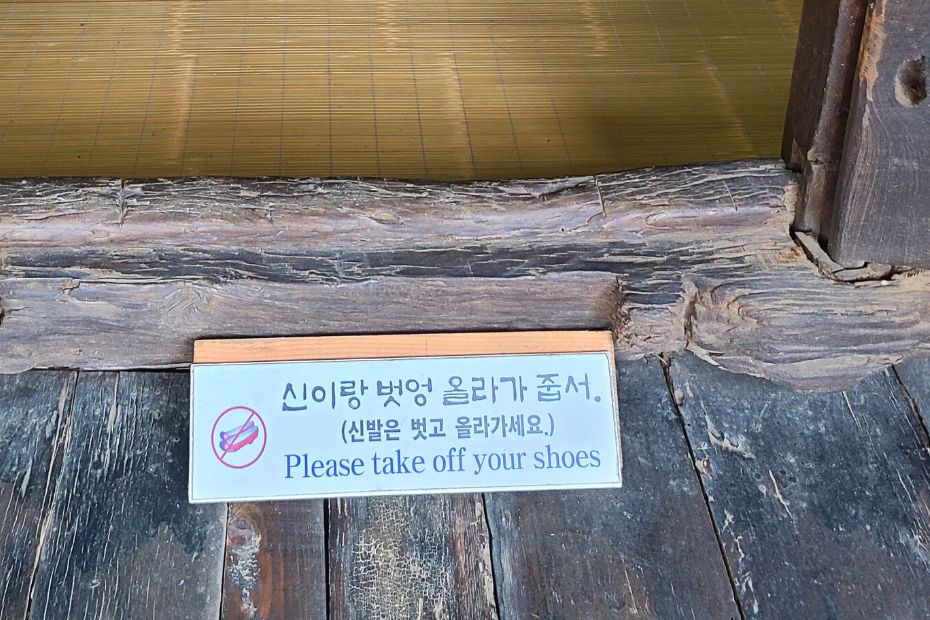
Every Korean house is a shoe-free area and it is considered rude to wear shoes inside someone’s house. It’s not only rude to wear your shoes into a Korean house, it’s also unlucky and dirty. Show good manners by removing your shoes when you enter.
Korean houses have a small area when you first enter that is for removing shoes. You can tell it because it’s lower than the rest of the floor. If you step up into someone’s house, that means you’re entering into a no-shoe area and you should take off your shoes immediately. There may be guest slippers you can wear, although that depends on the house you’re visiting.
3: Crossing Your Legs When Talking To Someone
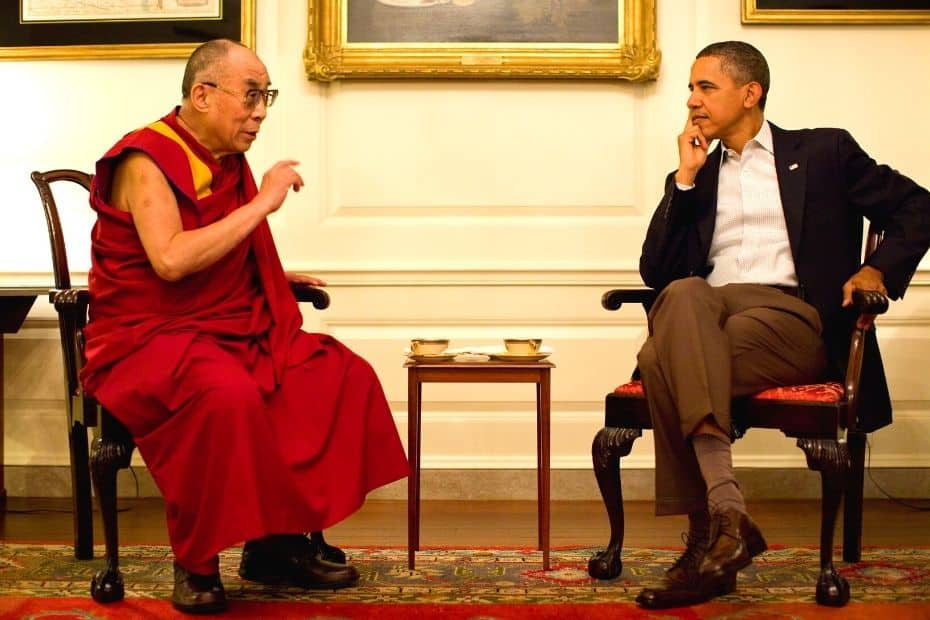
In Korea, it is considered rude to cross your legs in the presence of someone ‘superior’. In Korea, that means higher in society, either through their job or their age. It isn’t considered rude to cross your legs in front of friends and people of a similar (or lower) social standing as you.
It’s more acceptable to sit with your legs straight or open a bit. Crossing your legs is seen as being lazy or disrespectful to the other person. Therefore, you should sit up straight and keep your hands on your lap. Open body language shows honesty and attentiveness.
This can definitely be an issue in the workplace and a hard habit to break. If you’re travelling in Korea, don’t worry about it too much. If you’re on business, sit carefully.
4: Shaking Hands With One Hand And Not Two
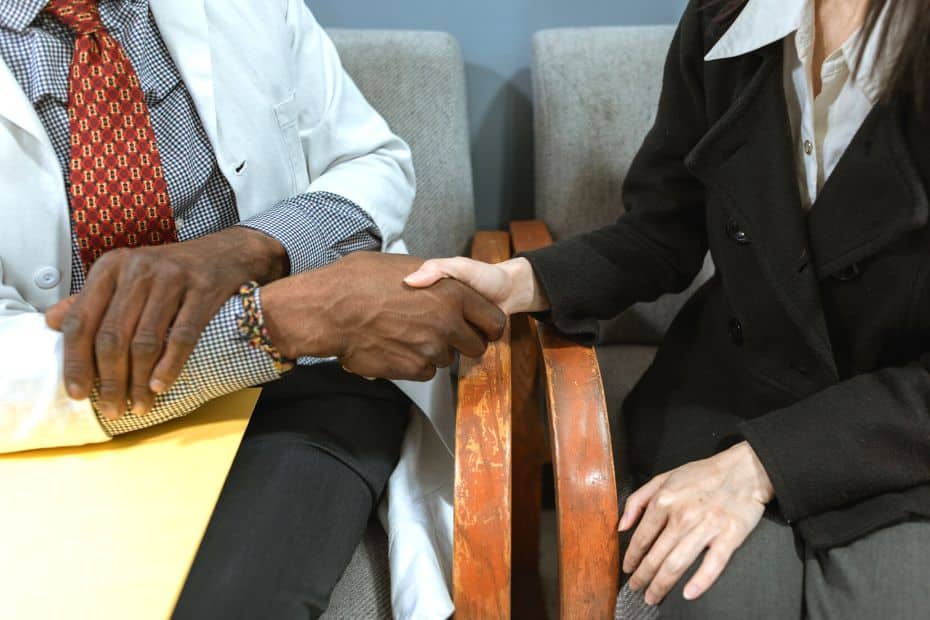
A one-handed handshake is certainly bad etiquette in Korea and you should instead shake with two hands. Why is it considered rude? This most likely goes back to times of court intrigue, where people showed both hands to prove they weren’t hiding any concealed dangers, such as a knife or poison.
There are several acceptable ways to shake hands in Korea, all of which include both hands. First, shake holding both hands. If that’s not appropriate, the left hand should be placed on the right wrist or between the wrist and elbow. Alternatively, tuck the left arm around the waist under the right arm.
In 2013, Bill Gates made the front-page of newspapers in Korea when he greeted the former Korean president, Park Geun Hye, with one hand in his pocket. He disrespected her by not using both hands.
5: Standing Chopsticks Upright In Rice
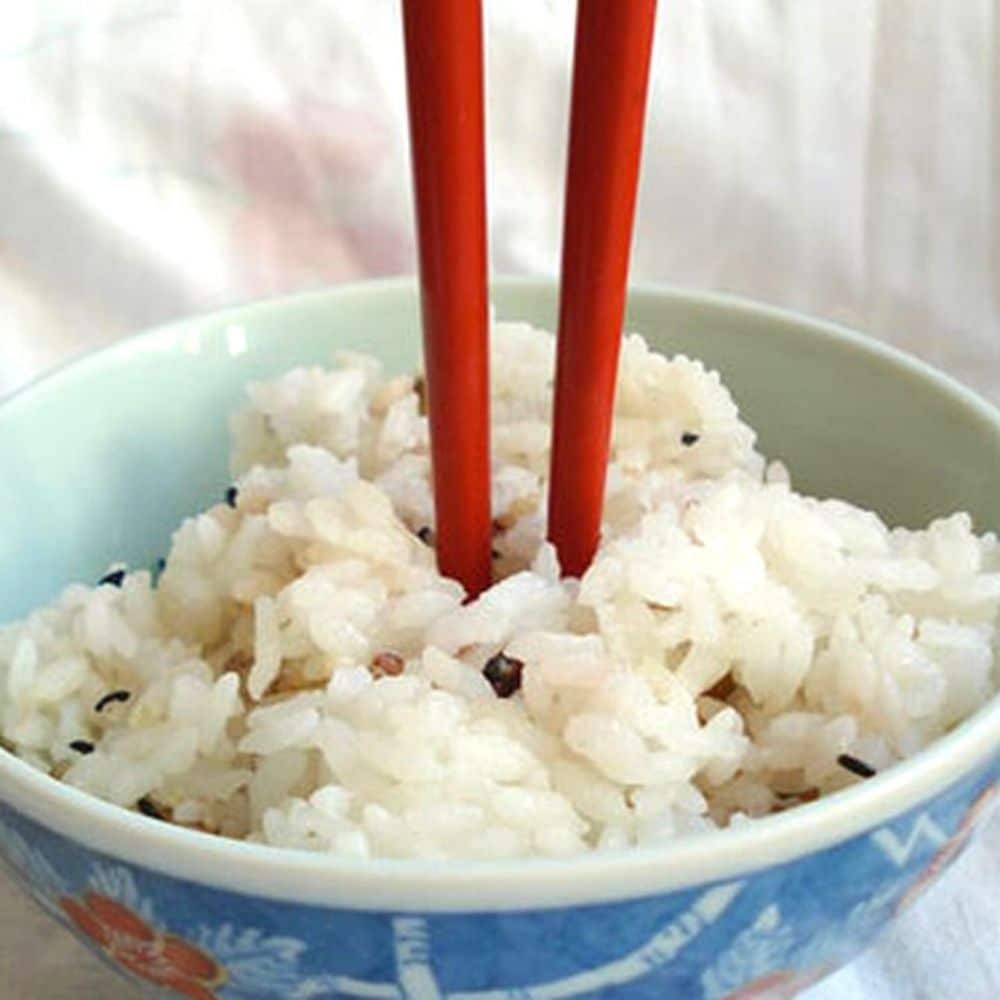
A definite Korean cultural taboo is sticking chopsticks upright in a bowl of rice. This action looks similar to incense sticks in funeral ceremonies and symbolises death. As with writing in red ink, this makes people think of death and is considered bad luck.
This applies to other countries where Buddhism is prevalent as it’s a Buddhist ceremony. Although Korea isn’t a predominantly Buddhist country, it’s still a superstitious one and upholds these beliefs. To avoid disrespect when eating, rest chopsticks on a napkin or bowl.
6: Pointing With A Finger
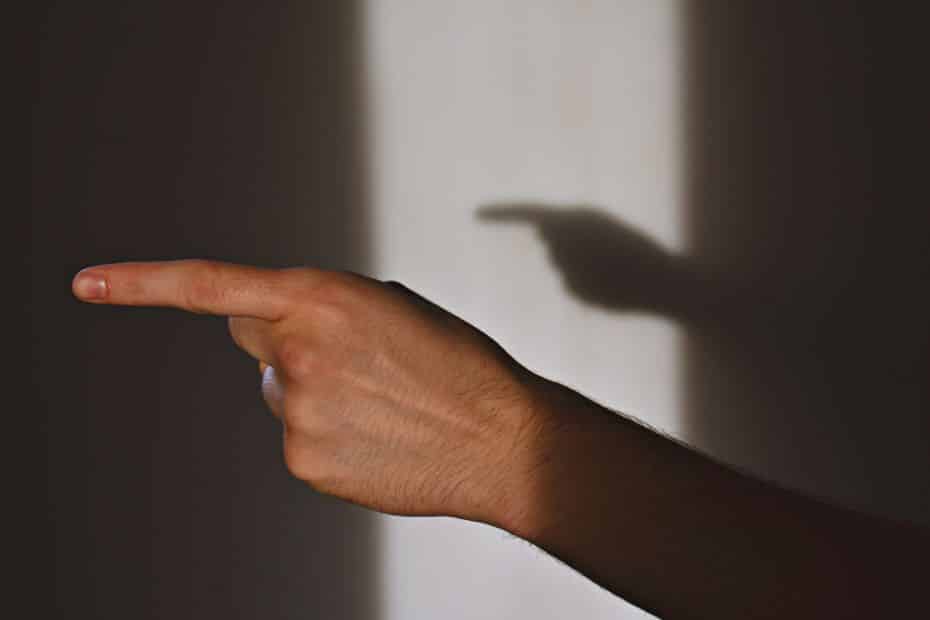
When gesturing in Korea, it is considered bad manners to point with one finger, especially the index finger. Instead, Koreans tend to use the whole hand when gesturing or motioning towards something.
To call someone’s attention in Korea, use the whole hand, palm face up. Bring the whole hand up as if clapping. Don’t use one finger. This is the opposite of what’s usual in Western countries where the palm is face down.
The middle finger is seen as rude, especially when stuck straight up at someone, just as it is in other countries such as the USA and UK.
7: The Number 4 Is Considered Bad Luck
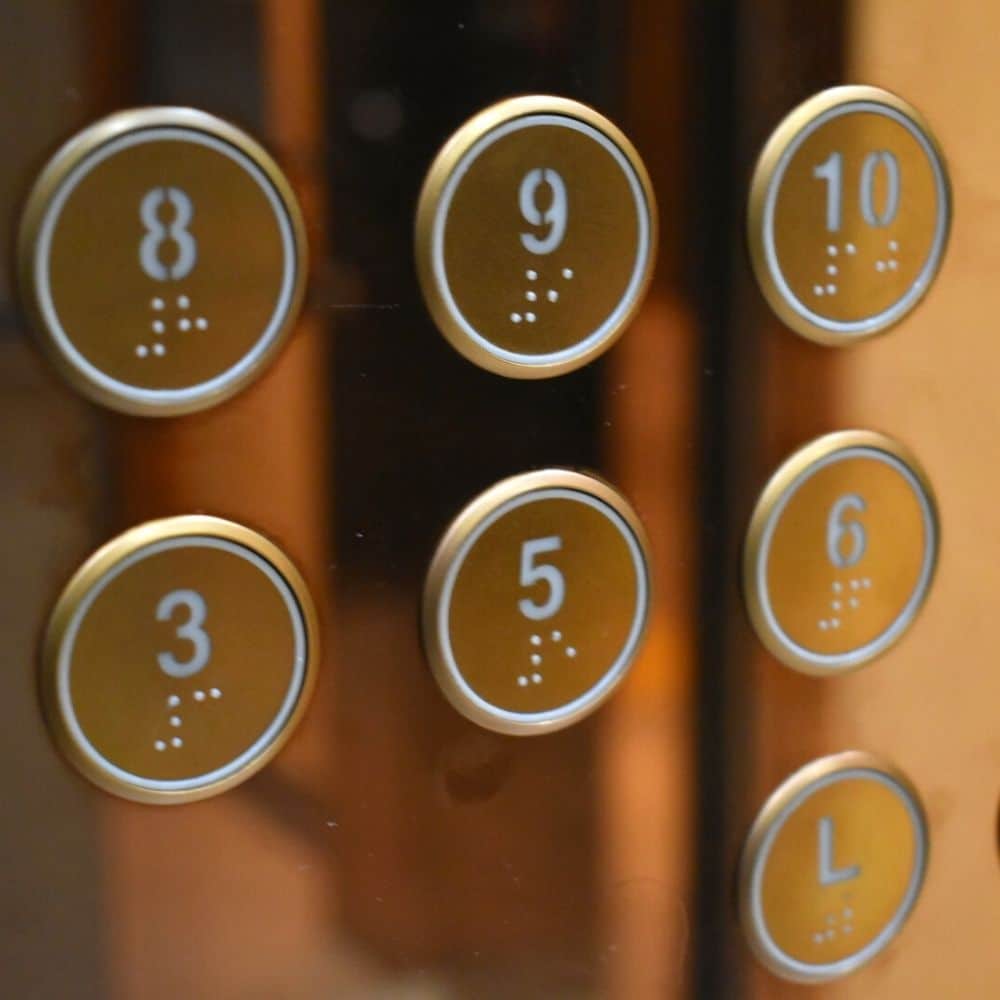
The number 4 is an unlucky number in Korea, just as 13 is in English speaking countries. Known as tetraphobia , the issue is serious in Korea. Koreans will go out of their way to avoid using the number, including removing the number 4 from elevators, restaurant tables, and even whole apartment blocks.
The Korean superstition surrounding the number 4 originates from the sound made when saying ‘four’. This word sounds the same as the word for ‘death’. In Korean they are both pronounced as ‘ sa ‘.
This is an issue in several countries, including China and Japan, as they use the same Chinese characters for these two words.
You won’t upset or embarrass anyone by writing the number 4. It’s an unavoidable number. Being aware of this fact helps you understand Korean culture.
8: Saying No When Asked To Do Something
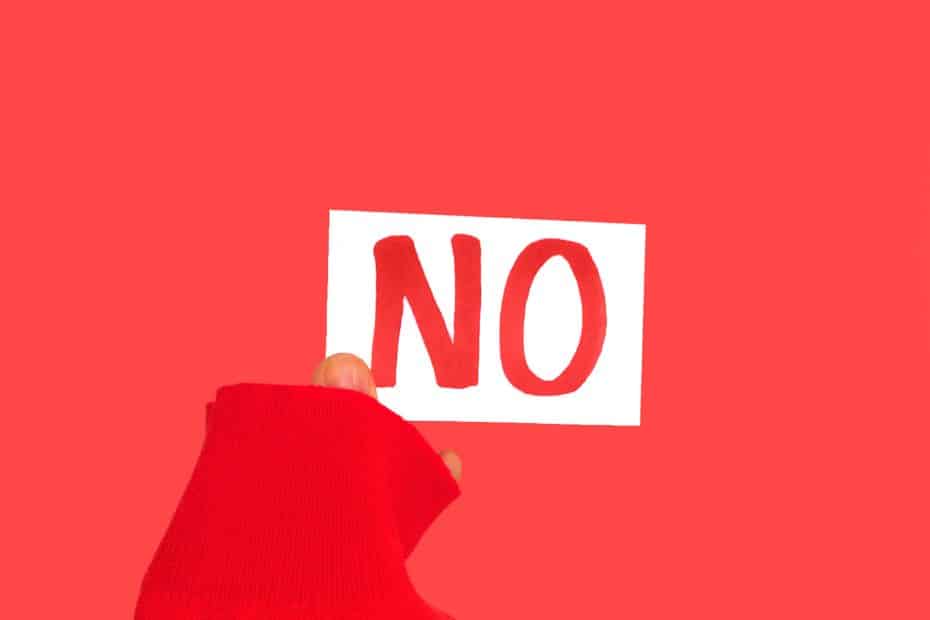
When someone in Korea asks you to do something, it is considered rude to say no. For example, if a friend invites you to their house, or to go to an event, it’s bad manners to refuse. This doesn’t mean that it is necessary to agree to do everything that someone asks, but consideration should be made about how to turn down an offer. An excuse or false agreement is better than a straight up refusal.
This issue is rooted in a subtle aspect of Korean culture known as kibun , which has no English translation, but generally refers to someone’s sense of pride or face. By refusing to agree to something, you damage their kibun and damage the group harmony. Korean people want to avoid that, so they try to agree or find ways to get out of a difficult situation without saying no directly.
There are Korean cultural insights that will help explain this issue later on, including the concept of kibun and how Korean society operates harmoniously. Keep reading to find out more about these and other Korean etiquette rules, customs, and manners.
As a visitor to Korea, don’t feel obliged to say yes to everything. If you have to say no, try to help the other person save face if possible. Likewise, try not to pressure people into agreeing to do something. They may find it impossible to refuse.
Korean Etiquette Rules When Dining Out
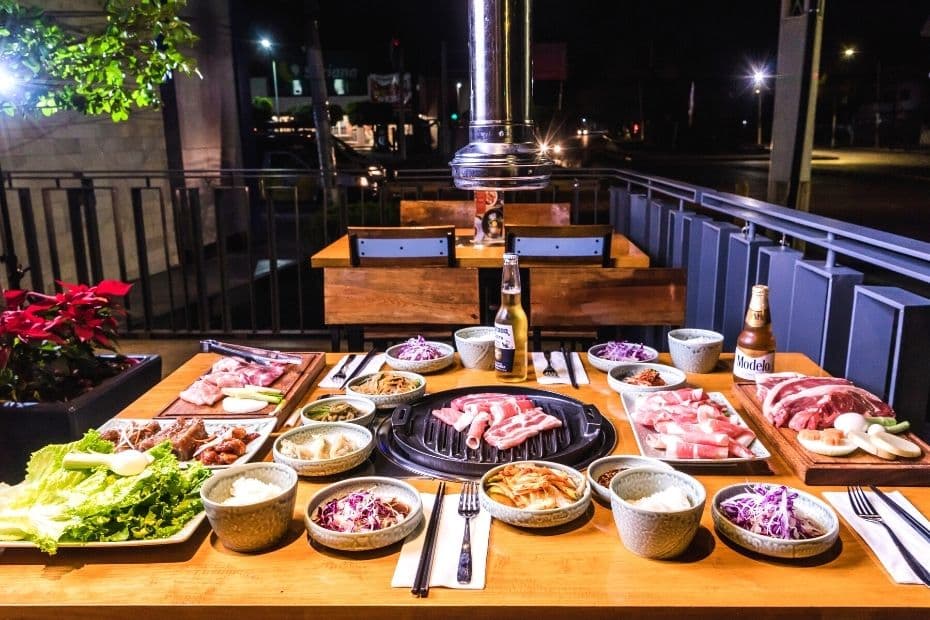
This next section introduces some important Korean etiquette rules when dining out that will help you if you plan to eat out with Korean friends both in your own country and in Korea.
Several of these rules are common sense or manners, such as not pointing with cutlery, others might seem a bit strange or confusing. Understanding the cultural reasons behind these rules can help make your Korean dining experience more comfortable.
When you’re travelling and eating out with other foreigners, don’t worry too much about these rules. These are guidelines for eating with Koreans and not being rude.If you’re worried about what to say when dining, check out my guide to Korean phrases for eating out . You can find out how to order food, how to talk about what you like and don’t like, how to pay, and lots more.
9: Take Your Shoes Off In Restaurants
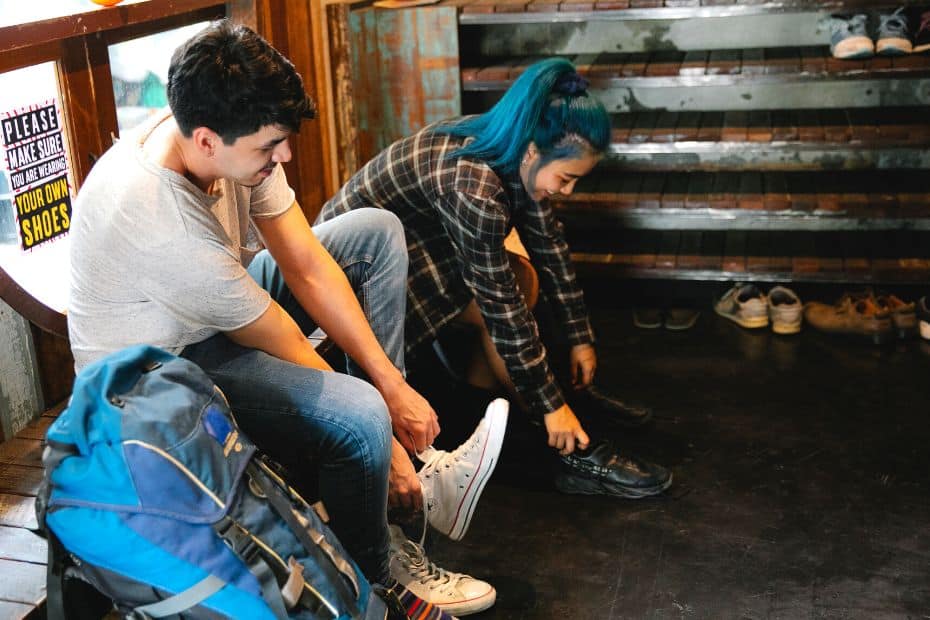
It’s bad Korean etiquette to enter a Korean restaurant and walk around with shoes on. It is required to remove them when entering a restaurant and then either walk around in socks, or else slippers will be provided.
The main reason to remove shoes is because traditional restaurants have low tables and people sit on the floor. As everyone sits close together with their feet under the table, this will be uncomfortable and bother others. The other reason to remove shoes is to avoid getting dirt everywhere.
When someone needs to use the bathroom in Korea , there will be a special pair of bathroom slippers they can use so they don’t need to put on their shoes again. Don’t forget to take off the bathroom slippers when leaving the toilet or it’ll certainly cause an unforgettable scene in the restaurant.
This is only common in traditional Korean restaurants and other restaurants let you keep your shoes on. You will only need to take your shoes off in traditional cafes in hanok houses, too.
10: Help Others Before You Help Yourself
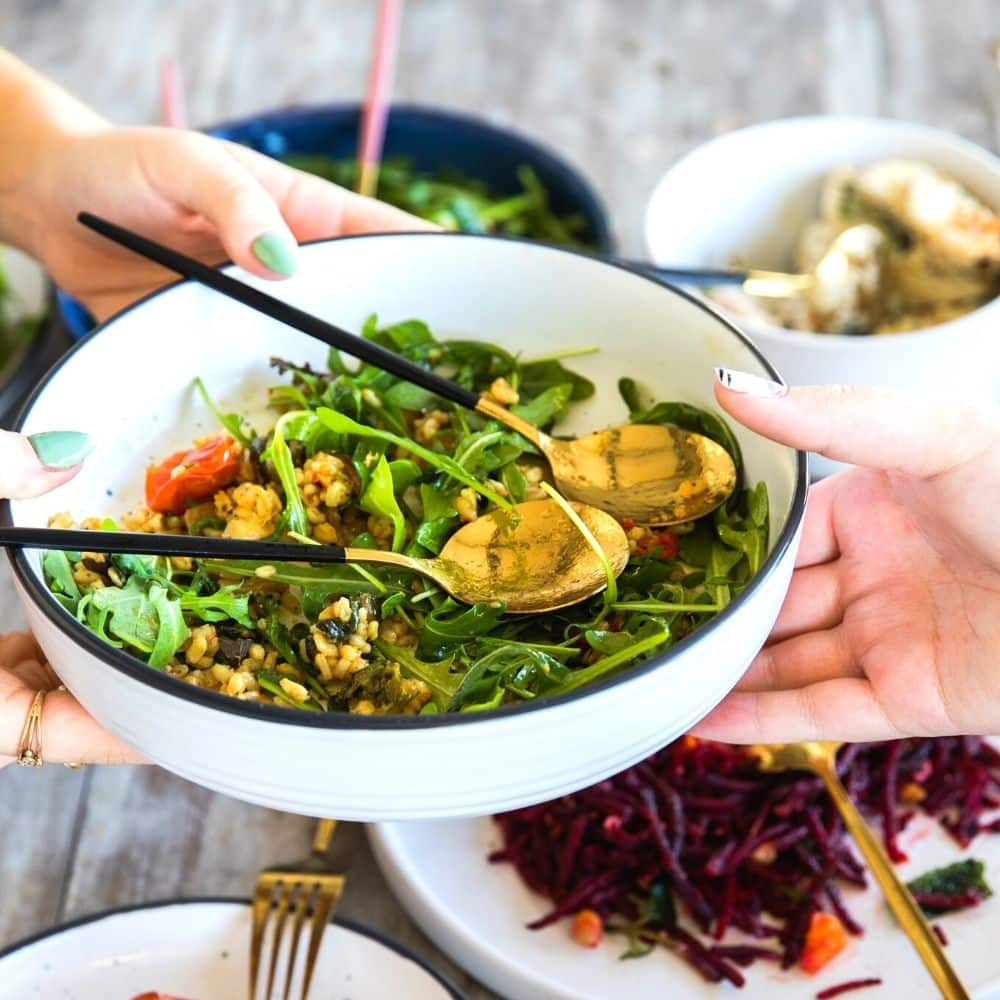
This Korean etiquette rule applies to a couple of things when eating out. First, one person at the table will give out the cutlery (chopsticks and spoon) to other people at the table, serving themselves last. This is usually the youngest person at a work dinner.
The cutlery in Korean restaurants is placed in a box on the table, or in a draw on the side of the table, along with napkins and wet tissues. Place a napkin on the table and then place the cutlery on top to keep the cutlery clean.
The second meaning of this rule is when serving food and drinks. Offer other people food and drinks before yourself. This is especially important in a work setting when dining with senior members of a company or with older relatives.
11: Wait For Elders To Be Seated First
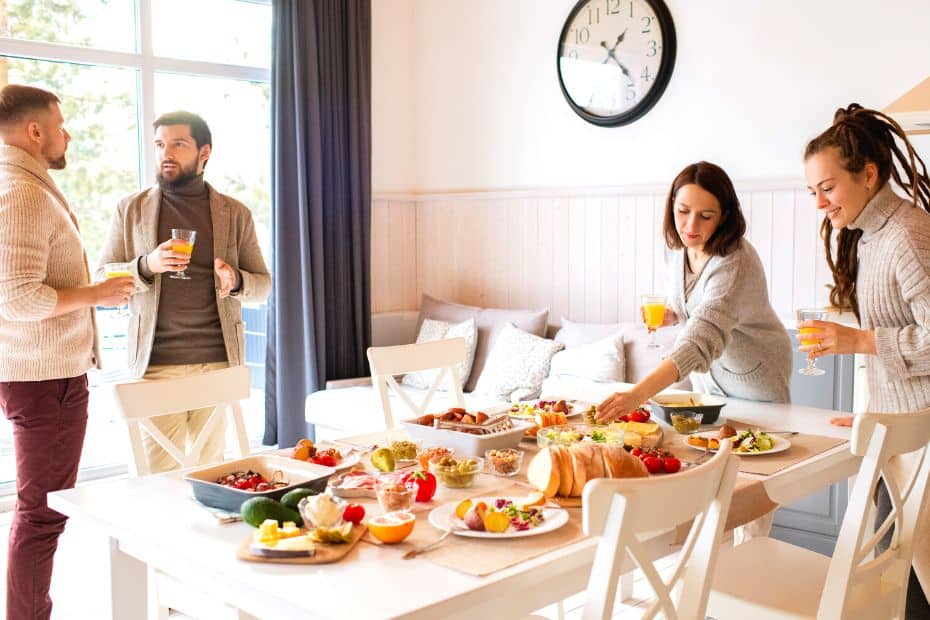
Similar to the previous Korean etiquette rule, it is considered rude to sit down before the more senior or elderly members of the group have been seated.
The senior people will typically take the central area of a table, with less senior members spreading out to the sides. When foreigners join Korean work parties, they may be offered a place in the centre alongside the senior members. This is a sign of respect.
At work events, this means standing near the table and waiting for the senior members of the team to arrive before sitting. Once they arrive, everyone will take their seats.
Korean employees may attend meals early so they can show their enthusiasm by waiting for the boss. This is generally better than turning up late, which could be considered rude.
This only applies in formal situations. If you’re eating lunch with a friend, you don’t need to wait for them to sit first if they’re older than you.
12: Don’t Eat With Your Fingers Or Lick Them
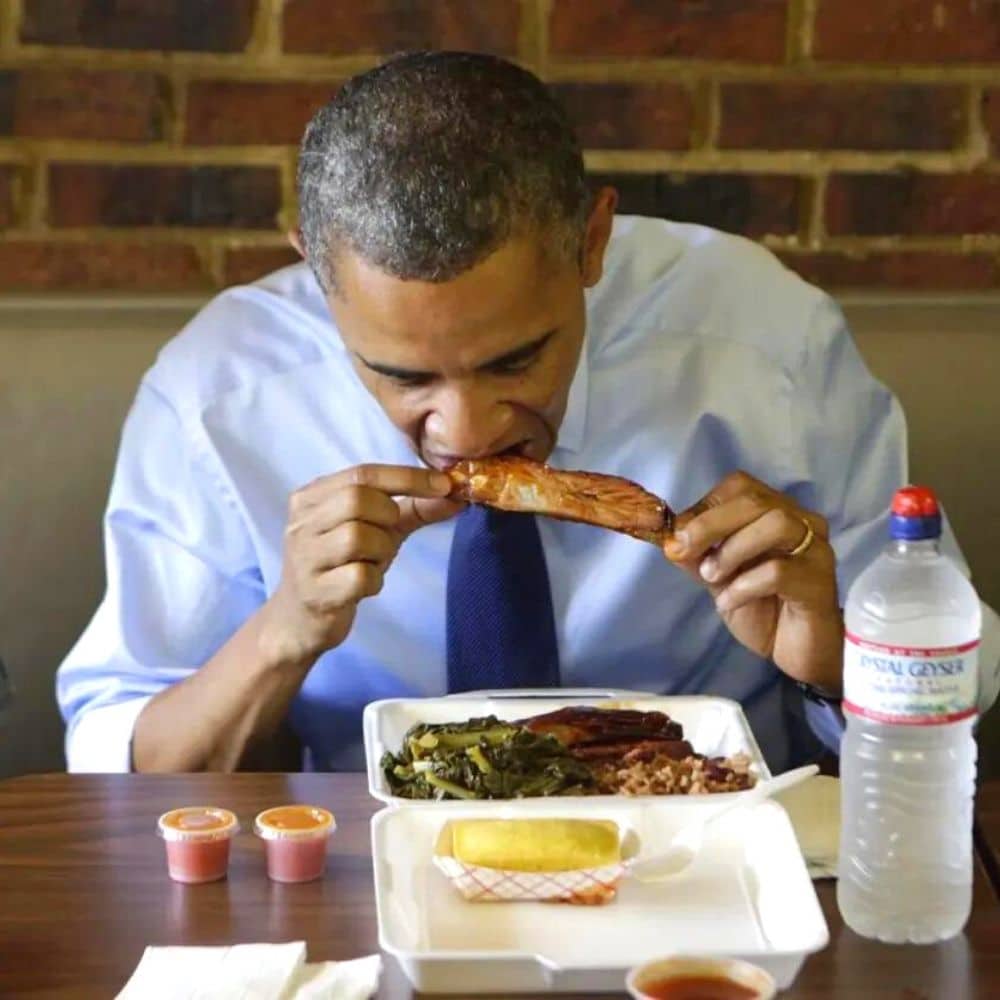
Using fingers to eat in Korea is bad manners and chopsticks or other cutlery should be used whenever possible. This applies for difficult to eat foods such as chicken wings, ribs, and pork cutlets. This also applies to Korean side dishes , which are called banchan . They’re not finger food.
These foods should be cut up or taken apart when possible, which is a difficult task for people not used to using chopsticks to eat. Fortunately, most Korean meals involve small portions that can be picked up and eaten using chopsticks, as well as sticky rice.
Licking fingers is considered bad manners in Korea and it should be avoided when possible, especially when eating in public. There are wet or dry tissues for cleaning dirty hands and fingers. Tissues can also be used to hide leftover bones, which is politer than leaving them on a plate or table.
I t’s almost impossible to eat traditional Korean dishes like samgyeopsal (Korean BBQ) without using your fingers. You don’t need to use chopsticks for foods that involve wrapping things in leaves or Western foods such as hamburgers, which you definitely can’t eat with chopsticks.
13: Don’t Point With Your Chopsticks

Chopsticks are very flexible and can be used to eat a wide range of food with a bit of practice. However, there are some things definitely shouldn’t be done with chopsticks, including the aforementioned taboo of sticking them upright in rice.
Using chopsticks to point at other people is considered rude in Korea and should be avoided. When eating with chopsticks, try to keep them pointed downwards or place them on a plate, bowl, or napkin on the table.
Try to avoid gesticulating wildly with chopsticks when eating. The same rule applies when talking closely with someone else, don’t wave your arms around too much as this is considered rude and disrespecting someone’s personal space.
14: Use Two Hands When Pouring Drinks For Others
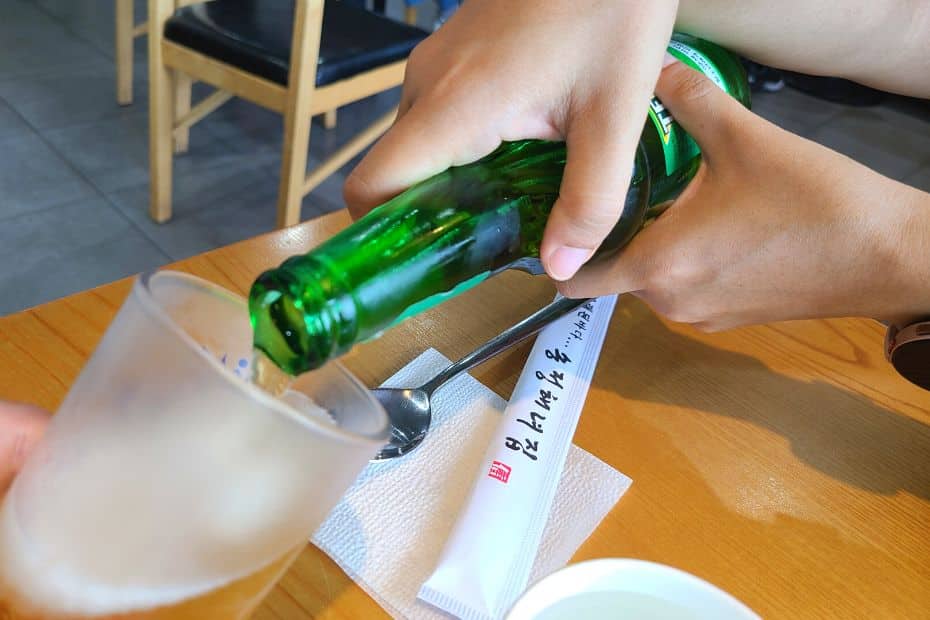
When pouring drinks for others, pour with two hands. As with shaking hands, the second hand can be placed on the pouring hand, wrist, arm, or under the arm on the waist.
This is another uniquely Korean etiquette rule that probably originated at the same time as the rule for shaking with two hands. If both hands are visible, one can’t be used to conceal anything dangerous.
15: Don’t Pour Your Own Drinks
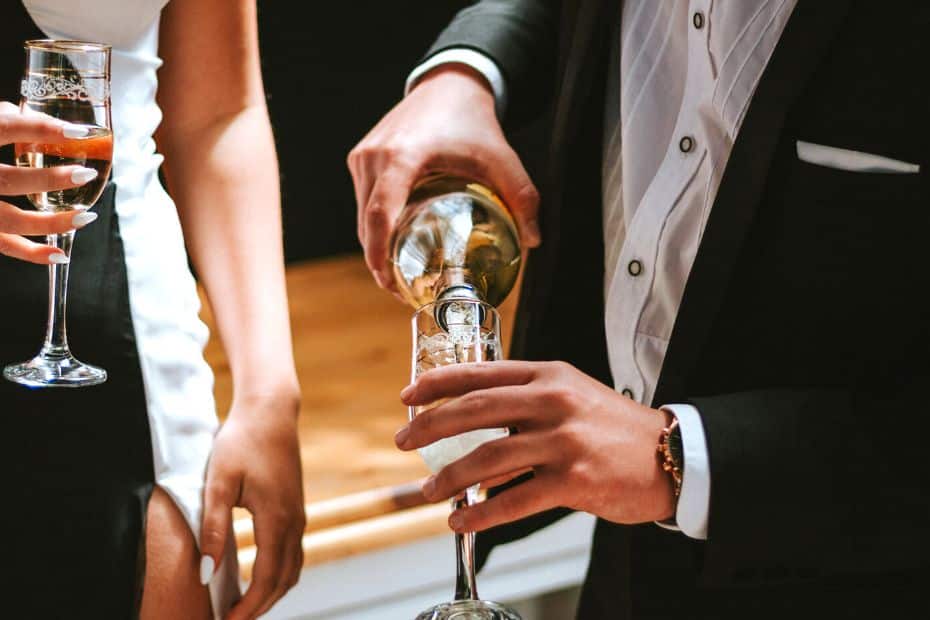
As well as pouring drinks with two hands, Korean etiquette states that you shouldn’t pour drinks for yourself. When out with other people, pour their drinks first and then they will return the favour.
Korean work meals typically involve beer and soju. This involves a lot of pouring during the evening and it is common for people to move around the room pouring drinks (usually soju) for other people. The other person will pour a shot of soju for them in return.
This causes a socially harmonious situation where everyone is offering and accepting drinks from each other and is a key part of a Korean work dinner. This can also happen in social occasions, but with less pressure to impress others.
It is said that pouring your own drinks will result in bad luck. This probably helps reinforce that other people should be pouring for you and not to be selfish by pouring your own drinks.
16: Look Away When Drinking A Shot
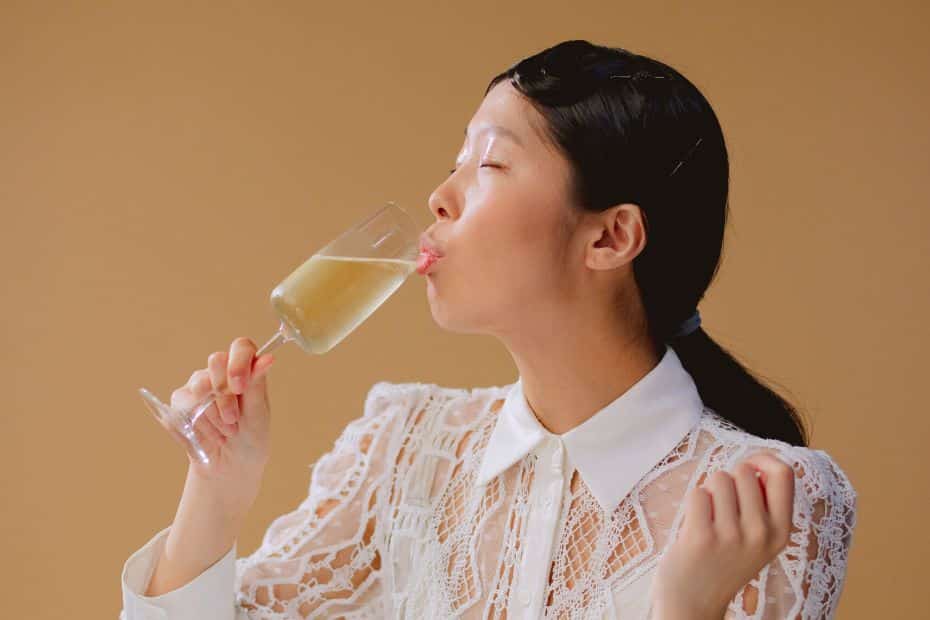
During work and social events, it is common to make a toast and drink a shot of soju or glass of beer. It is bad manners in Korea to look at other people as you down your shot or beer. The polite way to drink a shot is to turn your face away and drink, then turn back to look at everyone. Staring at someone when drinking is bad manners.
Covering your mouth when drinking in Korea is also considered polite, although it is not as commonly practised as turning away. Drinking from a bottle without it touching your lips, letting it drop into your mouth, is also common in Korea to avoid germs.
17: Clean Up Your Own Mess
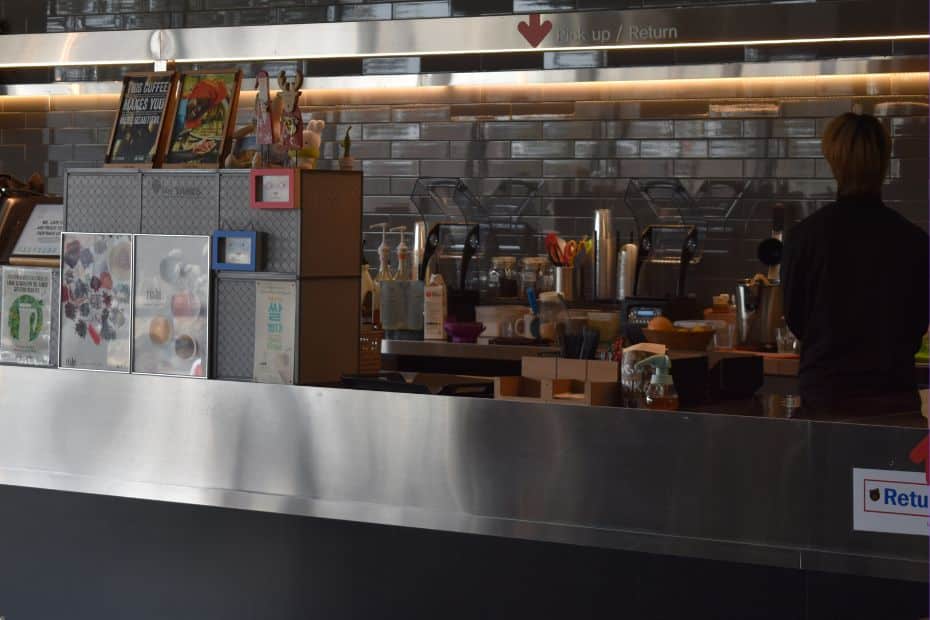
At restaurants and cafes in Korea, it is common to clear away your own cups and plates when finished. There is usually a ‘return’ area near the main counter or food delivery area, or a separate counter with recycling and trash.
In cafes, it is normal to return used cups and empty any remaining liquids into a special bin, as well as split different items by material type (plastic / paper). Mugs and glasses can be left in the same area.
If a Korean restaurant offers table service, you don’t need to clean away your own plates. If you have to go up to a counter to order and pay, you might be expected to clean up.
Having to clear your plates away is one of the reasons you shouldn’t tip in Korea, which is the topic of the next part of this Korean etiquette guide.
This rule mostly applies to small restaurants, fast food chains, and cafes. If you’re out for a meal like Korean BBQ or something that involves lots of dishes, just leave them where they are.
Should You Tip In Korea?
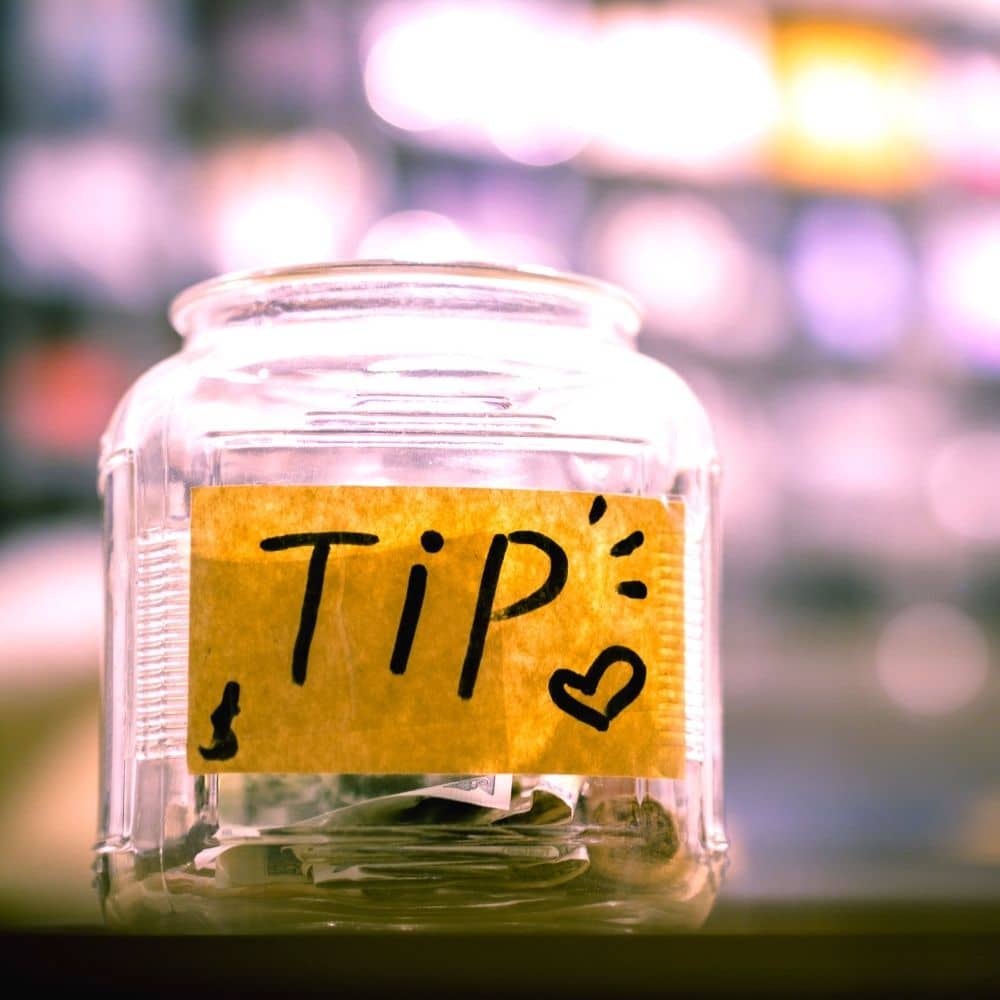
One question many people ask when travelling to Korea is should you tip? In some countries it’s quite common, but in Korea tipping is not customary at all. Tipping in Korean restaurants and cafes doesn’t happen and there are usually no options to leave a tip.
The price on a menu is the price you’re expected to pay. Tax is included and won’t be added later. It’s not common to see tip jars in Korea, although some bars and independent cafes may have them near the till.
Why don’t people tip in Korea? There are a few cultural reasons why tipping isn’t common. Firstly, it never entered into society and people aren’t used to paying more than the price stated. Prices include staffing costs and therefore tips aren’t necessary.
Providing good service is part of maintaining social harmony and being rude to customers would result in people losing face and society not following its core Confucian ideals. Therefore, there should be no need to tip for good service as it’s always provided.
Indeed, tipping one person would require tipping others, or else societal disharmony may occur. Tipping everyone isn’t practical, so the best option is not to tip at all.
Should you tip in Korea? No.
Leaving a tip in a Korean restaurant can result in the money being returned or awkwardness for the person receiving the tip. Avoiding awkwardness in Korean society is going to be more valuable than a tip.
If you live in Korea and want to thank someone for providing a service, like installing a washing machine or fixing your computer at work, small gifts are usually given. Small gifts include a baked good, a bottle of juice, and things like that.
In my experience, it’s not worth trying to leave a tip in Korean restaurants. Even saying ‘keep the change’ is met with confused stares and demands to take money back. I’ve had staff leave the restaurant and catch me on the street to return tiny sums that have been overpaid. It might be culturally strange to you, but try to adapt to local customs when visiting to Korea.
When Can You Tip In Korea?
Despite tipping generally being avoided in Korea, there are times when tipping is allowed. Upmarket restaurants and hotels will sometimes add a service charge when dining or drinking there. This is a mandatory ‘tip’ rather than an accepted gratuity.
The other time when tipping is acceptable in Korea is when someone provides a personal service, such as a tour guide. Tour guides, who are used to working with foreigners, are often happy to accept tips and giving them a tip can really help them.
If you’re not sure if a tour guide accepts tips, you can ask them. Try to be discrete and wait until the end of the tour before approaching the subject of tipping.
Socialising Culture & Etiquette In Korea
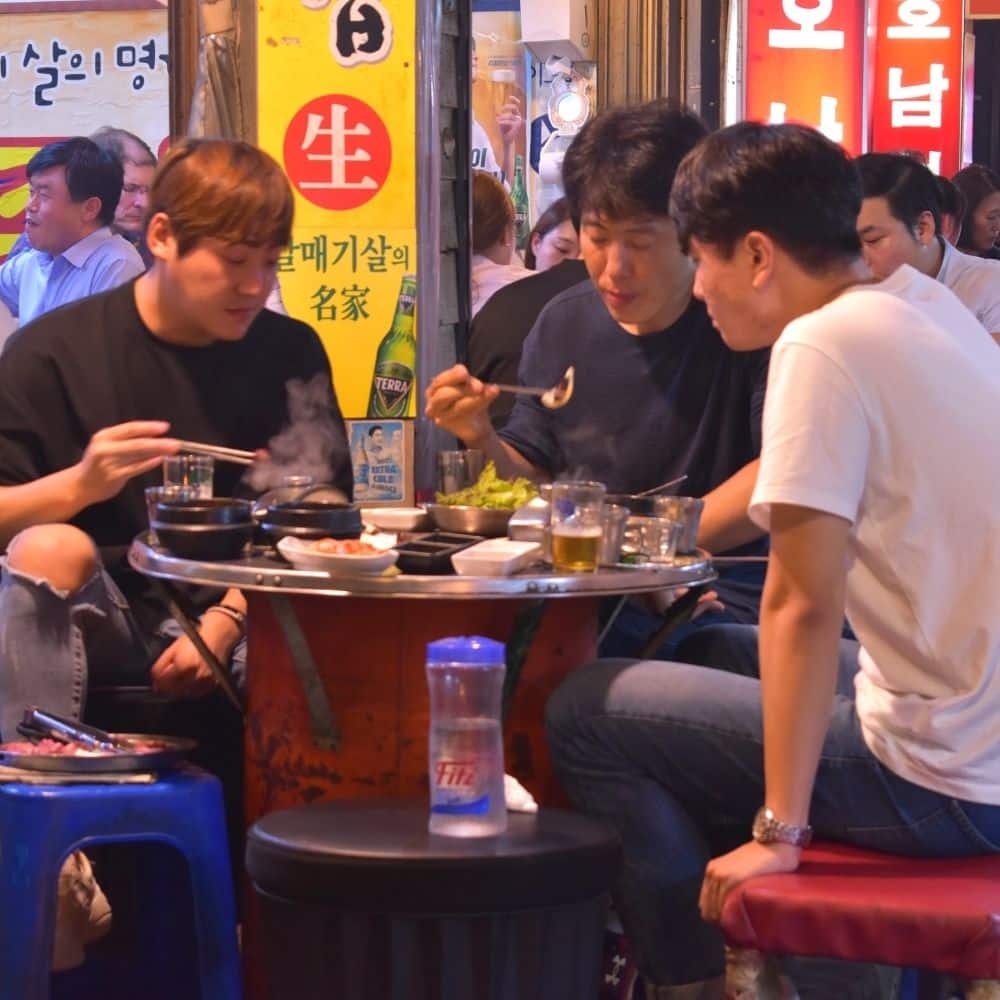
Want to feel comfortable when socialising with friends in Korea? Want to avoid making other people embarrassed and uncomfortable when you go out together or visit their home?
These Korean etiquette rules for socialising will show you how to make friends in Korea and avoid upsetting others. A good first impression will certainly go a long way to breaking down cultural barriers and showing the other person you understand their culture.
These rules are a bit more relaxed than what you’d expect to find in a professional setting, such as an office, or when meeting someone’s family. In reality, these rules could be completely ignored by some Korean people, typically the younger generations, but it never hurts to be prepared and err on the side of caution when in a new culture.
18: Avoid Personal Names Until Introduced

When meeting someone for the first time, it’s best to refer to them by their title (doctor, teacher, etc.) or their family name (Mr. Kim, Mrs. Song, etc.) Using someone’s first name shows a familiarity with that person that could be considered rude.
Using a professional title is a sign of respect and, traditionally, professionals such as teachers and doctors were well respected members of society. This isn’t so applicable when greeting a tour guide or hotel employee, or even a friend you met online.
The safest option when meeting someone in Korea is to use their formal title or full name until they’ve used your personal name or you feel it’s safe to call them by their first name. When you’ve been introduced, you should be familiar enough to use first names.
This rule is found in other countries and is typically more of a personal preference. Some people are comfortable with others using their first names, others aren’t. Ask if you’re not sure.
19: Bow Or Shake Hands To Greet People
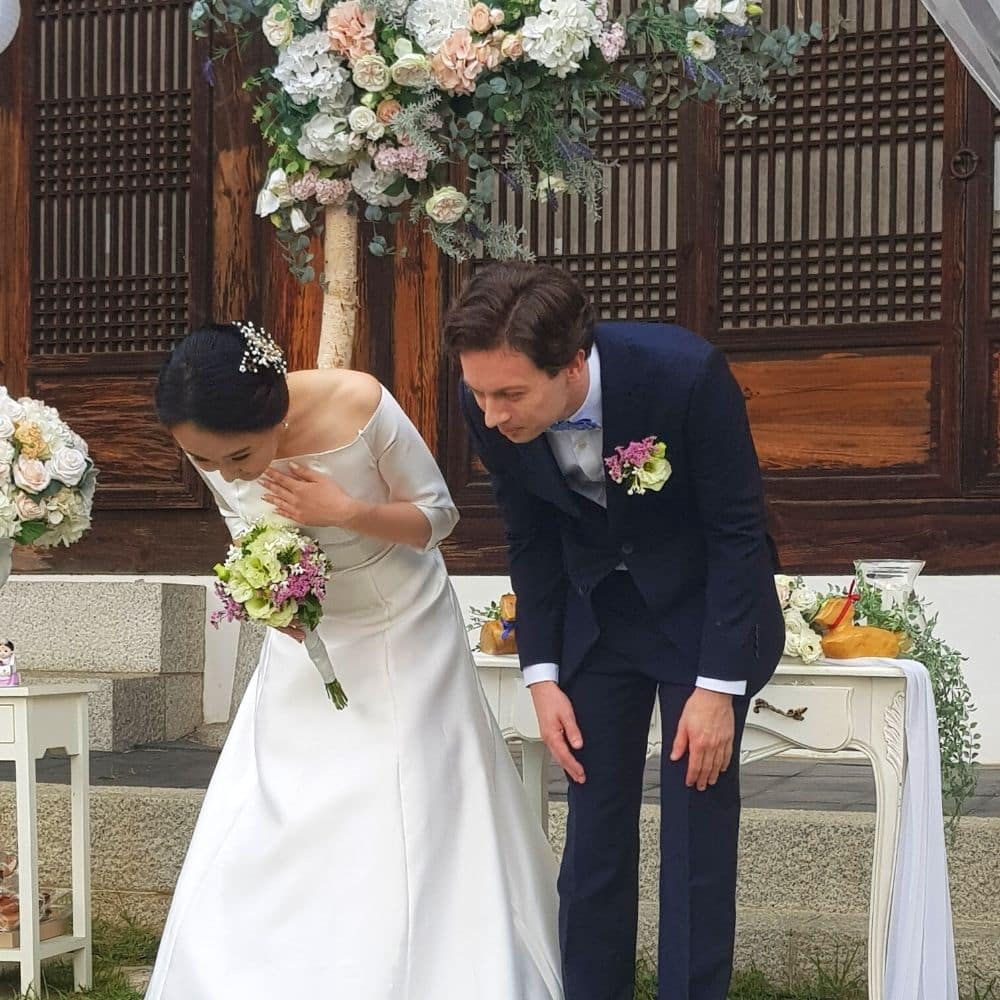
To make a good first impression in Korea, give a two-handed hand shake or a small bow. A bow is a safe option for greeting strangers and is practical when greeting lots of people at once. A deep bow is not necessary when greeting people, a small tip forward is enough.
When socialising with Korean friends, a hand shake is a more comfortable option and shows friendliness. A bow is also fine, especially when holding things. If in doubt, let the Korean person make the first move so you know what they’re comfortable with.
20: Avoid Close Physical Contact
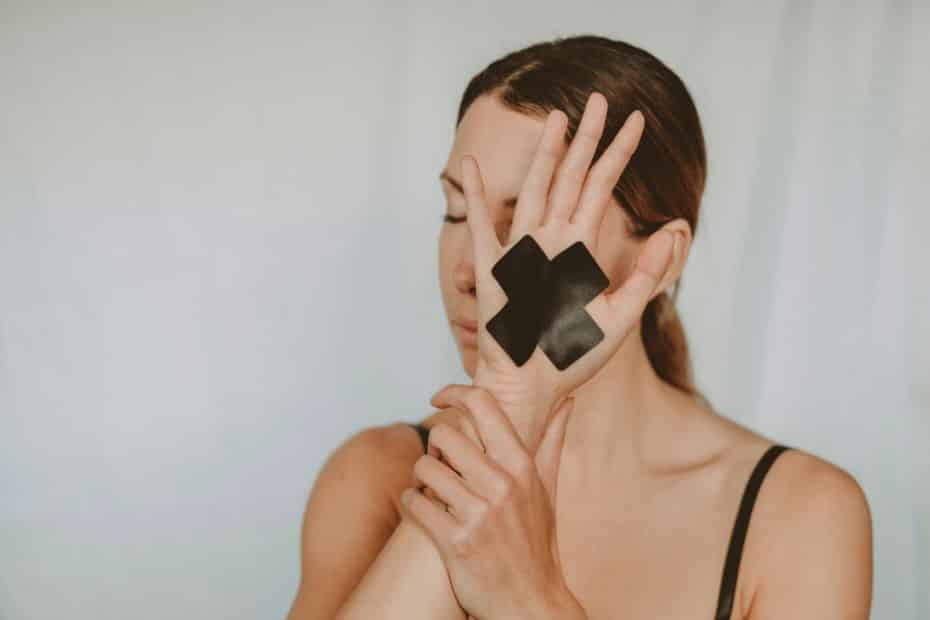
Handshakes and bows are acceptable greetings, but greeting someone with close physical contact, such as hugging or grabbing hands or arms, is bad Korean etiquette.
Hugging strangers is certainly bad manners in Korea and will most likely make the other person extremely uncomfortable, especially when in public. Close physical contact is generally reserved for friends and family.
Once you’ve become friends with someone in Korea, you can set your own boundaries. If you’re both comfortable hugging or other close physical contact, then it’s fine. Close physical contact between couples is a bit different and will be discussed later.
Close physical contact between people of the same gender is normal in Korea and you often see women walking around hand in hand or a teenage boy sitting on another boy’s lap. In a Korean sauna, boys will scrub their father’s backs and vice versa.
21: Respect Other People’s Personal Space

Similar to avoiding close physical contact when in Korea, it’s also good manners to respect other people’s personal space. This means not standing too close to them, waving your arms around near others, or generally moving your body in a way that could make others uncomfortable.
For example, if you’re socialising with Korean friends, don’t keep touching someone’s shoulder or waving your arms around in front of them. Korean people generally wouldn’t do it unless very close to another person as it could cause them to lose face.
Due to traditional Korean societal norms, which will be explained in more detail later, invading someone’s personal space not only embarrasses that person, it could also cause disharmony in the group and result in an uncomfortable situation.
This etiquette rule is (or should be) common in most countries and you should always respect other people’s personal space. Etiquette rules tend to be broken when lots of soju has been consumed.
22: Bring A Gift When Invited To Someone’s House
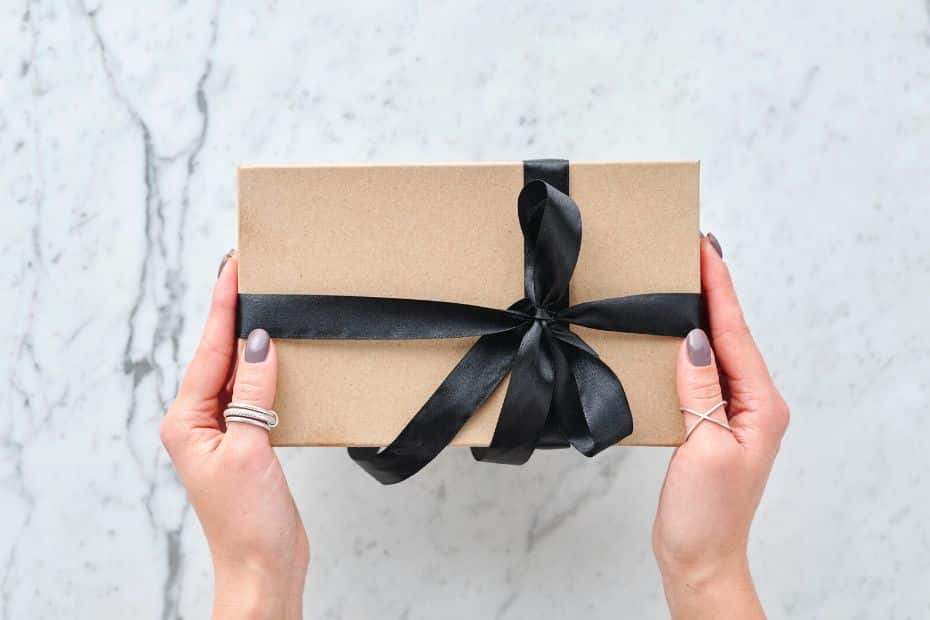
When someone is invited to a Korean person’s home, it’s good manners to bring a gift for the host. This is a sign of respect and gratitude to the person for being invited to their personal place. Bringing a gift will help you make friends and will please the host.
Good gifts for visiting someone’s house in Korea include baked goods, sweet treats, or a small bouquet of flowers. Something that can be used at that time is generally acceptable. Don’t spend too much, however, as this places a social burden on the other person. Wrapping is always welcome.
Check out the gift giving section at the end of this article to learn customs and etiquette rules that will help you choose the right gift and give it correctly.
23: Give And Receive With Two Hands
Giving and receiving gifts in Korea should be done with two hands. Present the gift to the other person, extending it forward and wait for the other person to accept it.
In Korea, it’s considered impolite to open the gift in front of the gift giver, so don’t be surprised if they place it somewhere out of sight or take it to another room to open. If the gift is something to be eaten right away, it’ll probably be taken to the kitchen so it can be served on a plate.
24: Remember To Return The Favour

A key concept of Korean culture is societal harmony. This is seen in many parts of Korean culture, including gift giving. If a Korean person receives a gift, especially in public, they feel obliged to return the favour.
If you want to show you understand Korean customs, return the favour and give a gift after someone gives you a gift. However, try not to spend more than they did, otherwise this places the burden back on the other person to buy yet another, more expensive gift.
You don’t need to give a gift back when someone buys you a birthday present or when you leave a job or in a similar situation. The idea is that you will pay forward your gratitude when other people have birthdays or someone leaves work. Weddings and funeral work in the same way.
Etiquette Rules When In Public
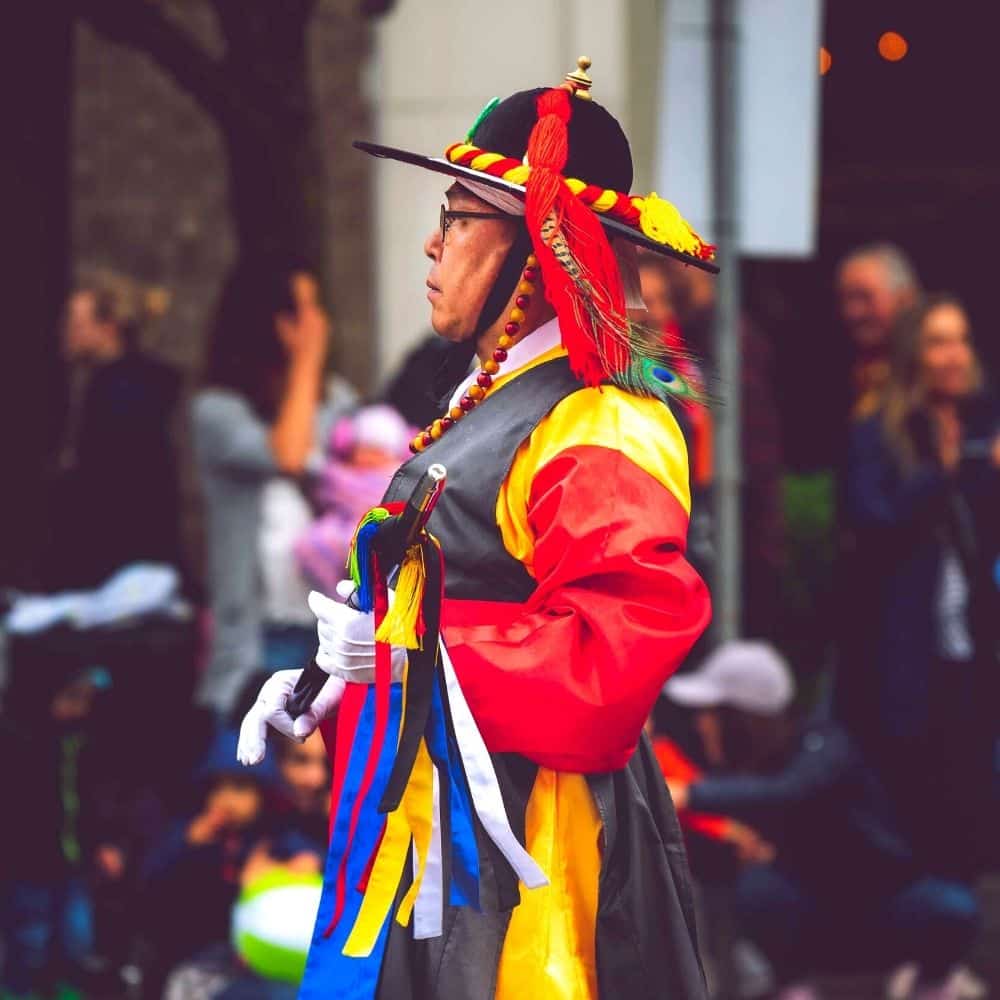
Worried about making cultural faux pas while out and about in the busy streets of Seoul? Want to know how to ride on public transport without upsetting anyone?
This next set of Korean etiquette rules will help you behave like a model member of Korean society when travelling and exploring in public. From public transport to public displays of affection, there are many areas where you’ll need to be careful in Korea.
As a foreigner, you won’t be expected to know these rules and Korean people will probably tolerate must culturally insensitive actions you take. But wouldn’t it be great to show that you understand and appreciate Korean culture by following these etiquette rules?
25: Don’t Take Reserved Seats On Public Transport
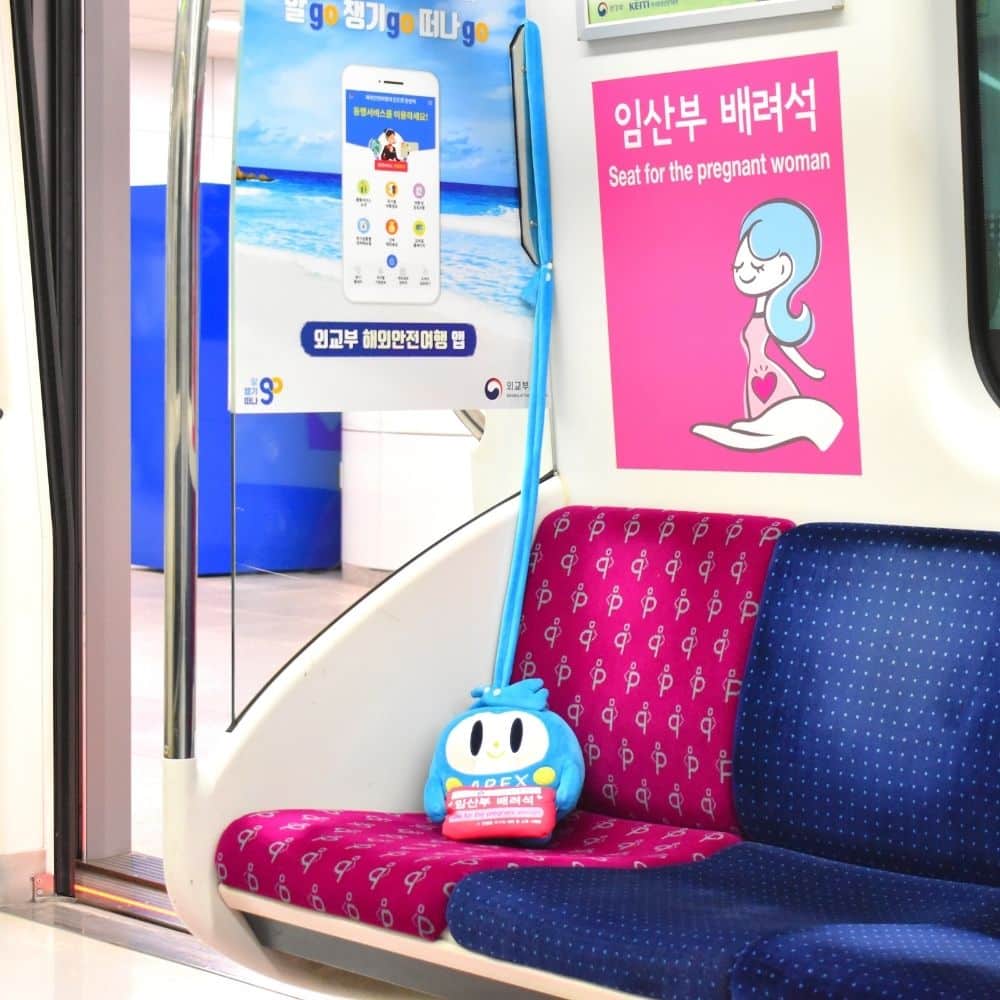
Korean subways and buses have reserved seats for people in need. It’s good manners to let people who need these seats take them. This includes the elderly, sick, young children, and pregnant women.
The end sections of subway carriages are reserved for travellers in need, while the seats closest to the door, as shown in the picture above, are reserved for pregnant women. On Korean buses, the reserved seats are usually brightly coloured.
Be respectful when you travel in Korea and avoid using these seats.
Don’t be surprised to see people sitting in the pink seats for pregnant women, especially during rush hour in Seoul. If you’re sitting in one, do the right thing and give it up for others.
26: Be Careful With Food And Drinks

When eating and drinking outdoors in Korea, be mindful of your actions. There are not many public bins in Korea and people are expected to carry their trash home with them.
You shouldn’t leave litter on the ground just because you can’t find a bin. This is true when hiking in Korea as there are no bins on the mountain paths. One of my top Korean Hiking Tips is to bring a small plastic bag for food trash. This tip applies when out in Korea, too.
Another important consideration when eating and drinking is to be careful when using public transport. Seoul recently made it illegal to eat and drink on public buses. It’s still legal on trains, but try to be courteous and avoid smelly foods and take your trash with you.
Korean society seems unusually tolerant of public waste. I often see big mountains of rubbish in entertainment areas and dozens of coffee cups placed at bus stops, on bins, and anything else that’s off the ground. Fortunately, street cleaning is quick and effective in Korea.
27: Don’t Walk While Eating Or Drinking

Another way to cause offence when in public in Korea is to eat or drink whilst walking. It is considered rude and people are advised to stay still or sit down when eating or drinking.
This makes sense when you consider the danger of doing multiple things at once in a busy country where people move around quickly. It’s easy to bump into people or make a mess when moving and eating.
This rule isn’t strictly followed and many Koreans drink iced coffees as they walk (even in winter). Try to avoid eating messy foods or drinking from glass bottles as you move around and you should be fine.
28: Avoid Public Displays Of Affection
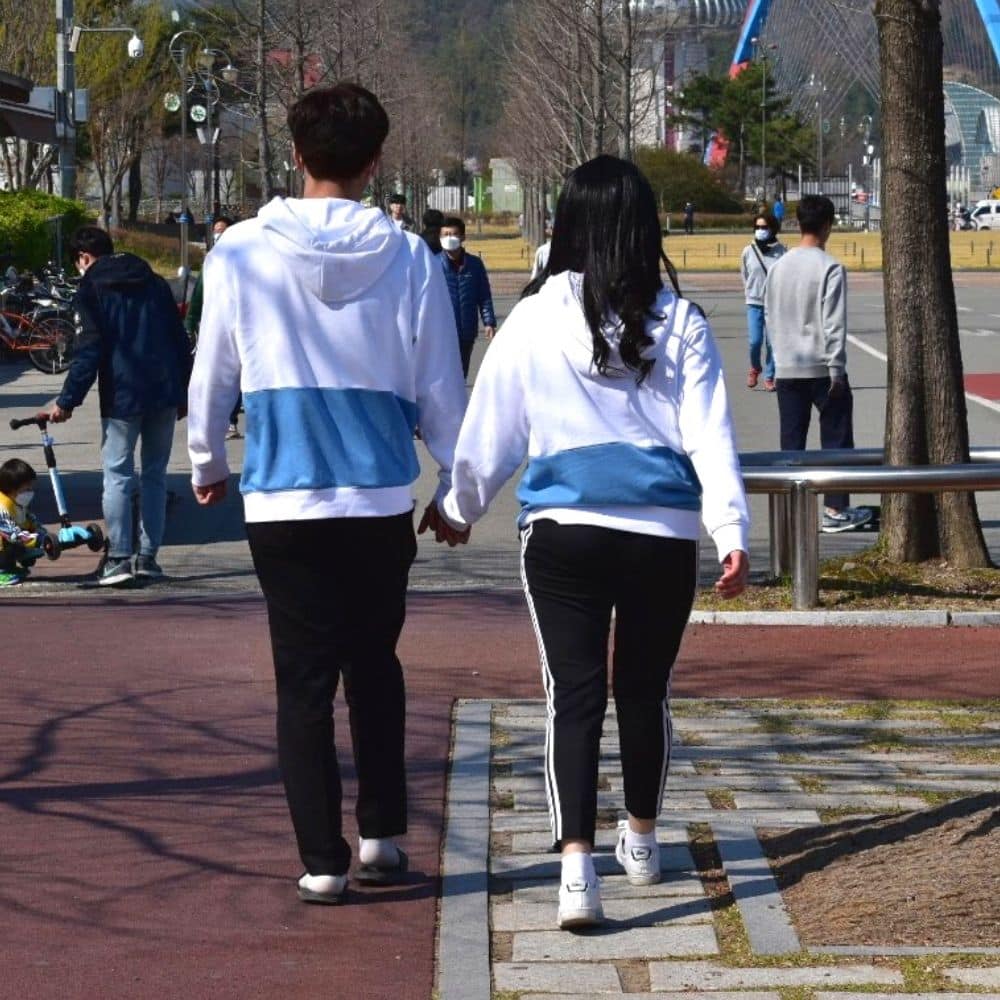
One of the Dangers Of Dating In Korea is that you can easily offend people by showing public displays of affection (PDA). Although not as strictly enforced as in some countries, public displays of affection such as kissing and hugging are frowned upon in Korea.
Korea is a conservative society and such displays will offend some people, older generations in particular. One way that couples get around this is by wearing couples clothing, showing that two people are in love enough to coordinate their clothing choices.
To avoid being rude in Korea, it is useful to know that public displays of affection can cause offence and upset some people. To show respect, try not to be too public with your shows of affection. Get some matching clothes for you and your partner instead.
This is definitely an issue for some people and I’ve personally been shouted at by older Korean guys for PDA offences. However, younger Koreans these days are a bit more open with their affection and you can see people kissing and hugging in public sometimes.
29: Don’t Blow Your Nose

Blowing your nose is considered rude in Korea, especially when done loudly and in public. Korean people tend to sniff a blocked nose instead of blowing it, even if that doesn’t actually solve the problem.
I’m not sure how this etiquette issue started, whether it is seen as unhygienic to blow your nose or if people never thought to carry a handkerchief with them for such emergencies and just got used to sniffing. It’s confusing as pocket tissues are sold in many places.
Whatever the case, from my experience, Korean people seem to be more comfortable sniffing instead of blowing and will look in disgust if you blow your nose, especially in a public place such as a restaurant or on public transport.
Korean people follow this etiquette rule and it’s more socially acceptable to constantly sniff than to blow your nose. Personally, I find it disgusting to loudly sniff repeatedly and will blow my nose in public in Korea. You might get some strange looks, but it’s a lot more comfortable.
30: Patience Is A Virtue And Queueing Is The Way
Korea is a polite society where pushing and shoving for your own benefit is considered rude and damages the harmony of society. Quietly queueing and waiting your turn is the norm in Korea and it is common to see organised lines waiting at subway, bus, and train stations, as well as in shops.
Trying to push ahead in a queue, or not waiting your turn is frowned upon in Korea. If you’re visiting Korea, it’s best to follow the example set by locals and be patient.
However, there is one big exception to this rule, which I’ll talk about next.
Ajummas : The Exception To The Etiquette Rules

You may have read these Korean etiquette rules and come to the conclusion that Korea is a wonderfully harmonious place where everyone is kind and polite in public.
While this is mostly the case for normal Koreans, there is one exception – the ajumma . Ajumma is the name given to middle-aged and above Korean women (typically over 50) who are the queens of Korean society.
After years of following strict etiquette rules and putting up with society, ajummas have earned the right to ignore the rules that keep society civilised and will instead push their way onto buses, shove you out of the way in a queue, talk loudly in public, and wear offensively bright clothing.
If you’re a fan of Korean dramas, you’ve no doubt seen plenty of ajummas before. Jean Yoon’s character in Kim’s Convenience is an ajumma (her name was Umma), albeit a bit more civilised than you might find in the wild.
Korea is definitely one of the safest and nicest places to be in public, but remember to beware the ajumma . Watch out for her colourful garb and keep a wide berth when possible. See the picture above for the identifying features of a Korean ajumma .
Korean Work Culture & Etiquette
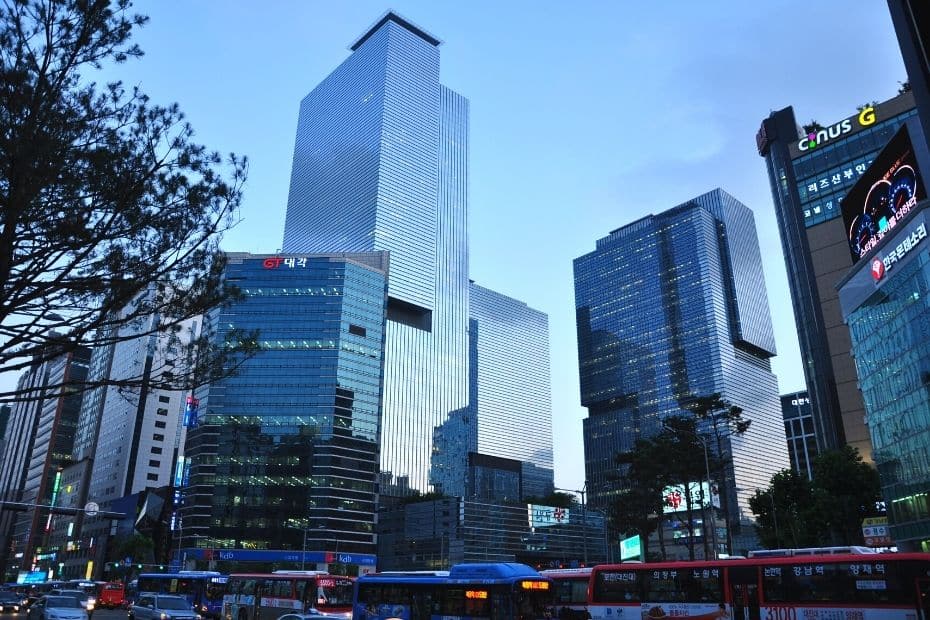
These final Korean etiquette rules and cultural insights are especially important if you’re travelling to Korea for business, or if you’re an expat in Korea like myself.
Understanding Korean etiquette and manners is perhaps more important in a business environment than when travelling as a tourist as the Korean business world is built on respect, hierarchy, and honesty. If you want to get ahead working or doing business in Korea, remember to show deference, especially to your seniors, and be friendly and honest to others.
Socialising outside of the office is a big part of work life, and many of the rules covered in the socialising section of this guide apply to business socialising, too. Often more strictly than in a purely social setting.
Read on to find out how to make a good impression at work in Korea and show you understand Korean work culture and etiquette.
31: Accept & Give Business Cards With Two Hands
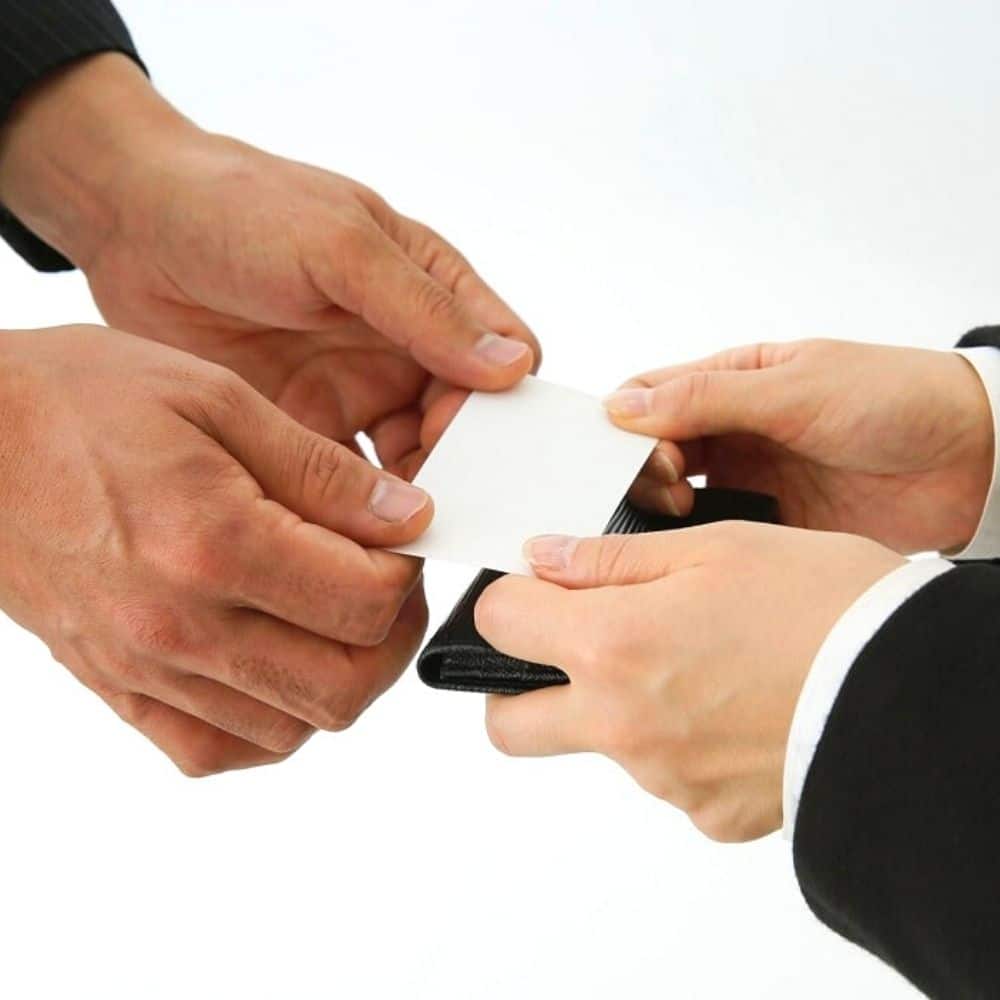
As mentioned several times before, it is best to give and receive with two hands in Korea, either with two hands at once, or with one hand resting on or under your arm.
With business cards in Korea, hold or receive the business card with both hands at the edge or the card and leave room for the other person to touch the other half of the card.
When given a business card, be sure to show respect to the card by looking at it and then treating it carefully. Don’t bend or dirty the card. Leave it on the table or place it in your wallet for safekeeping.
32: Use Formal Titles
Korean work places are traditionally very formal places where proper titles should be used, especially with senior members. Try to avoid using first names until someone has used yours, and even then stick to formal titles if the other person is your senior.
Full names, with the surname first, is the safest option if you don’t know someone’s formal title in a company. If you’re travelling to Korea for business, it might be worth learning a few titles for the people you are likely to deal with, such as ‘director’ or ‘manager’.
When sending emails, write your full name and refer to the other person by their full name, too. Try to avoid using just your first name as this might be seen as too casual.
This depends on where you work and the people in the organisation. For coworkers in a similar position, first names are usually OK. For management, formal titles are almost always used.
33: Wait For The Boss To Eat Or Drink
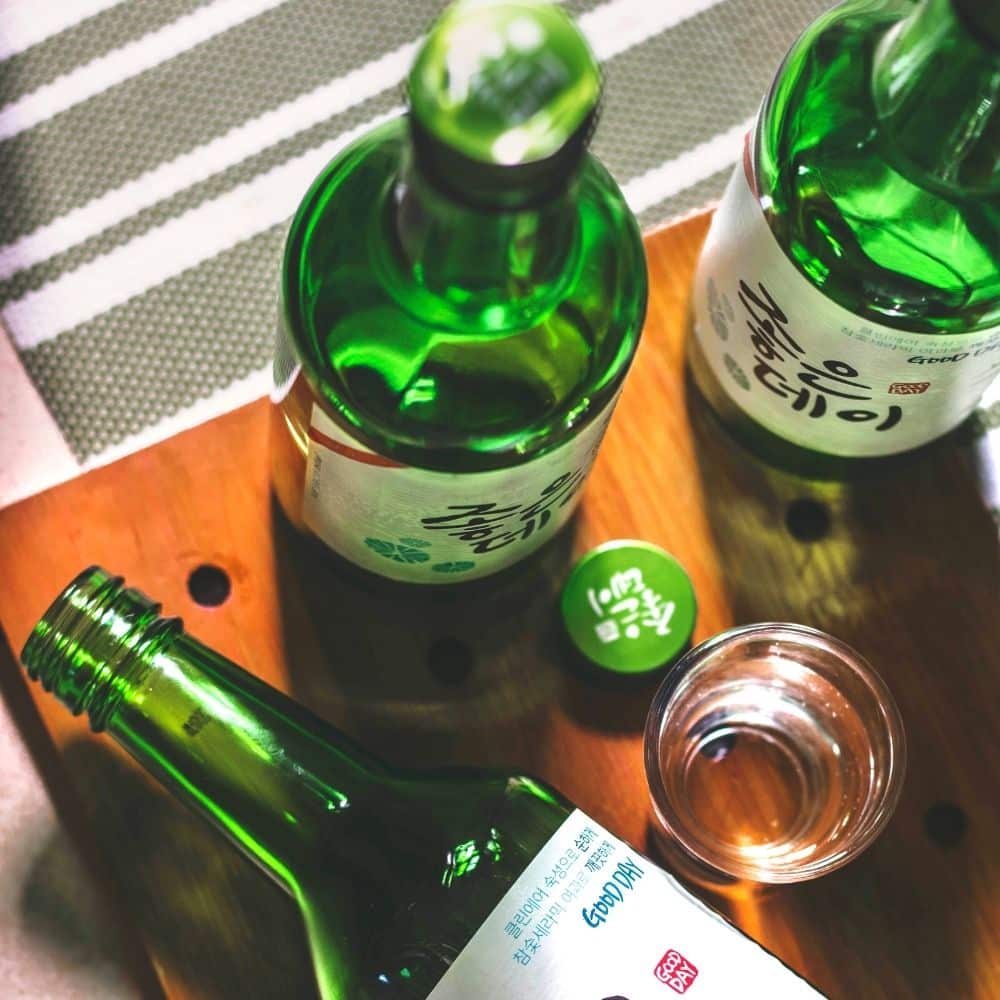
Hierarchy is important and Koreans expect respect to be shown to senior members. This can be done by waiting for them to take their seat first, as well as by waiting for them to eat and drink first.
At a Korean work meal or social event, the most senior member of the company will make a toast at the start and then take a drink. Other members should then also take a drink. Drinking before this is considered rude in Korea and can be disrespectful to the boss.
It is also expected that the most senior member will start eating first, and then other people can start eating. Similarly, when that person finishes the meal and is ready to leave, the whole team may be expected to leave, even if they haven’t finished eating.
I’ve been made to leave meals before I’ve finished as the director / principal was ready to go. Keep an eye on the most senior person at a work event and follow their lead. For meals out with coworkers, the system isn’t as strict, but still try to follow the lead of the most senior person.
34: Be Prepared To Sing Or Make A Speech
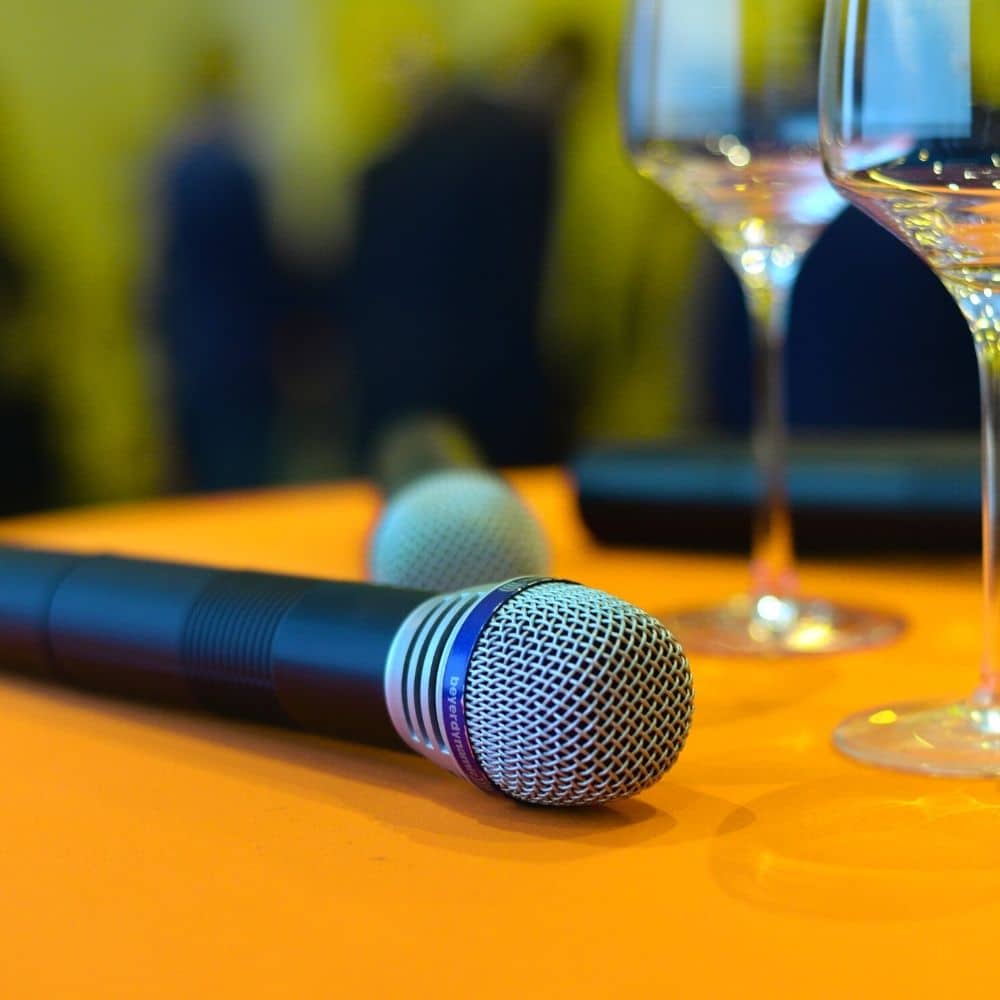
When invited out for a formal work event, such as a dinner or team bonding session (known in Korea as ‘membership training’), it is common for people to be asked to give a speech during a meal. Several speeches are usually made during the course of a meal.
As a foreigner in Korea, it’s likely that you’ll be invited to make a speech. Embrace the chance to practice a bit of Korean and the respect that is shown to you when asked. It’s a good chance to impress others and to create a good image in the company.
After-work parties often end up at a noraebang (Korean singing room) and you’ll almost certainly be expected to sing. Give it a go, even if you’re not a good singer. People will appreciate you willingness to join in and be part of the team.
Or your singing will be so bad that your boss will tell you never to sing in public again, which happened to me one time.
35: Group Harmony Is Number 1
Group harmony in a Korean work environment is very important and is the key to understanding a lot of the cultural differences between working in Korea vs. other countries.
Achieving group harmony involves following strict hierarchy rules and avoiding problematic situations, such as speaking against your superiors, not following orders, or being dishonest.
This aspect of Korean business culture can be difficult for non-Koreans to understand as it can go against what may be seen as common sense. For example, disagreeing with someone’s idea in a team meeting (especially the bosses) is seen as causing disharmony, even when it may be a better option.
If you want to know more about group harmony in Korean culture, this is discussed in more detail later on in this article.
You really have to experience this to understand just how deeply ingrained this is in Korean culture, but it’s useful to be aware that agreeing and getting along with others is really important.
How To Show Respect In Korea

Showing respect is the key to creating and maintaining a harmonious society, especially one where hierarchy is so important and individualism is surreptitiously frowned upon.
Here are three ways to show respect in Korea, including shaking hands correctly, bowing, and giving gifts. There are set rules that should be followed in each circumstance to avoid causing disrespect.
Learning these three simple ways to show respect will demonstrate that you’re sensitive to Korean cultural values and can help you fit into Korean society.
Korean Handshake Etiquette
Here are a few simple steps to help you master perfect Korean handshake etiquette.
- When greeting people in Korea, shake hands with both hands.
- Shake with your right hand.
- Place your left hand on the top of the wrist of your right arm or on the elbow.
- If the other person places their left hand on your hand, do the same.
- Bow forward slightly during the handshake with your head pointed downwards.
- Avoid direct eye contact if shaking hands with a senior work colleague or in a professional environment.
- Don’t squeeze too hard.
To avoid being rude when shaking hands, don’t put your non-shaking hand in your pocket. Leaving it by your side won’t be considered offensive, but it’s politer to shake with both hands.
Bowing Etiquette In Korea
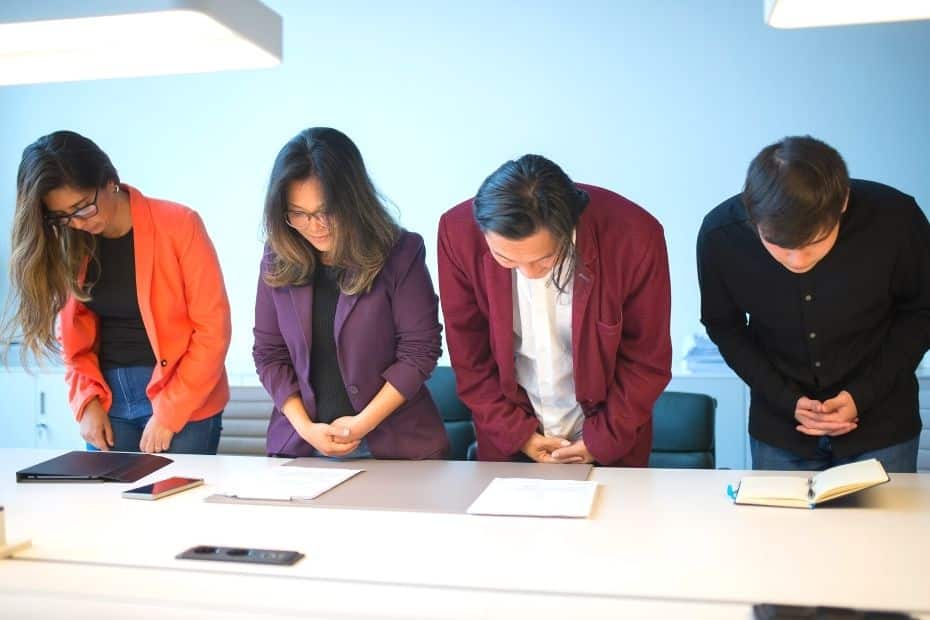
Bowing is a common way to greet people in Korea and to show respect in formal situations. Here are some simple steps to help you master a respectful Korean bow.
- Place your hands clasped together in front of you.
- Keep your head down to avoid eye contact.
- Bow forwards to about 45 degrees.
- Hold the bow for a few seconds.
When bowing to someone in a higher position, increase the bow a bit.
Bows typically don’t go more than 90 degrees in Korea and a deep bow like that is reserved for very formal occasions, such as when Moon Jae In met Kim Jong Un in North Korea.
Bowing At Korean Weddings
Traditional Korean wedding ceremonies involve lots of bowing, especially between the bride and groom as they complete various rituals, such as ‘ hapgeunrye ‘, which involves the couple drinking from a copper cup and represents the mixing of the two families.
There is also a section of the wedding called ‘ paebaek ‘, where the bride and groom will sit on their knees and bow down with their head touching the floor (grand bow) and then bow with their head slightly above their arms (half bow). This is to show the importance of family to the couple.
Japanese And Korean bowing Are Not The Same
Bowing is common in both Japan and Korea, but the methods of bowing are not the same and can actually cause offence for some sensitive people in either country.
A famous example of this is from a Japanese McDonald’s advert that showed ‘Korean bowing’ instead of typical Japanese bowing. Some Japanese viewers were outraged about the bowing technique used.
Japanese bowing, known as ‘ ojigi ‘ in Japanese, involves bowing with your hands at your sides. Korean bowing, known as ‘ jeol ‘ in Korean, involves placing your hands together in front of your stomach.
Deep bowing up to 180 degrees, which is typically reserved for public apologies in Japan, is not so common in Korea. If you bow too deeply, Korean people may think you’re ‘acting Japanese’.
Be careful bowing when travelling East Asia.
Korean Gift Giving Culture
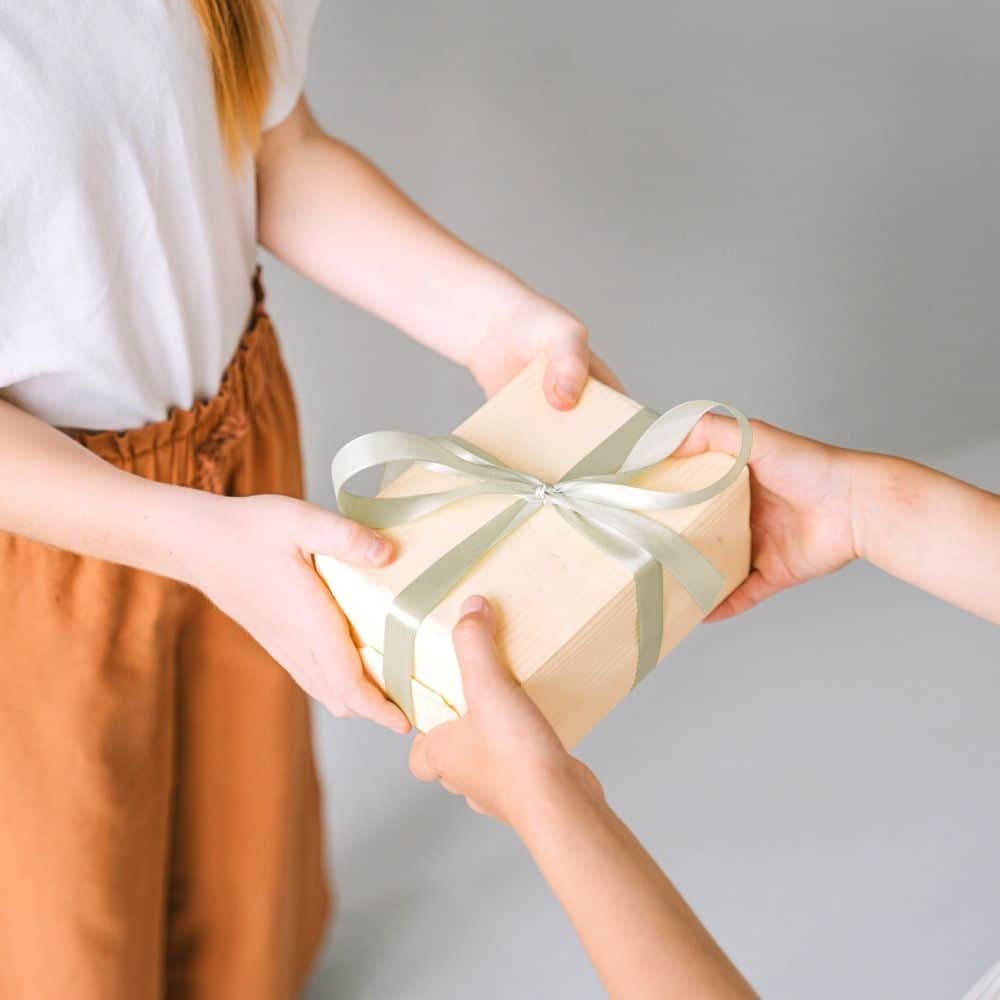
Gifts are exchanged in Korea for various social and work situations, such as when visiting someone’s house, for birthdays and holidays, and when starting a new job.
Here are some simple steps to help you respectfully give and receive gifts in Korea.
- Use two hands to give & receive gifts.
- Wrap the gift to make it look nice – visuals are important.
- Use light colours for wrapping, avoid red and dark colours.
- Don’t spend too much as you oblige the other person to spend as much.
- Don’t open the gift immediately unless encouraged to by the giver.
- Show your appreciation by commenting on the nice wrapping.
The rules will differ depending on the person giving or receiving the gift and some people, especially younger generations, may not care about any of these rules.
What Gifts Should You Give In Korea?
Good gifts to give in Korea include baked goods, sweets, and flowers. Bakeries in Korea usually have gift sets that are perfect for visiting someone’s house. Department stores are also a good place to buy gifts in Korea.
Suitable gifts from your own country can include local foods and snacks that aren’t available in Korea. However, be sure that you don’t bring in any ‘live’ food such as fruit or veg as it’s illegal to bring them into Korea. Chocolates, sweets, and teas are fine to bring into Korea.
If you’re working in Korea and want to make a good impression, bring in some traditional Korean rice cakes for your coworkers to share. However, they may prefer something from your own country or something sweet to eat instead.
When gifting to multiple people, such as in an office, individually wrapped, separate items are the best. Not only is it more hygienic, it also allows you to place a gift on each person’s desk, which is a common way to share gifts at work in Korea.
On November 11th, be sure to give a box of Pepero to your coworkers and friends as it’s Pepero Day In Korea . These cheap gifts are a great way to impress others and a delicious snack that can be enjoyed with coffee.
What Gifts Should You Avoid In Korea?
There are some gifts that are culturally sensitive and may make Korean people uncomfortable These include sharp objects, such as knives, because these items symbolise ‘cutting ties’ and this is the opposite of what you want to do when giving a gift.
Gifts in sets of four and cards written in red ink are also inappropriate in Korea because the number 4 and red ink both symbolise death. Red wrapping paper isn’t a good idea.
Don’t spend too much on a gift. Expensive gifts place a burden on the receiver to gift back a similarly expensive gift and might make them feel bad if they can’t match the cost of the gift.
Manners When Speaking Korean

This final Korean cultural consideration is one that will become apparent when you start to learn Korean or live in Korea – how to speak Korean without being rude.
The Korean language has been heavily influenced by Confucian values and social hierarchies, resulting in different forms of speech for different people within society.
The Korean language has 3 different forms – informal, formal, and respectful.
Informal and formal Korean, are mostly the same, with different conjugations to show varying levels of respect. Usually, the shorter the word ending, the less formal it is.
The respectful form is reserved for elders and superiors at work or in society. It’s also used by businesses and shops to show respect towards customers.
The respectful form of the language has unique vocabulary that you’ll need to learn. For example, the word ‘name’ is 이름 ( i-reum ) in informal and formal Korean, but is 성함 ( seong-ham ) in respectful Korean.
Here are the two forms of the verb ‘eat’ in informal, formal, and respectful Korean:
- Informal – 먹어 (meog-eo)
- Formal – 먹어요 (meog-eo-yo)
- Respectful – 드세요 (deu-se-yo)
As a tourist who might only know a few basic Korean travel phrases , you don’t need to worry too much about which form you use. However, if you want to learn Korean to live in Korea , you’ll definitely need to be aware that using the informal form of Korean with elders or superiors will be considered rude. If in doubt, use the most polite form you know.
Two Korean honorific titles that can help you show respect to strangers are -님 (- nim ) and -씨 (- sshi ). Nim is added to someone’s job title. Sshi is added to someone’s name and works like Mr. or Mrs. in English. You can add sshi to the first or last name.
If you’re interested in learning Korean and knowing more about the difference between the 3 types of language, I would recommend the Inner Circle Course With 90 Day Korean . You can get personalised feedback from tutors and lots of support and materials to help you learn Korean more efficiently.
Essential Korean Culture Insights
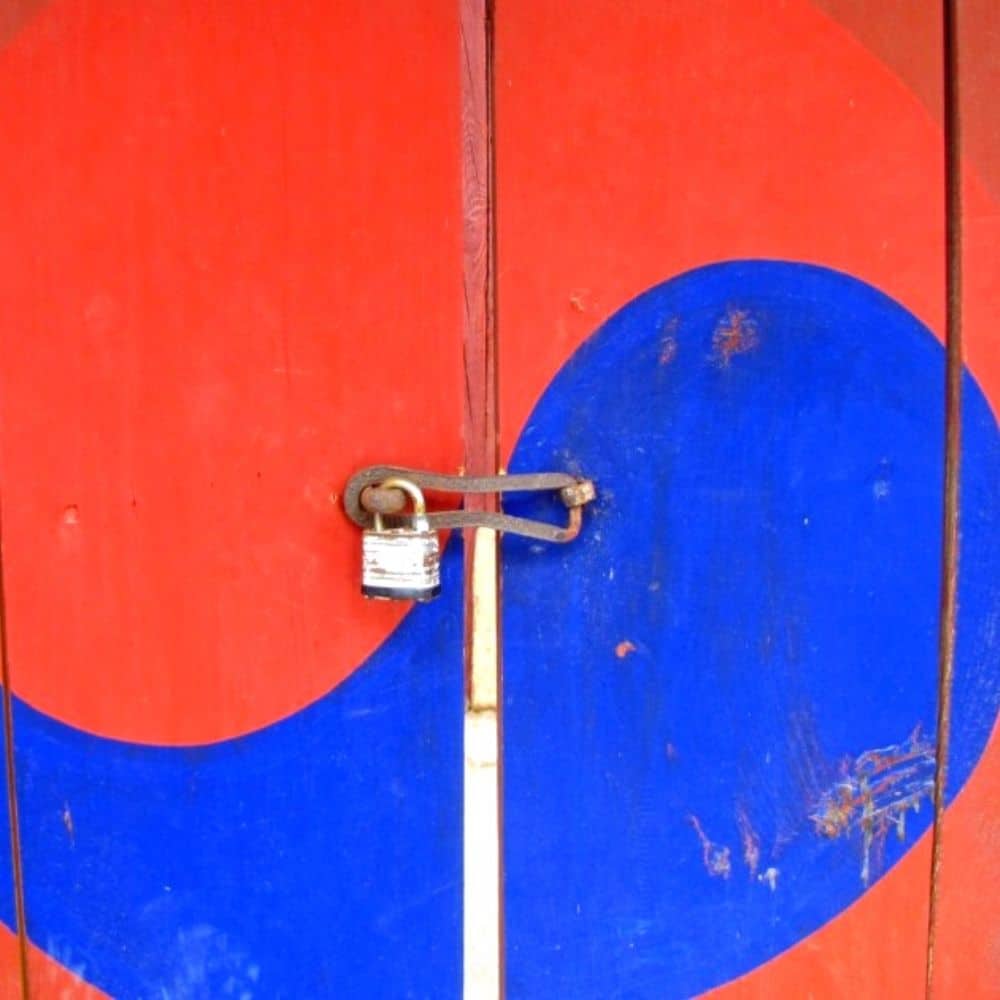
To appreciate these Korean etiquette rules, it is necessary to understand some basic principles about Korean culture and how it is different from other cultures.
There are 4 main aspects of Korean culture that have helped to shape and define etiquette, customs, and manners in Korea:
- Group Harmony
- Respect for Elders
- The Concept of Face
- Nationalism
These 4 key points only touch the surface of Korean culture, but should give you a basic introduction into what makes Korea so unique.
If you’d like a deeper insight into life in Korea, and some of the challenges and benefits you can experience, check out my article about Expat Life In Korea .
Group Harmony Vs. Individual Needs

The teachings of Confucius , a Chinese philosopher who lived around 2,500 years ago, have had a noticeable effect on Korean society since his descendants moved to Korea in the 14th Century.
Today, many morals and values in Korean society have the mark of Confucius, who promoted societal harmony, compassion, and empathy above individual needs and wants. So much so that Korea is known as the most Confucian country in the world .
I won’t give a detailed explanation of Confucian values, but it’s important to know that he believed people should put others before themselves. You can see this in the kindness towards friends and strangers in Korea, as well as in work environments where conflict is avoided at all costs.
People who disrupt the group harmony with their individual issues might be frowned upon. There is a saying that the nail that stands up gets hammered down. This helps create a harmonious society, but it can also cause problems for individualistic personalities.
As a traveller, this shouldn’t be an issue for you, but it’s important to know about so you can understand these Korean etiquette rules.
Respect For Your Elders
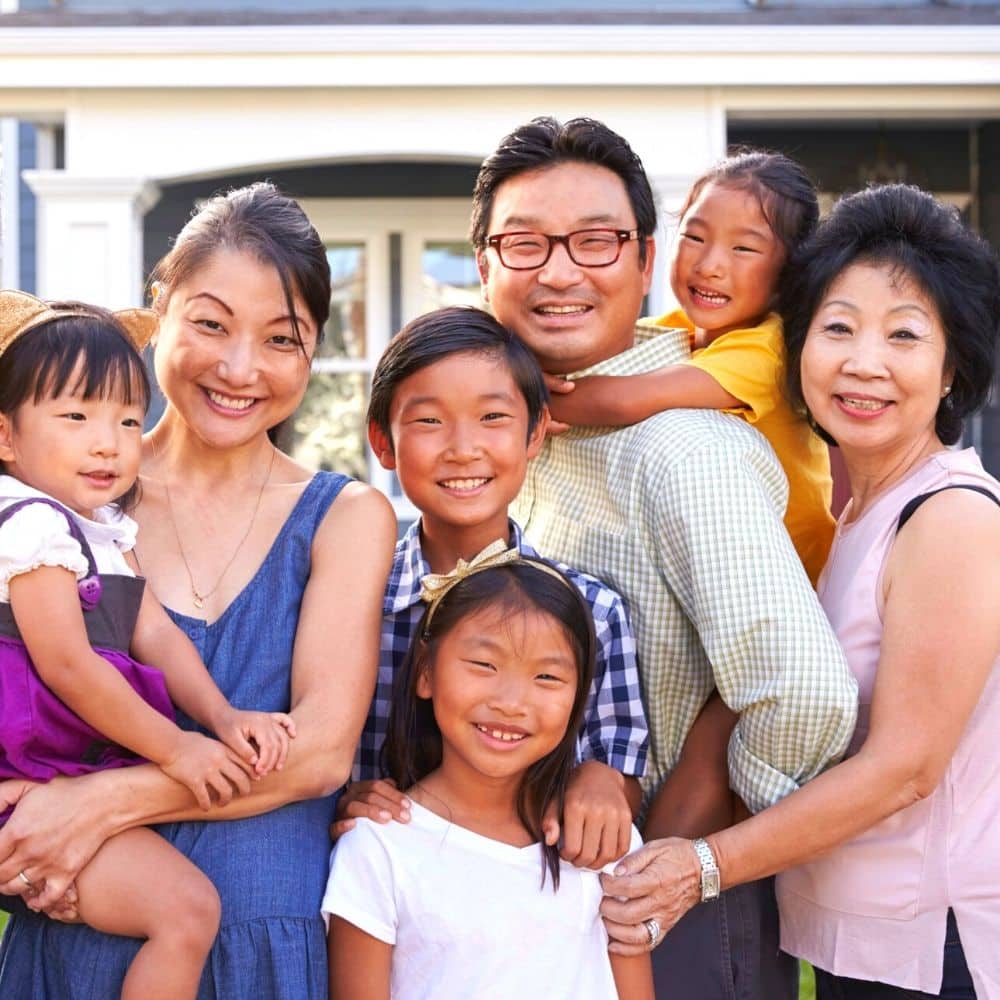
As with many cultures, respect goes upwards in age. This means that older people are respected more than younger ones. Due to Confucian teachings, age is even more important in Korean society.
Age in Korea can dictate the way you act or behave to someone, who gets to get on the subway first, who eats dinner first, and even who pays for meals when you’re out.
You might be asked your age so that people can figure out where you fit in the hierarchy. People will want to know what they can call you and if they should use certain language when talking to you. Therefore, you shouldn’t be surprised if this question comes up a few times. It can be shocking to be asked your age, especially if this is considered rude in your own country.
Although age and respect for the elderly are still an important part of Korean culture, there are also issues related to elderly poverty and the neglect of elderly parents by their children. If you’ve watched Squid Game, you might know what I’m talking about.
When you visit Korea, try to treat elders with respect, as I hope you would do anyway.
Kibun, Nunchi & Face

If you want to understand some of the more subtle aspects of Korean culture and etiquette, it’s useful to know a bit about kibun and nunchi . These will really help you avoid upsetting people unintentionally.
Kibun has no direct translation in English, but is a mixture of someone’s pride, face, dignity mood, feelings, and state of mind. When you attack or hurt someone’s kibun , you cause them to lose face. This reflects badly on that person within Korean society.
As mentioned, Korean society is based on group harmony, which involves mutual trust and respect. In order to protect this harmony, you should be aware of other people’s kibun , even if that means telling a small lie or doing something you’re not comfortable with.
Nunchi is the ability to determine someone’s mood and to know what needs to be done in order to avoid damaging their kibun . This is basically the ability to maintain peace within society. You can achieve nunchi by looking at other people’s body language and listening to how they speak. Even if someone doesn’t directly tell you something, they could be subtly suggesting it.
Kibun and nunchi are hard concepts to grasp and if you’re visiting Korea, don’t worry about them much. It’s useful to consider that people may agree to do things they’re uncomfortable with for the sake of maintaining kibun , or they may try to avoid conflicts at any cost.
Nationalism Is Strong In South Korea
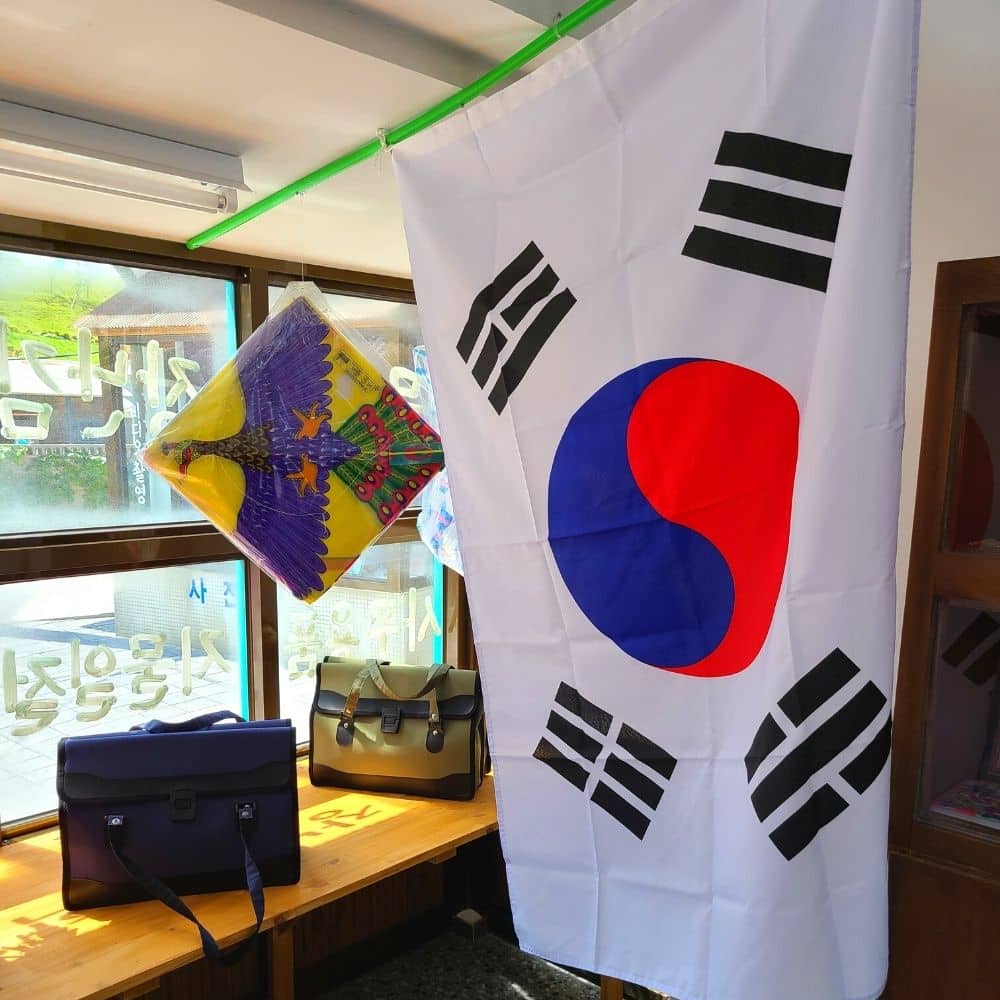
Korea has a high level of nationalism and people take pride in their country and national symbols, such as the Taegugki (national flag). Part of the reason for this stems from a history of battling between stronger, larger neighbours (Japan and China), as well as the ongoing conflict with North Korea.
Without covering the whole of Korean history, nationalism has been promoted to reinforce Korea’s national pride and unique identity. Having been occupied by Japan until 1945, the consequences of which were quite severe, Korea has worked hard to make its place in the world and to regain national pride.
Now, Koreans can be proud of their growing economic, cultural, and sporting achievements on the world stage. If you want to make friends in Korea, it’s always good to point out these achievements
Learn More About Korean Culture
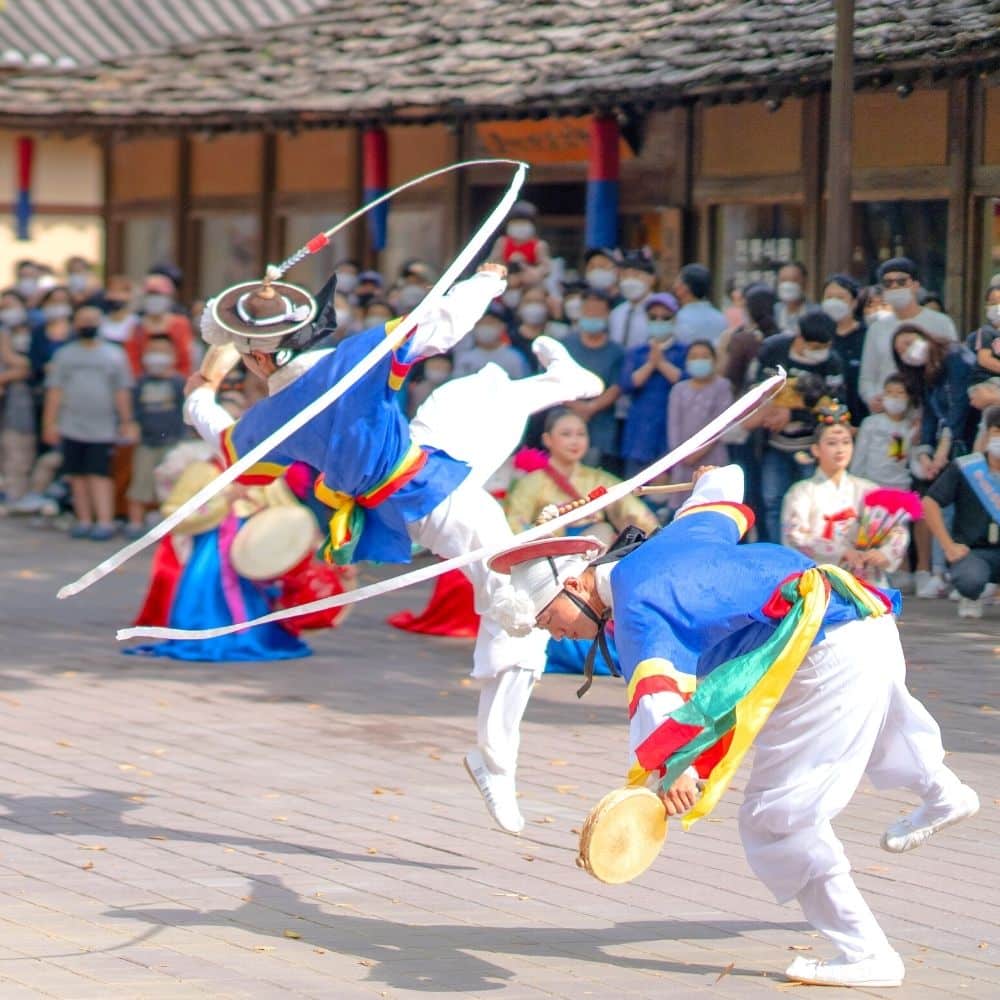
If you’ve enjoyed this article about Korean etiquette, culture, and manners and want to know more about Korean culture, then check out some of my other articles.
South Korean Cultural Facts : Discover 50 amazing facts about Korean culture, offering insights into the history or Korea, Korean people, Korean nature, and more.
Unique Korean Experiences : Create an unforgettable Korean bucket list with these 50 uniquely Korean experiences and activities.
I strongly encourage you to check out some translated Korean novels , too. These are excellent ways to not only learn about Korean culture in an interesting way, but to also discover more subtle, hidden aspects of life in Korea. Try applying the etiquette tips covered in this article when you read them, too.
Korean Etiquette FAQs
Finally, here are a few FAQs about Korean etiquette, culture, and manners, in case the above information didn’t cover enough for you.
What is considered rude in Korea?
Some things that are considered rude in Korea include writing someone’s name in red ink, blowing your nose loudly in public, public displays of affection by couples, wearing shoes inside someone’s house, and crossing your legs in front of someone.
Is it rude to cross your legs in Korea?
Yes. It is considered rude to cross your legs in Korea, especially when sitting opposite someone. Crossing your legs is considered disrespectful and gives the impression of being lazy. It’s particularly inappropriate in a work environment and in front of a superior.
How do Koreans shake hands?
Koreans shake hands with two hands at once. One hand is used to shake while the other hand is placed on the shaking hand, on the wrist or arm of the shaking hand, or around your waist under your shaking hand. The position of the non-shaking hand implies different levels of respect, with the closeness to the shaking hands most respectful.
Why do Koreans bow?
Koreans bow to show respect and to greet people. Bowing is also used in formal situations to show respect to a person, institution, or idea. Koreans bow during the national anthem, to show respect to parents and each other during weddings, and to apologise for a wrongdoing.
Do you tip in South Korea?
Most of the time, people don’t tip in Korea. Tipping is not part of traditional Korean culture as it is expected that people will work hard and offer good service with the need for extra reward. This is based on a person’s desire to uphold social harmony, based on traditional Confucian ideals that are central to Korean society even now. Tipping is acceptable in some situations, such as when taking a guided tour and some foreigner-focused businesses may add a service charge to bills. However, tipping is generally not expected in the majority of Korean businesses.
Is pointing rude in Korea?
It is rude to point in Korea, especially with the index finger. Gesturing with the whole hand or waving is preferred. Using the middle finger is rude in Korea, but the ‘V’ gesture (reverse peace sign) that is rude in the UK isn’t considered rude in Korea.
What are some Korean gestures of respect?
Bowing, giving gifts, and shaking hands are gestures of respect in Korea. Avoiding eye contact and using two hands while bowing, giving gifts, and shaking hands is considered polite. Using honorific titles for strangers or superiors at work also shows respect, as well as using the respectful form of the Korean language, which is different from the regular Korean language. Showing respect to elderly Koreans is expected and can include giving up your seat on public transport, holding the door for them, using respectful language, and agreeing with them.
Support In My Korea Thanks for reading. If you want to help me to create more great content in the future, why not buy me a coffee? A strong coffee helps me write more and is a simple way to show gratitude for this free content.

Liked This? Pin It For Others
If you enjoyed reading this article, then please share this with your friends on Pinterest.
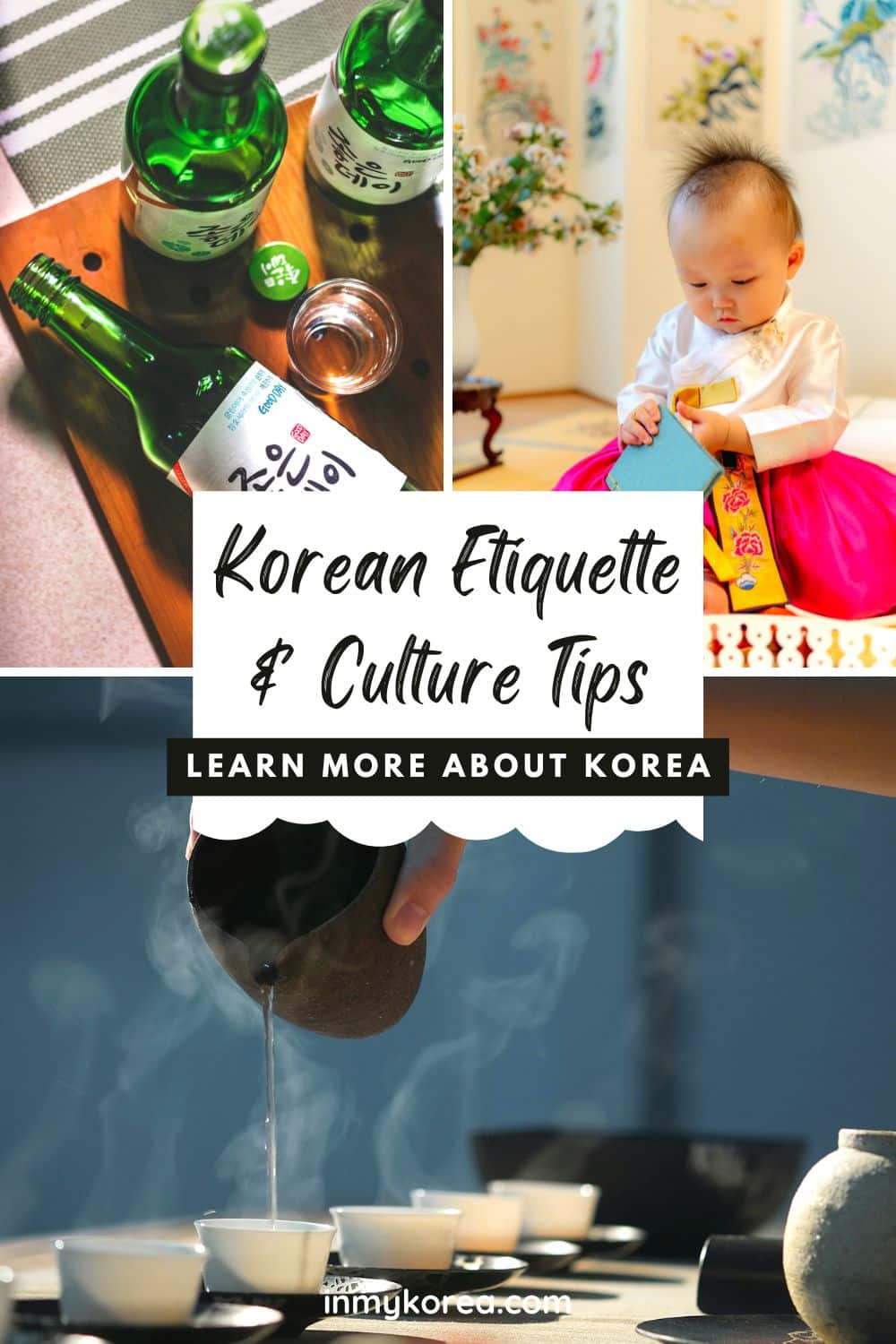
Related Articles
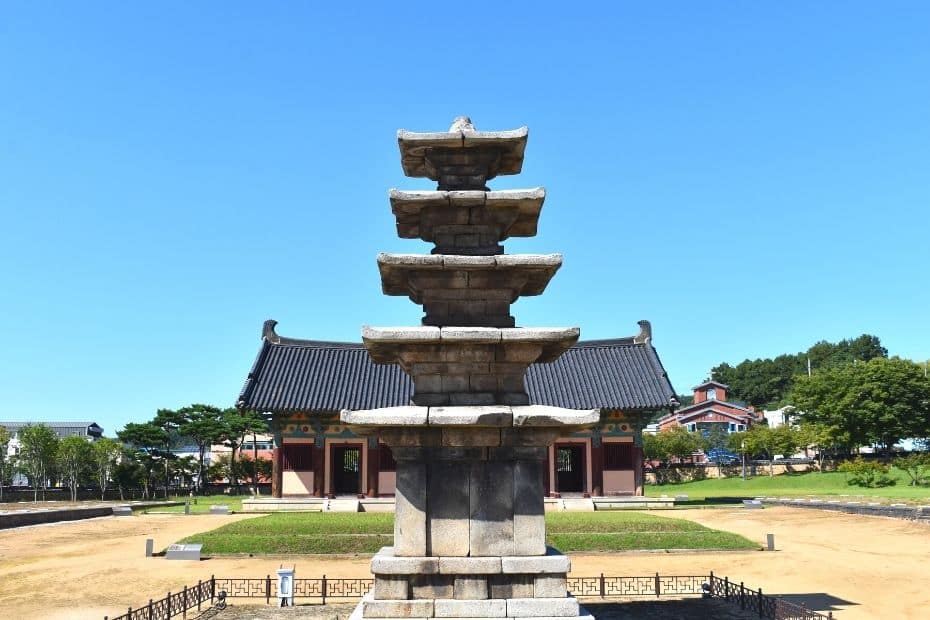
10 Things To Do In Buyeo 2024: UNESCO World Heritage City
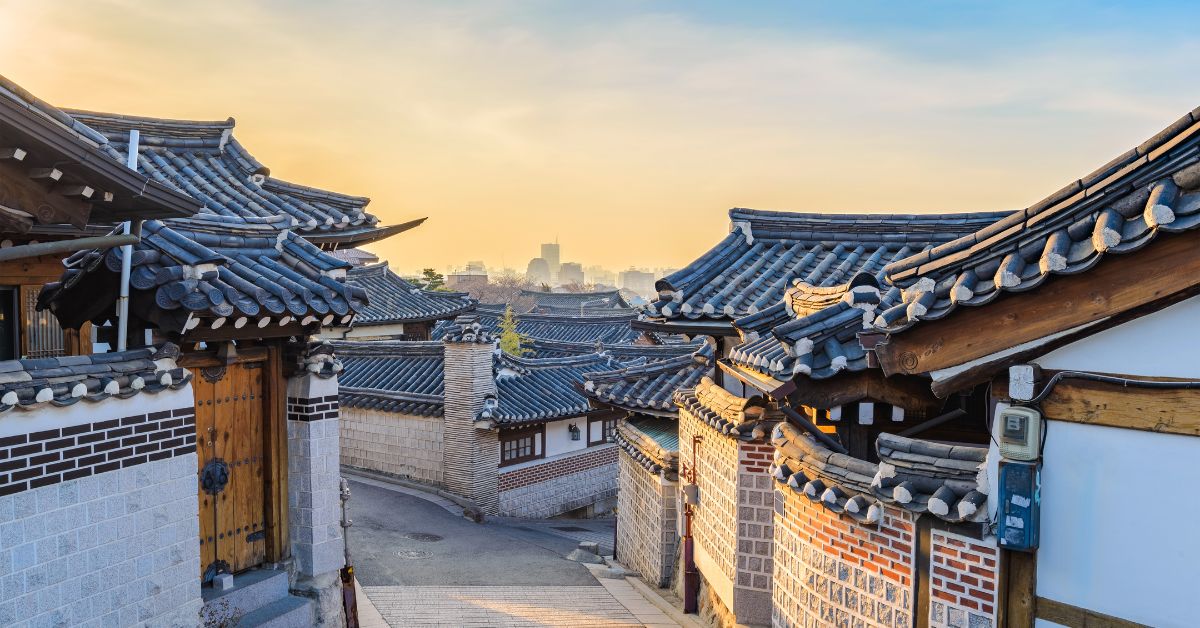
What To See And Do in Bukchon Hanok Village Seoul In 2024
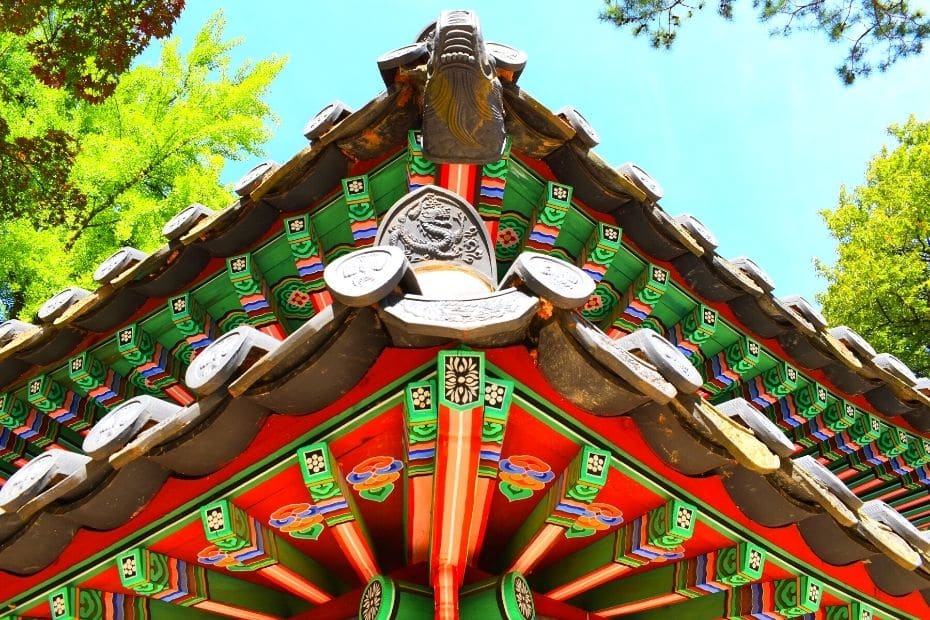
50 Amazing South Korean Culture Facts You’ll Love 2024

Hi! My name is Joel, I'm the author of In My Korea and writer of this article. I've lived, worked and travelled in Korea since 2015 and want to share my insights, stories and tips to help you have the best experience during your trip to Korea.
I love learning more about Korean culture, hiking the many mountains, and visiting all the coolest places in Korea, both modern and traditional. If you want to know more about my story, check out the ' about me ' section to learn why I love living in Korea.
2 thoughts on “Korean Etiquette, Culture And Manners: 35 Useful Insights”
This article was great, and I used it for a business communication class at the University of Arizona Global Campus. Thank you for writing it.
Thanks, I’m glad you found it useful. Hope the students learnt a lot from it.
Leave a comment Cancel reply
Save my name, email, and website in this browser for the next time I comment.

Mastering Korean Etiquette: A Comprehensive Guide
Delving into the intricacies of Korean etiquette, this discourse unveils a unique social fabric woven around profound respect, age-old traditions, and societal hierarchy. Korean culture, deeply rooted in Confucianism, is a treasure trove of ancient customs and specific etiquette rules. Understanding this social tapestry is the first step towards respectful interactions in various corners of Korean society, including day-to-day life and the business environment. With a deep dive into Korean manners, dining customs, business protocols, and more, this exposition offers an enlightening exploration into a world that values age, position, and veneration of the elderly, among other crucial aspects.
Understanding the Concept of Social Etiquette in Korea
Foundational principles underpinning social etiquette in korean society.
Vigorous in its cultural richness, South Korea’s societal norms are an intriguing interplay of tradition and modernity. The panorama of Korean social etiquette finds its roots in Confucianism, an ancient philosophical system intrinsically woven into the societal fabric. The web of Korean customs and manners, though complex, is elegantly coherent, enlightened by historical richness, and shaped by distinct socio-cultural dynamics.
Hierarchical Term Usage:
One of the key rules lies in the rudimentary nature of the Korean language itself. Hierarchical terms are used to denote the relationship between the speaker and the listener. Age, status, and gender play pivotal roles in conversation. Respecting these hierarchical terms is an essential tenet of Korean decorum that diligently promotes social harmony.
Food Etiquette:
Culinary traditions in Korea are rich with respectful practices. For example, in a communal meal, it is polite for the youngest members to wait until their seniors have started eating. Also, slurping or making noises while eating is discouraged, exemplifying the consideration towards fellow diners.
Gift-Giving Practices:
Gift-giving is a quintessential part of Korean social custom. It operates on the principle of reciprocity. Gifts, generally wrapped in colorful paper or encased in a gift box, are extended with both hands to show respect.
Hierarchy and Respect:
Age and social status profoundly influence Korean social conduct. Bowing is a common greeting, becoming deeper with an increase in the age or status of the recipient. Titles are preferred over personal names, demonstrating the significance of one’s position in society.
Collectivist Orientation:
Korean society captures the essence of a collectivist orientation. The needs of the group are often prioritized over individual desires. This is well-reflected in the Korean proverb, ‘The nail that sticks out gets hammered down,’ emphasizing harmonious living and social conscientiousness.
Understanding and appreciating the dynamism of Korean social etiquette is tantamount to unlocking the beauty of its cultural tapestry. These foundational principles are not merely rules of interaction but are a testament to the reverence Koreans have for order, harmony, and respect, painting a vivid socio-cultural narrative that echoes in the heart of its people and beyond.

Day-to-Day Korean Etiquettes
Navigating the cultural landscape: unearthing the art of manners in south korea.
Indubitably, progress in multicultural understanding rests on the comprehension of cultural norms – an indispensable facet being the social etiquette that pervades the everyday life of a group or society. In South Korea, the societal rules and customs that influence interactions assume pronounced importance. While the overarching themes of hierarchical term usage, food etiquette, gift-giving practices, hierarchy and respect, along with a distinct collectivist orientation have been discussed in detail, further exploration sheds light on other pivotal aspects of the Korean cultural milieu: punctuality, politeness, and the notable importance of body language.
Punctuality, or the adherence to appointed times, is heavily emphasized in South Korean culture. Arriving late to appointments is typically perceived as a form of discourtesy and a lack of respect. Boardroom meetings or casual get-togethers, Koreans place equal salience on punctuality, underscoring the time-honored proverb, “time and tide wait for no man.”
Politeness is imprinted in the fabric of Korean society, with special significance placed on the principle of “Kibun”. The deliberate maintenance and respect for another person’s ‘Kibun’ or ‘mood or state of mind’, is crucial in Korean interactions. Disrupting a person’s ‘Kibun’, whether through inappropriate behavior or discourteous remarks, can bring about conflict or disharmony. As a testament to this, Koreans often go to great lengths to ensure that their actions or words do not negatively impact another’s ‘Kibun’.
In the non-verbal sphere, the discourse on Korean etiquette is incomplete without addressing the importance of body language. Bowing, a deeply ingrained form of showing respect, is habitually employed in greetings and farewells. The depth of the bow has traditional implications – deeper bows designate more respect to the recipient. Furthermore, usage of both hands while exchanging items, a subtle yet powerful gesture, signals respect, especially when interacting with elders or superiors.
Understanding societal customs is no cursory matter. It involves an in-depth comprehension of the societal norms, which are intricately woven into the cultural fabric of the country, in this case, South Korea. Respect for time, the principle of ‘Kibun’, and the voracious attention to body language are key facets of the Korean etiquette that envelop every aspect of their everyday life. By appreciating and practicing these, one not only demonstrates cultural competence, but also fosters amicable relations within this vibrant society. The culmination of cultural knowledge is an asset to every global citizen striving to comprehend the nuances of the world around them.

Etiquette in Korean Business Environment
Translating the Understanding of Social Hierarchy and Respect Into Korea’s Business Environment
A juxtaposition of the communal ethos of Korean society with its business milieu unravels a seamless integration of respect, hierarchy, and a sense of collectivism. A thorough examination of the societal norms accentuates the business fabric’s propensity for hierarchical arrangements and dignity.
Korea’s unique fabric of societal and business structures underlines the pivotal role of hierarchy in steering both personal and professional connections. Delving into the world of Korean business interactions, one cannot ignore the inherently respectful and hierarchy-conscious business dialogue. The professional arena mimics the reflection of a society governed by status, age, and position, underscoring the vital role of hierarchical structures in the communication process. The respectful use of honorifics in the language and addressing the seniors by their position demonstrate this.
The role of hierarchy and veritable respect manifests in multiple facets of the Korean business environment, including decision-making processes. Consent from superiors generally precedes the implementation of novel ideas or strategies. The non-verbal communication cues like age-specific seating arrangements and bowing to superiors also resonate with the adherence to the hierarchical system.
The emblem of respect and communal harmony unwinds through the lens of Korean business etiquette involving negotiation and conflict resolution methods. Threading on the lines of ‘face-saving’ or concern for reputation, Koreans exhibit a tendency to avoid direct confrontation or disagreement. Adopting indirect criticism and careful phrasing in business interactions aids in preserving harmony and respect within the group.
Collectivism rides high in the Korean business etiquette. The embodiment of collective goals over individualistic pursuits shapes the success of any strategic initiative. The group dynamics over personal ambitions translate into the practices like company-wide holiday events and business socials, forging collectivist orientation in the workspace.
Engraining the understanding of kibun, or the person’s mood or state of mind, contributes to the successful navigation of Korean business interactions. Recognizing and respecting a professional counterpart’s emotional mood holds a position of considerable importance in maintaining a harmonious and productive business environment.
Finally, showing cultural competence paves the way for fostering amicable relations within the Korean business landscape. Understanding Korean customs and language, along with showing respect towards Korean traditions, can lay the foundation for stronger business relationships. Nurturing a relationship based on trust and respect, known as “Jeong,” turns the fulcrum in Korean business dynamics.
Thus, Korean business environment paints a landscape inspired by the societal norms of hierarchy and respect, stitched intricately with nuances of collectivism. The business protocols mirror the societal fabric, reiterating the significance of understanding these unique attributes for successful and harmonious professional interactions in Korea.

Korean Etiquette: A Comparative Analysis
Delving further into the infrastructural aspect of Korean etiquette in contrast with Western norms, the hierarchical structures at play in Korean business communication are pervasive. Unlike the comparative flat organizational structures typically seen in Western cultures, Korean corporations display a vertical hierarchy. This influences how employees communicate and interact, both internally and externally, making it essential to understand and acknowledge this approach for successful navigation within Korean corporate circles.
A noteworthy facet of Korean interactions is their consent-driven decision-making process. A nod from superior authorities reigns supreme, which contradicts the western style of quick, individualistic decision-making. As one delves deeper into understanding these nuances in Korean society, it becomes evident that broad agreement within a group significantly steers the course of decisions.
Body language and non-verbal cues are invariably linked to hierarchy in Korean society. Gestures such as making direct eye contact or crossing legs while interacting with someone of higher status are generally avoided, a departure from the more relaxed posture often seen in Western cultures. Understanding these nuances can foster stronger communication and interpersonal relationships in a Korean setting.
On the subject of business etiquette, Korean society assigns great importance to conflict resolution and negotiation methods. Various elements, such as using proper titles when addressing someone, maintaining harmonious interpersonal relationships, saving face, and avoiding confrontation are given considerable weight, more than in most Western societies where directness is highly valued.
A pronounced characteristic of Korean business environment has to be the significance placed on collectivism and group dynamics. Koreans pride themselves on unity and harmony, emphasizing the idea that group interests supersede individual goals. This sharply contrasts with Western norms often characterized by individualistic perspectives.
Possessing a keen sense of understanding and respecting a counterpart’s emotional state plays an influential role in Korean business interactions. Korean concept of “Kibun” (akin to a person’s pride or state of mind) means maintaining a positive, even temperament at all times to prevent others from losing face – a practice less pronounced in Western cultures that may tolerate confrontations or heated discussions.
An understanding and appreciation of Korean culture establishes a solid foundation for more effective business relationships. This calls for cultural competence, the ability to comprehend, appreciate, and interact effectively with individuals from different cultural backgrounds. Being culturally competent allows Westerners to foster amicable relations and solidify connections within the Korean business world.
The concept of “Jeong” holds an indispensable place in Korean societal dynamics. ‘Jeong’ is an emotional bond or a sense of camaraderie; it is often nurtured over time and goes a long way in building and maintaining relationships. This factor strongly impacts interactions in business, more so than in Western cultures where business relationships may be more transactional.
Recognizing and respecting societal norms around hierarchy provides a strong foundation for successful professional interactions in Korea. The hierarchical system extends to all aspects of life, from addressing superiors to maintaining decorum on public transport. By comparison, Western societies may allow more flexibility and informality.
Insight into variances between Korean and Western etiquette can facilitate more successful interactions across these cultures. Embracing these differences opens the door to respectful and meaningful exchanges, highlighting the universal truth that understanding and respecting each other’s cultural norms form a stepping stone towards global camaraderie.

This perceptive discussion leads us through the intricacies of Korean etiquette, showcasing the profound respect and consideration manifested in all aspects of Korean society. Having navigated the daily life and business greeting customs, the practice of removing shoes indoors, table manners, and the appropriate exchange of business cards, we have seen that each minute detail of this unique culture is filled with significance. Furthermore, the comparative lens applied to contrast Korean etiquette with Western norms offer valuable insight for those seeking to form meaningful and respectful connections within Korean society. Hence, more than just codes of conduct, these etiquette rules offer a fascinating glimpse into the underlying values, philosophy, and heart of the Korean people.
You Might Also Like

Korean Winter Skincare Simplified

Immerse in South Korean Culture: A Nomadic Travel Guide
History of korean constitution.
September 22, 2024
36 Best Korean Dramas on Netflix
Celebrating chuseok: a guide to korean thanksgiving, why korean olympians are the most lethal, a guide to korea’s elegant and enigmatic moon…, the top k-news from around the world.
Join Our Newsletter

- DOLJANCHI: Korean First Birthday
- HWANGAP 60TH BIRTHDAY
- LEARN THE KOREAN LANGUAGE
- KOREAN ZODIAC
- Korean Weddings
- TRAVEL GUIDE
- RESTAURANTS
- FOOD STORIES
- K-DRAMA & MOVIE
- Korean Etiquette
Korea is a country rich in etiquette, culture, and customs that are sometimes oceans apart from what you’d find in the West. Part of this is due to the strong influence Confucian teachings have had on the development of Korean etiquette and culture over the last 1,500 years. In Korea, age and social status are closely tied together and are key to determining how to act, who does what, and even how to speak. If you want to understand why crossing your legs might cause offense, how to greet people properly, and why Koreans behave the way they do, then read on and discover all there is to learn about Korean etiquette and culture.

Meeting People In Korea
The first section of this guide to Korean etiquette is all about how to meet and greet people. There are some golden rules that you must avoid breaking, as well as some simple ways to make Koreans feel more at ease when you meet them. Follow these tips and you’ll be making friends in no time.
Whether you’re touching down at Incheon Airport for a journey through Korea, or hanging out with new Korean friends in your neighborhood, these Korean etiquette tips will help you make a good impression and avoid any uncomfortable situations.
First impressions are always very important and this is especially true in Korea, where formality is a crucial part of both the culture and language. Knowing the correct way to meet and greet people can help you make friends and show respect to Korean traditions and customs.
Here are three good ways you can meet and greet people in Korea.
- Bow to greet people : A slight bow is a common courtesy when meeting people in Korea. The deeper the bow, the more respect you show. However, you typically don’t need to bow too much unless you’re in a very formal situation.
- Bow to say goodbye : Bowing is also the normal way to say goodbye in Korea. When someone is departing, bow or nod to wish them well on their journey. If you’re leaving, bow when you leave the room or just before you enter a vehicle.
- Two-handed shake : A handshake is another typical form of greeting in Korea, especially for men. A two-handed handshake is preferred, with either both hands clasping the other person’s hands, or the spare hand on your wrist, elbow, or waist.
Bad First Impression
Even billionaires make etiquette mistakes when greeting people. Bill Gates made the front page of newspapers in Korea for his ‘casual’ one-handed hand shake with his hand in his pocket when meeting former Korean leader Park Geun-Hye.
Read more here .
Now that you’ve introduced yourself to someone in Korea, make sure to avoid any Korean etiquette mistakes by keeping your hands to yourself. While gestures like a pat on the back, hug, or other close physical contact are ways to make friends in the USA, they can have a very different effect on Koreans.
Korea is a largely formal, conservative society where public image and behavior are key to maintaining harmony. Overactive body language can cause embarrassment for others and break that harmony. When in doubt, keep your hands to yourself.
Here are three ways to avoid offending Koreans when you meet them.
- Avoid hugging: Hugging and close physical contact is generally frowned upon in Korea unless people are close friends. Hugging a stranger could make them feel very uncomfortable and would be especially rude with older Koreans.
- Watch your body language : Besides close physical contact, there are some other ways you might offend Koreans with your body. Crossing your legs in front of someone is considered rude, as is waving your arms about near others.
- Don’t use first names: Try to avoid using first names in Korea unless you know that person already. For strangers, it is best to refer to them by their title (e.g. Mr. Kim) or professional titles. In Korea, the name order is reversed – surnames first, first names last.
Getting Pushed Around
Travelers to Korea may be shocked by the seemingly rude attitude of older Koreans, especially when queueing and when getting on/off public transport. It’s an unquestioned rule that they should have priority in these situations and they might happily push you if you’re in their way. Make some space.
While gift giving is a lovely practice, and one that’s welcomed in Korea, it can also be a minefield of etiquette errors waiting to explode. Use two hands to give and receive gifts from elders and in work settings. A small bow when gift giving or receiving a gift is a must.
Friends will often give each other small gifts, and there are a number of occasions when you might give or receive gifts from friends, coworkers, or partners. When buying a gift, don’t spend too much money, as this places a burden on the other person to reciprocate with an expensive gift.
Here are three important Korean etiquette rules to remember when giving and receiving gifts in Korea.
- Two-hand rule: When giving and receiving items (and handshakes), use two hands to show respect. This includes paying for items in a shop, receiving gifts, and pouring / receiving drinks from anyone. This rule isn’t so strict for younger Koreans or people familiar to you.
- Return the favor : If someone in Korea buys you a gift, it’s customary to reciprocate at an appropriate time with a gift of similar value. Western gifts are a good idea, as well as items such as chocolates, cakes, and flowers. Make sure to wrap the gifts or place them in a neat bag.
- Wait to open: If you receive a gift in Korea, make sure not to open it immediately. Look at the wrapping, say thanks, then put it to one side and open it later when you’re alone, unless they encourage you to open it immediately. Opening it instantly may cause embarrassment for the giver.
How Not To Gift
Be sure to avoid causing offense by offering gifts that are overly expensive or considered inappropriate, such as sharp objects, sets of four items, or anything written in red. These symbolize ‘cutting ties’ or even death. Avoid dark wrapping paper, especially red.
Here are some Korean gift ideas .
Here are a few tips to help you build good relationships with your new Korean friends, neighbors, or acquaintances. Navigating the murky waters of conversation can be difficult, with subtlety and harmony being key elements of polite conversation in Korea.
What this boils down is to being able to read the signals that Koreans might be uncomfortable or embarrassed, even when they don’t directly state a problem. This Korean etiquette guide will cover socializing in more detail in the next section, including Korean dining out and drinking etiquette tips.
Here are three Korean etiquette rules to keep and grow your connections in Korea.
- Just say yes: It’s poor Korean etiquette to say ‘no’ when given an offer or invitation. If you the person you’re asking is trying to avoid answering, take a hint and drop it. If you’re asked to do something, say yes, or find a way to let them down gently.
- Take a hint : Besides avoiding negative answers, Koreans may be indirect, giving hints instead of saying things out loud. Watch out for subtle comments about things that may be an issue. People may be too embarrassed to complain directly.
- Watch your hands: Try to avoid pointing at people with your index finger in Korea as it’s considered rude. Also, when you beckon people with your hand, make sure your palm is facing down towards the ground, not up to the sky.
Contact Culture Shock
Close contact between friends and family members is not uncommon in Korea. Same-sex friends, both male and female, can be comfortable holding hands, hugging, and sitting on each other’s laps. Children scrub their parents, and vice-versa, in saunas.

Socializing Etiquette In Korea
In this section of the Korean etiquette guide, you’ll learn more about group harmony and hierarchy and how they can influence even the simplest interactions like eating out together, sitting at a table, and sharing drinks. If you want to make friends in Korea and show you appreciate Korean culture, these etiquette tips will help you make a great impression.
Dining out in Korea is one of the most enjoyable experiences you can have. It’s also one that has a lot of hidden rules just waiting to trip you up. If you’re visiting Korea for business purposes, you’ll want to pay extra attention to these dining etiquette rules to make a lasting positive impression and to avoid upsetting anyone accidentally.
Korean dining culture is very different from typical dining culture in the West, with a strong focus on a group experience that respects social hierarchy. Rather than everyone ordering separate meals, it’s more common to order a large meal for everyone to share, eating from a large selection of smaller dishes and a central main dish. Respect is also key, making sure the VIPs get the best seats and take the first bite.
Here are three essential Korean etiquette tips for dining out in Korea.
- Wait to be seated: When you arrive at a group meal, especially in a formal or work setting, don’t rush to grab the first chair or spot on the ground that you see. Seats are assigned based on social hierarchy, with the most senior or respected taking the central seats. Wait for the senior members to be seated, then sit down to eat.
- Follow your elders : Korean etiquette states that the oldest are served first at meals. All eyes look to the most senior person to take the first bite. At that point, everyone else can start eating. The more formal the setting, the stricter the adherence. The same generally applies for drinks and a toast will be made before people start drinking.
- Watch your chopsticks: Chopsticks are an essential part of every Korean meal and essential when traveling to Korea. Here are some key etiquette rules you should follow when using them. First, never point chopsticks at people, it’s considered rude. Second, don’t stand them up in rice, this is done at funerals and symbolises death.
Sharing Meals In Korea
A Korean meal is a microcosm of Korean culture, filled with unspoken etiquette rules and behaviors that create a harmonious environment. When you sit down for a meal in Korea, you’re sharing an experience with others, helping one another enjoy the meal, showing respect to others, and putting the group before the individual.
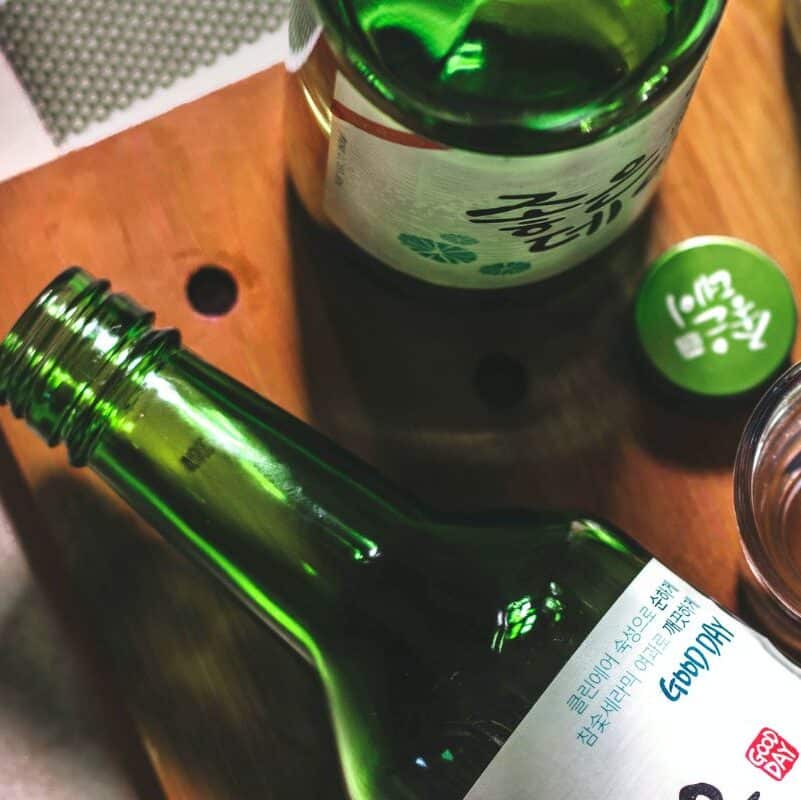
Drinks are served in small glasses (beer) or shot glasses (soju) and often drunk in one go (shouting ‘one-shot!’). Toasts are popular in Korea, and if you’re invited to a dinner or drinks party, you’re likely be asked to give a small speech or toast. After a shared meal, some Koreans like to go out for a ‘second round’, which involves going to a bar for more drinks, or a noraebang for singing.
Find out more about do’s and don’ts at a Korean dinner .
Here are three shots of Korean etiquette advice for when you’re out drinking with Korean people.
- The pouring hierarchy: The most senior person pours the first drink of the night for the younger person. After this, it’s the job of the younger person to refill the elders’ drinks for the remainder of the night. If there is no clear hierarchy, pour for others to be safe. Remember the two-hand rule when pouring drinks to show respect.
- Don’t pour for yourself : As well as pouring for your seniors, you should also pour for others when possible, and they will do the same for you. There is a Korean superstition about pouring drinks for yourself, which is why people avoid doing it. The old saying states that if you pour your own drink, you’ll never get married!
- Turn your head: Once you’ve poured drinks, turn your head away from the senior members of the group. It’s considered rude to face an older person straight-on when you drink alcohol. Instead, turn your head either to the right or left when you drink, and always put your hand over your mouth when upturning your cup.
Cheers! Korean-style
When raising your glass for cheers, hold your cup with two hands and be sure the rim of your glass is lower than that of your seniors’ to reflect your relative status. The Korean version of ‘cheers’ is ‘ geonbae ‘ (건배), which literally means ’empty glass’. Your Korean hosts no doubt know dozens more expressions or jokes to use for toasts.
Read more about Korean soju .
It might seem rather ironic, that after a night out eating and drinking together, sharing together as a group, that the issue of who pays the bill isn’t handled in the same way in Korea. Rather than ‘going dutch’ (splitting the bill), it’s often one person who pays for the whole meal. This depends on the situation, with work or formal dinners being a bit more rigid than going out with friends.
For a work meal, it will usually be the boss (or most senior person) who pays. If someone invites you out, they’re likely to pay the bill before the end of the meal so the issue of splitting the bill doesn’t come up. When dining with friends, you might take it in turns to pay each time. Either way, it’s best not to argue about the bill to avoid embarrassing others.
Here are three useful Korean etiquette tips for settling the bill in Korea.
- Who pays the bill?: Being younger ‘pays’ when it comes to picking up the tab because the older and more senior person usually settles the bill. The older takes care of the younger and the younger honors the older in other ways, such as by pouring drinks and serving during the meal. With friends, one person might offer to pay the bill for everyone.
- Return the favor again : If a friend treats you to dinner or drinks, be sure to return the favor and treat them another time. If you openly offer to pay for the meal in advance, they might decline, feeling like they’re burdening you. Therefore, invite them out and when it comes time to settle the bill, rush to the counter before them and settle the bill.
- No tipping, please: This might be one of the hardest Korean etiquette rules for visitors from the US to get used to. Tipping is not a common practice in Korea and a service charge is very rarely added to the bill. There is a no-tipping culture in Korea and if you leave money behind as a tip, it’s likely to be returned to you.
Are You Feeling Jeong?
‘Jeong’ (정) is a uniquely Korean concept that can be loosely translated as ‘a warm feeling arising from one’s relationship with another person, and their desire to help them’. You can often see jeong in action when eating out and someone suddenly treats you to dinner. Jeong stems from an idea of collective responsibility and harmony in society.

Don’t pour your own drinks, eat with others, and be prepared to give a speech or two if drinking. Once your time is up, show your gratitude to the host and offer to host them if you can. The host might escort you out, which is also a sign of respect.
Here are three ways to be the perfect guest when visiting someone’s house in Korea.
- Bring a gift: If you’re invited to someone’s house, bring a small gift such as sweet foods or breads. Bakeries in Korea offer lots of options for gifts like this. Flowers are also a good option, but don’t be too fancy or else the host will feel obliged to return a similarly expensive gift. Gift wrapping is always welcome.
- Remove your shoes : When you accept an invitation to someone’s house and you’ve made an appropriately deep bow of greeting, remember to also remove your shoes. All Korean homes have a landing/foyer for removing shoes and changing into slippers. It’s considered unlucky to wear shoes inside, as well as simply being dirty.
- Slippers for the toilet: If you need to use the restroom when visiting a Korean house, or when eating in a traditional Korean restaurant, you’ll need to make one more footwear change. There are separate slippers for the bathroom that you should change into before entering. Just remember to take them off when you’re done!
The Honored Guest
As mentioned, jeong is a key concept in Korean culture and this extends to visiting someone’s home. If you’re invited to visit someone’s home in Korea, you’re likely to be treated like a member of the family. It’s important to show respect by arriving on time, bringing a gift, and to avoid doing or saying things that might cause offense.

How Korean Social Hierarchy Influences Etiquette
In order to understand why these Korean etiquette rules exist, this section will teach you all about Korean social order and hierarchy. From the ancient teachings of Confucius, to the bright puffer jackets of modern Korean ajummas , there’s a lot of interesting aspects of Korean culture that will help you understand why Koreans are the way they are.
Discover the five different relationships in Korean society, how they might lead you to ask for someone’s 이름 ( i-reum ) or 성함 ( seong-ham ), and how kibun and nunchi are essential parts of Korean culture. Before learning about all of those, however, here’s a quick overview of the most important influence on Korean social hierarchy – Confucius.
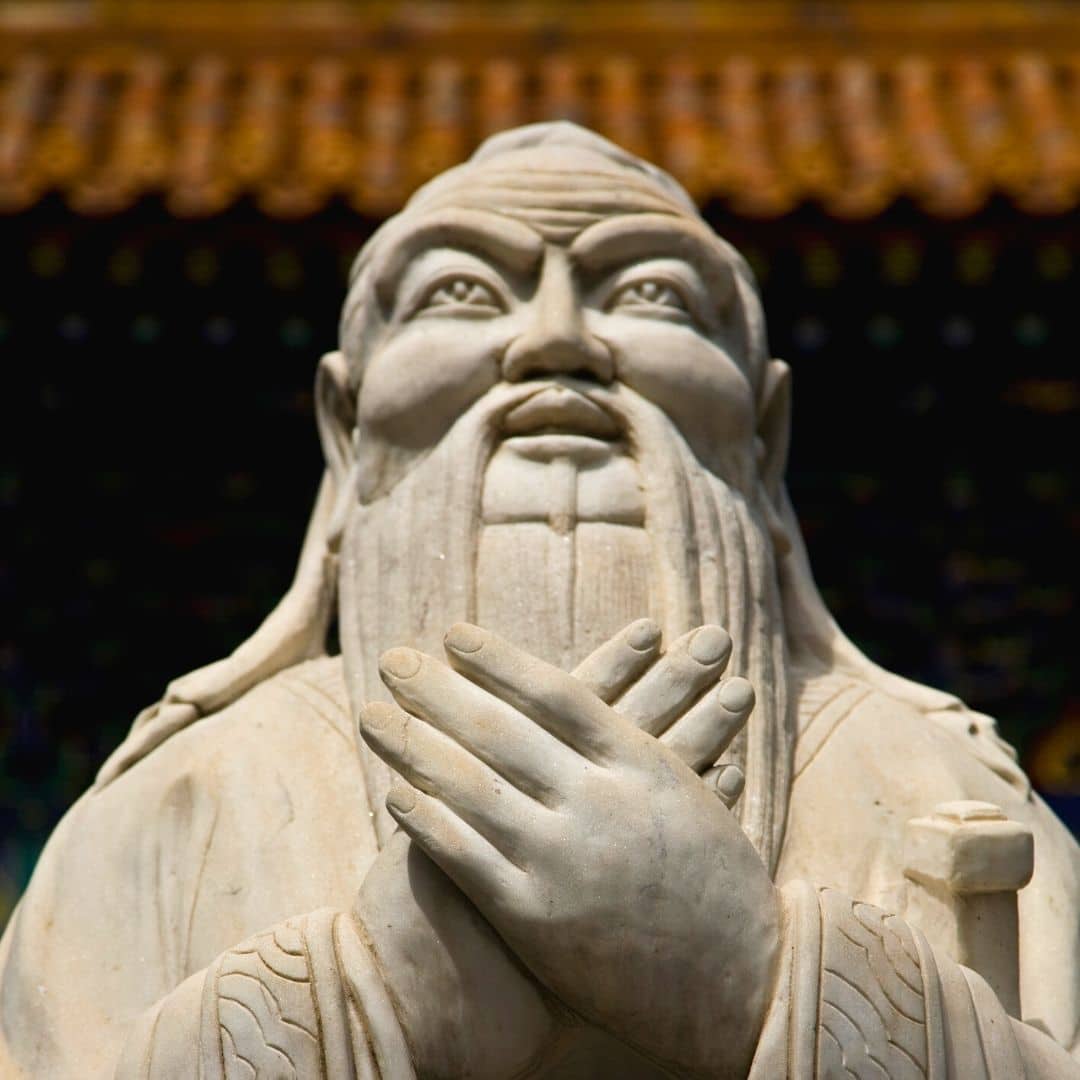
Morals, laws, and etiquette have all been shaped by these teachings and the result is a culture and society that is often confusing and misunderstood by Western visitors, but one that is welcoming and friendly. There are many positive elements of Korean culture and etiquette that have come from Confucian teachings, such as respect for elders, generosity to strangers, and the avoidance of conflict.
In modern Korea, you can see this in the friendly service at restaurants, cafes, and shops (as well as the lack of tipping). You will also see it when you travel on the subway and see reserved seats for the elderly or needy that are actually given to them. Strangers will help you out in need without any expectation of a reward and if you visit Korea alone, you might find some friendly locals looking to chat and learn more about you and your culture.
However, whilst there are many positive aspects of Confucianism, there are some things to watch out for. Disrupting group harmony with loud or offensive actions, even crossing your legs or hugging someone, can make your Korean friends or hosts uncomfortable. And they’re unlikely to mention it due to the desire to avoid conflict and embarrassment for you or them.
The clash between Western (individualistic) and Korean (collectivist) culture usually isn’t an issue for travelers visiting Korea, as tourists are treated as outsiders to Korean society. However, if you plan to live in Korea, it’s important to understand that 9 times out of 10, the group comes first. Speaking up and being ‘loud and proud’ are not valued qualities in Korea, where good people are considered to be humble and follow the rules. Understanding your position in Korean society, based on your age or social rank, is the key to knowing how to behave and what to do.
Although US travelers might feel like there’s an ocean between the two cultures, there are a lot of values and morals that both cultures share. Friendship, generosity, and respect are important for both Americans and Koreans. The main difference is the way these values are shown.
Find out more about how Confucianism has impacted Korean society .
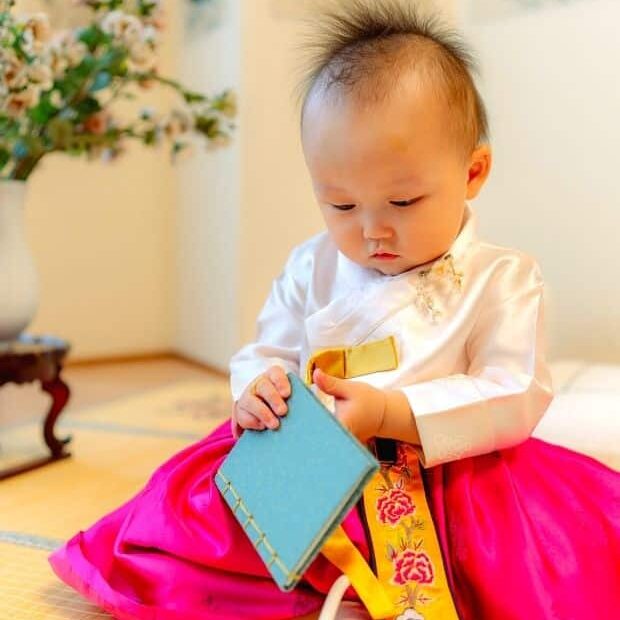
Another aspect of Confucian teachings is a rigid social structure based on age and social standing. Someone’s social standing is based on their family, upbringing, wealth, education, and occupation, although these are less important nowadays than they were during the Korean Joseon-era.
There are 5 different hierarchical relationships in traditional Korean society: King to subject, husband to wife, father to son, elder to younger, and friend to friend.
Only the friend to friend relationship is considered equal, which is why a lot of Koreans keep friends their own age – you don’t need to worry about hierarchy rules.
Knowing someone’s age can help you determine their ‘place’ within the social hierarchy and therefore how you should behave with them.
It’s quite common for strangers to either directly ask, ‘How old are you?’, or try to find out your standing through indirect questions.
Some people might be shocked to be asked their age, but it’s a necessary part of social interaction and Korean people don’t feel embarrassed to ask.
If you’re not certain about someone’s position in the social hierarchy, it’s best to show respect and be polite, which is always good advice anyway.

One thing that a lot of visitors to Korea struggle with are the more subtle, hidden aspects of Korean etiquette and culture known as ‘ kibun’ and ‘ nunchi’ . To navigate social events in Korea, you’re going to have to know how and why kibun and nunchi are so important.
What is kibun ? There’s no direct translation in English, but it can be summed up as a person’s sense of face, pride, feelings, honor, or state of mind. Kibun is closely tied to one’s position in society and whether you are respected by others. If a manager criticizes an employee, the employee’s kibun is damaged. If the employee doesn’t show proper respect, the manager’s kibun is damaged.
When you damage someone’s kibun , you’re causing them to lose dignity (face) in front of others, which can hurt their pride. Maintaining kibun is essential for a harmonious environment at all times. Koreans will seek to avoid damaging kibun , even if it means telling ‘white lies’ or avoiding conflict.
What is nunchi and how is it related to kibun ? Well, nunchi is the ability to determine another’s kibun , to be able to sense their feelings and knowing what is needed to maintain everyone’s kibun in a harmonious way. Nunchi can be achieved by observing other people’s body language, and by listening to the tone of their voice and what they say.
Feeling confused about how this all works? It’s understandable. Kibun and nunchi are very nuanced and something that happens in the back of most people’s mind. Just be aware that confrontations will be avoided at almost any cost, even when it might not be the best or most practical option.

Confucian values and social hierarchy are present in all parts of Korea, including the language. If you want to learn to speak Korean, you should be aware of how social values are reflected in the Korean language, including special forms of speech for certain people.
The first thing to be aware of is that Korean has several different forms of speech, typically referred to as informal, formal, and respectful. The latter is a form reserved for your elders or superiors. It’s also used by shops and restaurants to show respect to customers.
Formal and respectful Korean is known as 존댓말 ( jon-daet-mal ) while informal Korean is known as 반말 ( ban-mal ). While formal and informal Korean are mostly the same, respectful Korean has a different vocabulary for certain words. For example, the word ‘name’ in informal or formal is 이름 ( i-reum ), but in respectful Korean it’s 성함 ( seong-ham ). Thankfully, there are only a certain number of words that are different and they mostly relate to personal topics like family and home life.
When you want to address someone, you can show deference by referring to someone by their job title or a relation. For example, you might call someone ‘boss’ or ‘aunty’, rather than use their actual names. If you’re not sure what their name is, you can call them 선생님 ( seon-saeng-nim ), which means ‘teacher’, a respected position in Korean society. If the person is your peer, saying the person’s name is acceptable, but be sure to add the honorific 님 ( nim ) or 씨 ( sshi ).
Find out more about Korean honorifics .
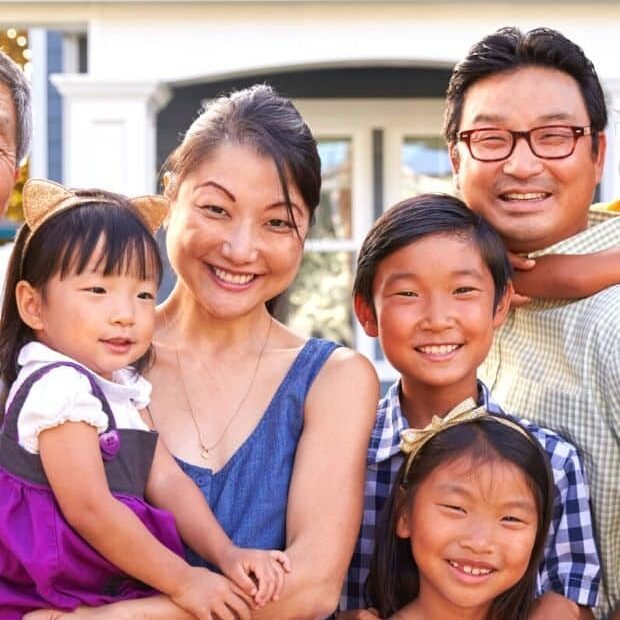
The family is the core of Korean society, just as it is other countries around the world. Unlike many Western countries, however, the strict adherence to Confucian ideals has led to stronger family ties, traditions, and hierarchy rules. It’s worth noting that the following is based around traditional Korean ideals, some of which may be changing as Korea becomes more intertwined with the global society.
One key concept of Korean family life is filial piety – respecting one’s parents and elders. So much of Korean etiquette is rooted in filial piety, from the language used to speak to your elders, the terms used to address family members, and ceremonies honoring relatives that have moved on.
Parents will care for their children and do their best to give them as much of an advantage in life as possible. This can be seen through the large amounts of money spent on private tuition for children and generous support to help them buy their first home. Children are expected to respect their parents and be obedient in return, as well as look after their parents when they retire.
Americans may be shocked to hear that arranged marriages are still common in Korea, as is matchmaking by parents and friends to help people find their true love. Divorce rates are typically very low, with the idea of getting divorced considered unthinkable until recently.
Korean family names don’t work in the same way as they do in the US. Children typically take the surname of the father. Married women also keep their own surname instead of changing it. The eldest son is meant to be responsible for the family and care for his parents when they retire.
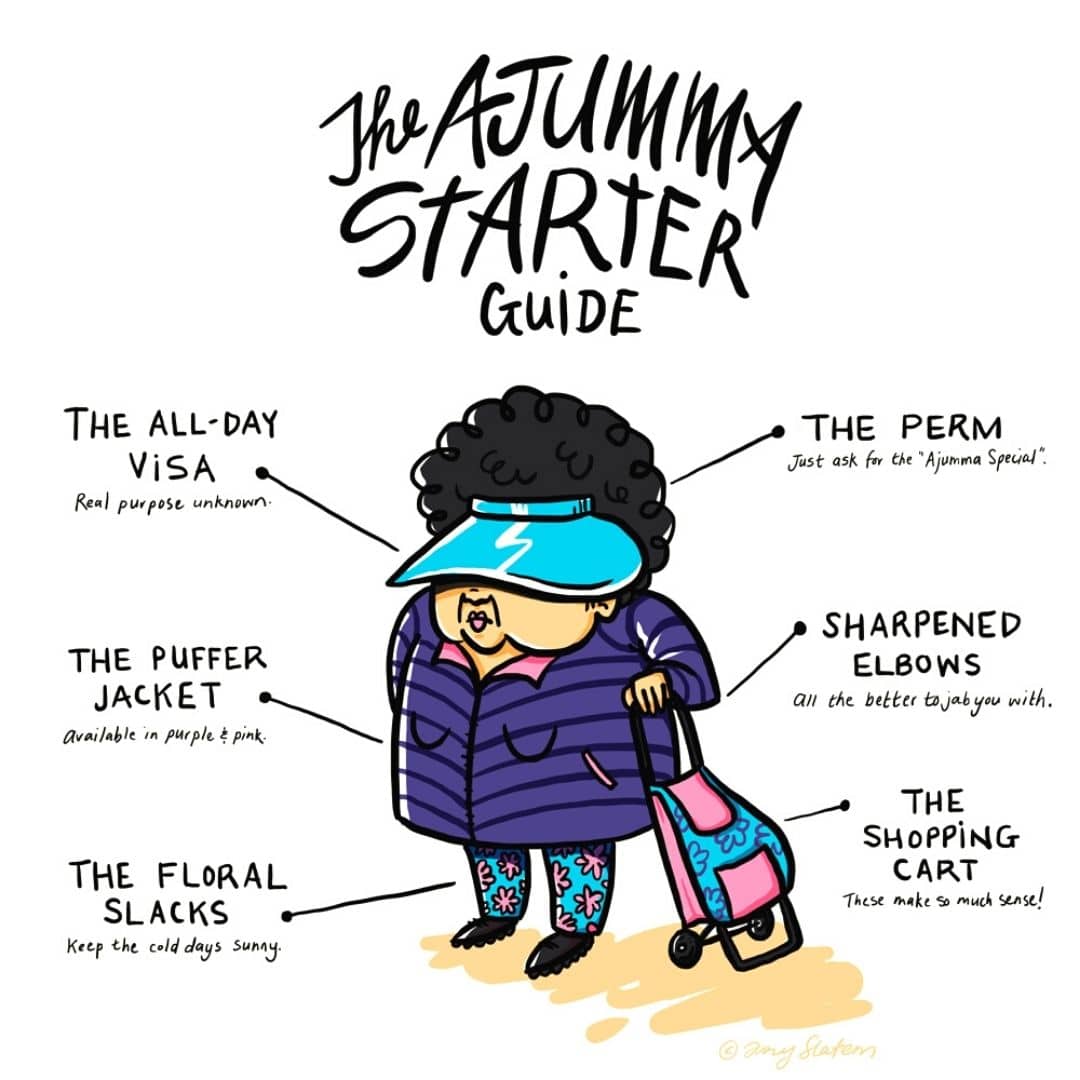
No guide to Korean social hierarchy would be complete without mentioning the queens of Korean society – the ajumma (아줌마). ‘ Ajumma’ is a term used to describe a married, middle-aged woman and is loosely translated as ‘aunty’.
Whether you’re in Koreatown, downtown Seoul, or hiking in a Korean national park, you won’t be able to avoid the ever-busy ajumma as they go about their day haggling for discounts, chatting, and commenting on the world and its problems.
These ladies seem to revel in breaking the rules of Korean social order by pushing their way onto subways and buses, talking loudly in public, and wearing bright, colorful clothes that cause them to stand out. Confucius would be spinning in his grave!
If you’ve seen Kim’s Convenience , Jean Yoon’s character, Umma, was the perfect example of a Korean ajumma , although she wasn’t sporting a big enough perm.

Korean Etiquette Taboos: What You Shouldn’t Do
Korea is a tolerant society with friendly, welcoming people who will usually not point out cultural faux pas or embarrassing mistakes made by foreigners. However, this doesn’t mean that you would want to commit such atrocities and upset your Korean friends or hosts.
While there are seemingly never-ending ways you might offend someone in Korea, there are some easy to remember etiquette taboos that you can do easily and save yourself from a lot of trouble and awkward situations.
A lot of them are to do with eating, such as not pointing with chopsticks, not wearing shoes inside a restaurant, and using wet wipes instead of licking your fingers. Others are about personal space and not getting too close to other people, even those you’re madly in love with (including K-Idols!).
Here are six simple etiquette taboos to avoid to save your bacon.
No PDA, Please
Don't Lick Your Fingers
Sniff, Don't Blow
Keep Your Legs Straight
Don't Walk & Eat
Keep Your Distance

Those unfamiliar with Korean and East Asian cultures may be shocked by the many ways you might accidentally wish someone was dead or bestow bad luck on others. Did you know red ink, chopsticks, and the number 4 are all tied to death and funerals?
On the subject of death, another unusual Korean superstition is that electric fans can kill you if left on at night. Ever since the 1920s, Koreans have been wary of the whirling blades of death that are trying to keep people cool at night. Find out more about the Korean fan death myth .
Here are three spooky superstitions to watch out for in Korea.
Beware Red Ink
Unlucky Number 4
Watch Your Chopsticks

Exploring Korea’s Religious Beliefs & Customs
Korea is a country with a complex religious makeup, but also one where the majority of people don’t associate themselves with a religion (57% of Koreans). It’s also a country where people will go to a fortune teller before they get married to check if their future spouse is right for them, pay their respects at Buddhist temples, and hold ceremonies throughout the year to honor their dead ancestors.
The two major religions, Buddhism and Christianity, are a world apart, both spiritually and physically. Christianity, which entered Korea through Chinese Confucian scholars, has had a turbulent history in Korea, including the Catholic Persecution of 1866 where 8,000 Christian priests were executed.
Buddhism has been around far longer than Christianity, with some of the first Buddhist temples erected more than 1,700 years ago. Both Buddhism and Christianity are outdated by a long way when compared to Korea’s prehistoric animistic shamanistic traditions.
If you want to experience the vast network of Korea’s temples, shrines, and churches, remember to do so with respect. These places are welcoming to tourists and those eager to learn, but there are also etiquette rules to follow in these holy places. Shoes are forbidden inside temples, and most places will ask you not to eat or drink inside. Try to avoid disturbing monks and priests, especially when they’re in the middle of worship or a ceremony. Basically, act as you would do when you’re a guest.

When you explore Korea, you’ll certainly notice a lot of bright red crosses lighting up the night sky, with churches scattered far and wide between housing complexes and shopping centres. While Christianity has taken hold in the urban areas, you’ll discover Buddhist temples more frequently in the countryside, especially in Korea’s national parks. This is due to the spiritual connection between nature, the mountains, and Buddhist beliefs.
If you are interested in learning about Korean Buddhism, then a Korean temple stay is a fantastic opportunity to see the inner workings of a Buddhist temple, talk with Buddhist monks, and sleep overnight in a traditional temple
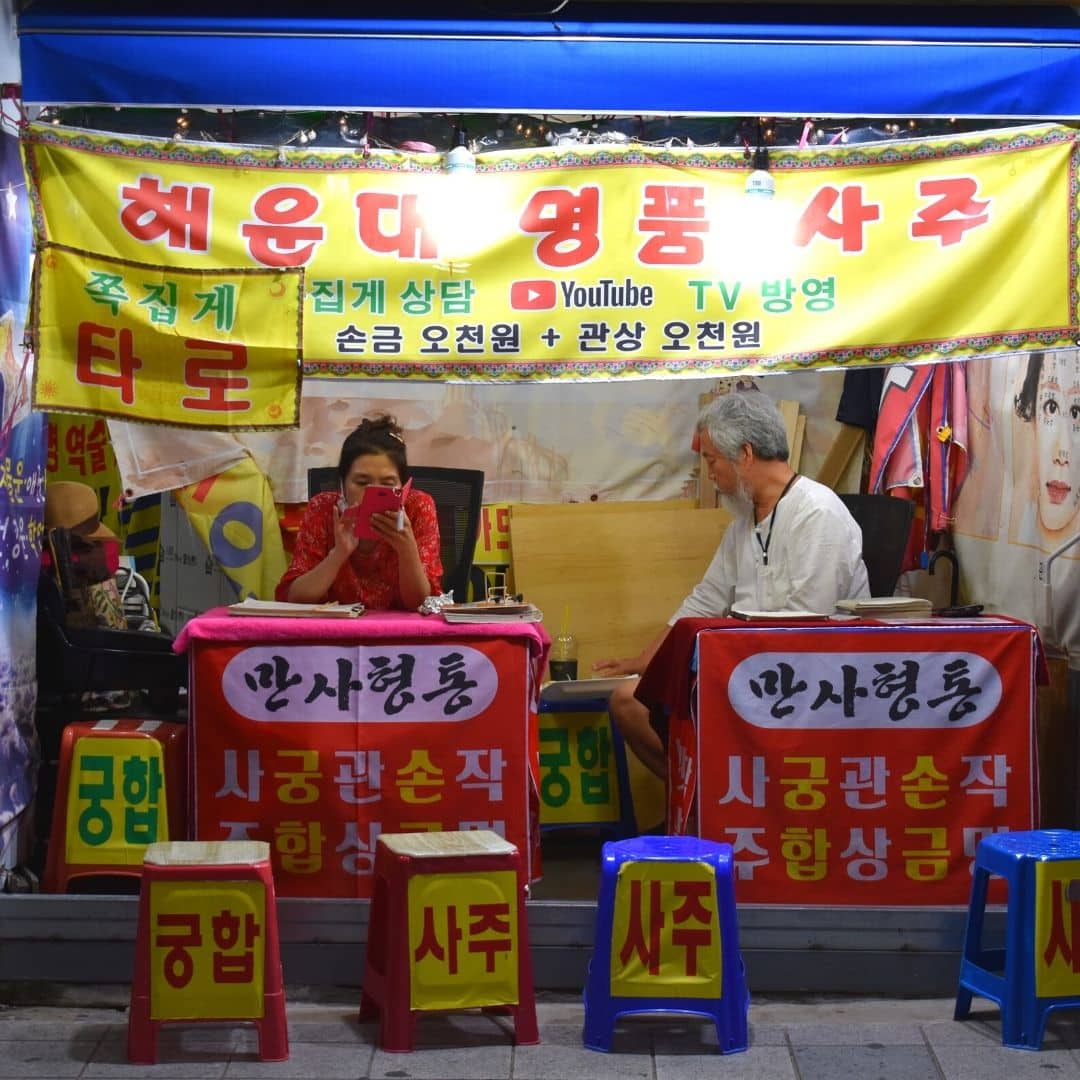
Korean shamanism involves the worship of gods, nature spirits, and one’s ancestors. Korea’s latest President is one of the most prominent believers in Korean shamanism. Korean shamans, all 150,000 of them, act as a go between for the spiritual world and the material world, helping to solve daily problems through gut rituals – songs, dances, and prayers for the gods and ancestors.
Fortune telling and tarot is also very popular in Korea, with more than 300,000 claiming to converse with the spirits of the dead (for a small fee). You can find fortune tellers across Korea, usually with small stands shown in the picture. Koreans typically visit fortune tellers before getting married, before exams, or at the end of the year to find out their fortune for the year ahead.

Korean Work Etiquette & Culture
Business travelers should be especially careful with these Korean etiquette rules. Building lasting business relationships and trust in Korea will be a lot easier if you understand how Confucian principles and social hierarchy dominates the business world.
If you want to get ahead doing business in Korea, remember that Koreans want you to be friendly, trustworthy, honorable, and to show respect at both work and when out socializing. The deepest connections can be created not in the office, but at the bottom of a glass of soju.
Compared to socializing and family life, the pressures to follow etiquette and cultural norms are far greater in a Korean company. There is a stronger focus on kibun and nunchi than other visitors to Korea will experience. Remember, avoid conflict wherever possible and don’t make anyone else lose face through your actions. Accept and give items with two hands to show the greatest amount of respect, bow when greeting and leaving someone, and try to speak a bit of Korean to create a good impression.
The work ethic in Korea might seem very different from the US. Koreans, especially public workers and those in large corporations like Samsung, will work long hours and stay in the office until late at night, leaving as late as midnight in some cases. Working over the weekend might also be expected, but isn’t that common. Koreans can feel uncomfortable saying no to requests, which can leave some working extra hours when asked to.
Families dominate the Korean business world and some of Korea’s largest conglomerates are run by families, including Samsung. Family members obtain management positions throughout the organisation, meaning there are lots of close connections between different business units. For outsiders trying to work out the various allegiances, family connections, and internal politics of a company, this can be very confusing.

The Korean workplace is perhaps the best example of a Confucian organisation you’ll find, with strict levels of hierarchy that are typically one-directional. Bosses tell the workers what to do and expect them to follow orders. Questioning those orders is seen as rude and can cause loss of face for the manager.
Korean companies devote a considerable amount of time and resources to building up team morale. This is done through a practice known as ‘membership training’, which is a form of team bonding.
This can involve day trips out together, work meals, even vacations away in other parts of Korea for a few days during the working week. Companies have special budgets to cover these expenses and see it as an investment in group harmony. However, this aspect of Korean culture is slowly eroding, especially among younger generations and those who want to spend time with their families.
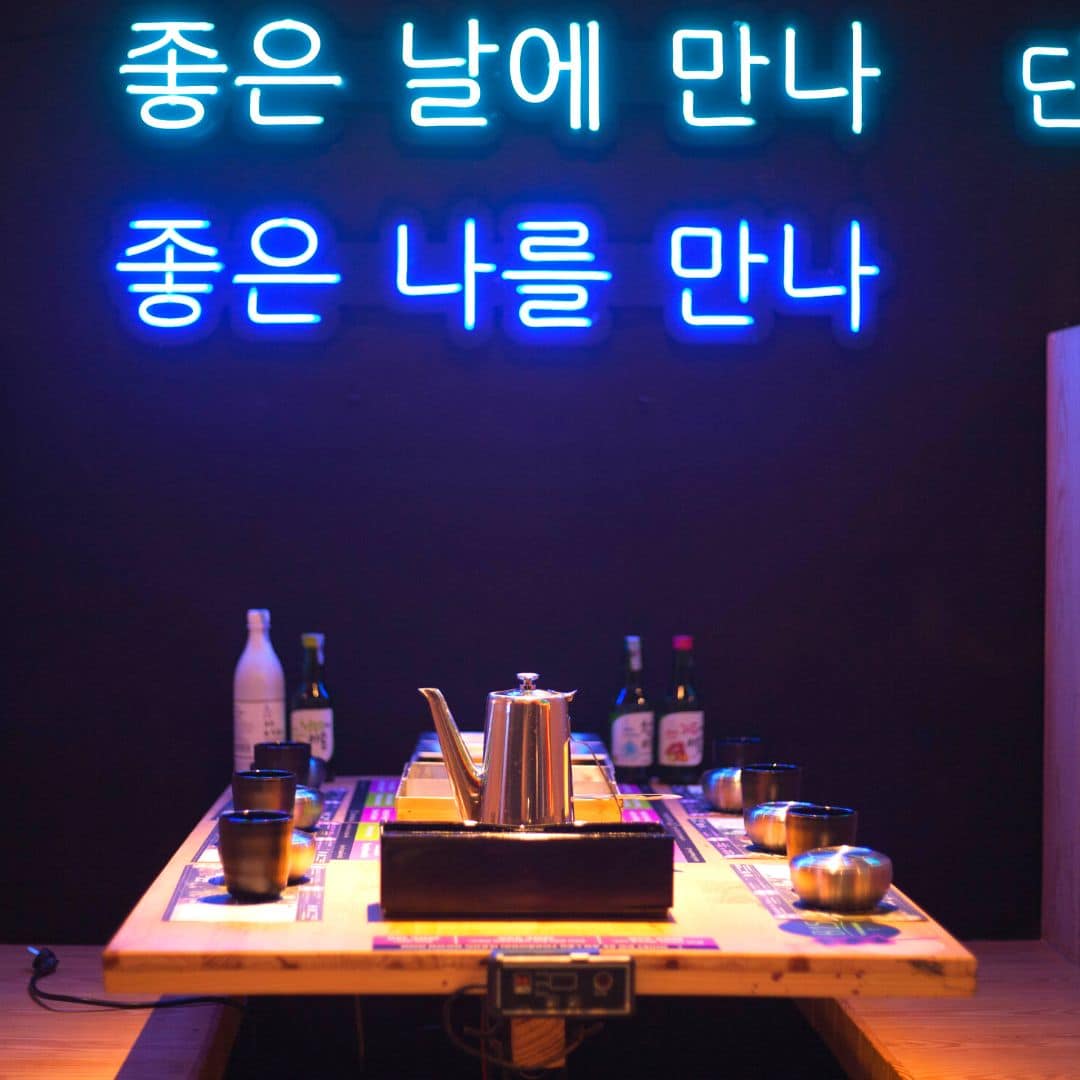
These social events are a great way to build connections with your Korean partners, and a bottle of soju or two helps everyone relax and get chatting. The aforementioned Korean etiquette rules for socializing will definitely help you out if you need to attend a work dinner. Remember to pour drinks for your seniors, wait for them to eat first, and don’t pour drinks for yourself.
Be careful when drinking soju, it goes down easy and you might not notice how drunk you are. Of course, you don’t have to drink to do business in Korea, but for many companies, it’s still a central part of socializing. If you’re not comfortable drinking a lot, drink the first toast then leave the glass full for the rest of the night. If your glass is empty, someone will fill it up for you.
Hungry for more Korean etiquette and culture insights? Here are some more Best of Korea articles to whet your cultural appetite. Read up about Traditional Korean Funerals and what happens when someone dies in Korea – it’s a very different situation than you’ll find in the USA. Korean Weddings are similarly unique, just like Korean Valentine’s Day traditions.
Actually, dating is very confusing in Korea because there’s not just 1 romantic day on February 14th, there are actually 12 Korean Romantic Dates throughout the year!Learn how people in Korea use Blood Types to determine someone’s personality and how you might not be able to find your perfect partner if the juice in your veins isn’t quite right!
To learn more about Korean culture, read on. Want to visit some cultural sights? Check out these Seoul K-Drama Filming Locations . Finally, here’s a guide to 15 Delightful Korean Children’s Books with more insights into Korean culture.
If you’re ready to travel to Korea, head over to our South Korea Travel Guide to start planning your trip right now.
This guide has only just brushed the surface of Korean etiquette and culture. There’s so much more to learn about Korea’s rich and unique culture, traditions, customs, and beliefs. Be sure to keep checking back with the Best of Korea for more insights and interesting articles.
Korean Social Hierarchy
What to avoid doing, religious beliefs & customs, korean work culture.

Alcohol is the fuel that powers many social events and is an integral part of helping everyone relax and have a good time together. It also gives people courage to belt out their favorite tunes at the after dinner noreabang (karaoke) party. Korean beer and soju are commonly served with a meal and are very cheap ($4 for a large bottle of beer or bottle of soju), which encourages people to order a lot.

The chance to visit someone’s house in Korea is a great honor, especially given that this is usually a private place, reserved for family and select guests. In order to show your respect, there a few simple etiquette rules you can follow, such as removing your shoes when you enter and bringing a gift. Some of the aforementioned eating and drinking etiquette tips apply when you’re a guest, too.

The ancient Chinese philosopher Confucius died over 2,500 years ago, yet still has a strikingly strong impact on Korean society. So much so that Korea is known as the most strictly Confucian society in the world. Confucius promoted societal harmony, compassion and empathy for others, and the need to put the group’s needs above individual needs. This has lead to Korea becoming a collectivist society.

No guide to Korean social hierarchy would be complete without mentioning the queens of Korean society – the ajumma (아줌마). ‘ Ajumma’ is a term used to describe a married, middle-aged woman and is loosely translated as ‘aunty’.

Modern Korea is a society famed for cutting edge technology, the world’s most popular music groups, and dynamic TV shows. However, Korea is also a country with a deep, complex past that has developed its own set of superstitions and rituals based around traditional shamanistic beliefs.

There are two main religions in Korea – Buddhism and Christianity. Despite the prevalence of Buddhist temples on Korean travel itineraries, the largest religion in Korea is actually Christianity. About 20% of Koreans identify as Protestant, 8% as Catholic, and 16% as Buddhist.

While most Koreans affiliate themselves openly with major religions like Christianity and Buddhism, there are also a wide range of traditional beliefs that exist in Korea. Historically, Korean shamanism, an animistic belief system that dates back to prehistory, was the dominant religion in Korea.

Teamwork and group harmony are key to successful business in Korea. Employees and workers spend a lot of time building up relationships and keeping in touch with people, even when they leave a company.

The life of a Korean employee or manager can be long and tough, which is why they value down time and social events so much. Work parties involving large groups of workers and managers are common and it’s a chance to let off steam, build connections, and show deference to superiors.
To learn more about Korea, read on. Want to visit some cultural sights? Check out these Seoul K-Drama Filming Locations . Finally, here’s a guide to 15 Delightful Korean Children’s Books with more insights into Korean culture.
CULTURE ARTICLES

Education: A Look Back to Korea’s Obsession

5 Reasons You Must See The Shape of Time, an Exhilarating Exhibit of Korean Art
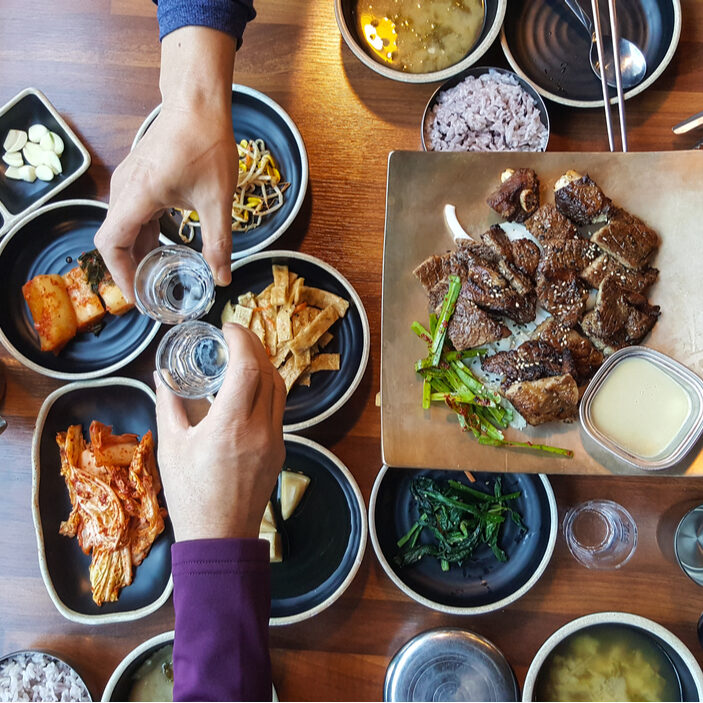
8 Dos and Don’ts: Korean Dining Etiquette
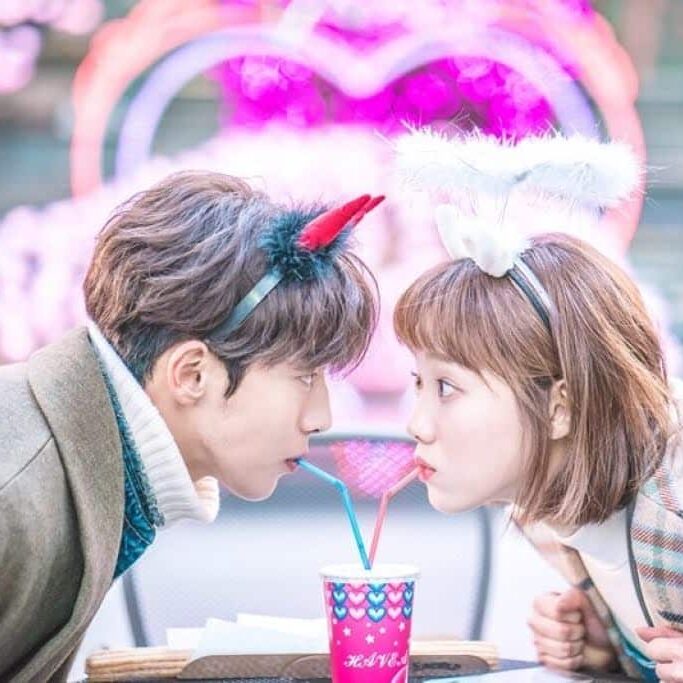
Valentine’s Day in Korea: 12 Opportunities to Express Love
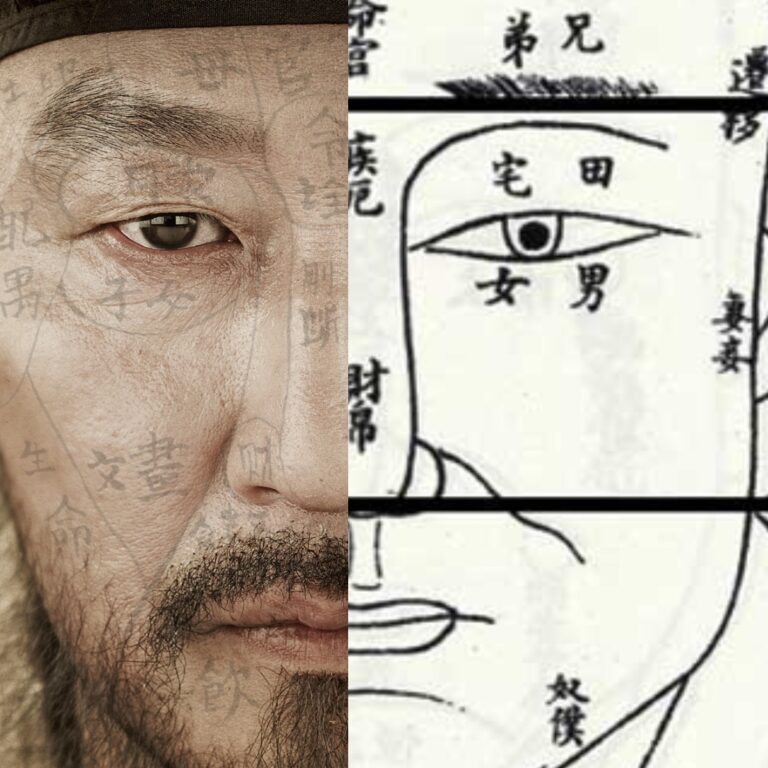
Gwansang: Guide to Korean Face Reading

90 Day Korean Inner Circle Review: Can You Learn Korean?
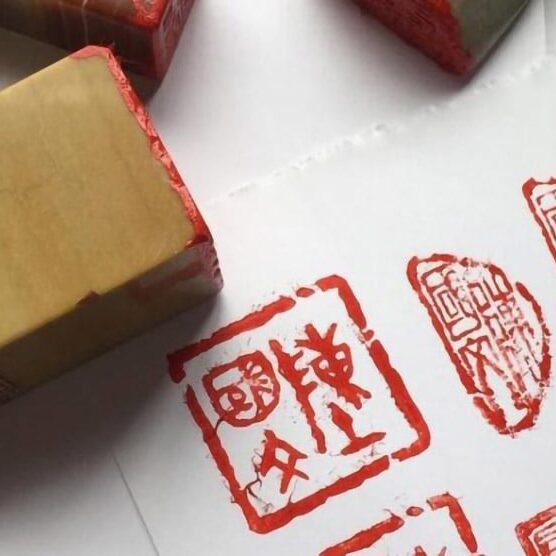
Korean Dojang: the Name Chop That Links You to the Founding of Korea
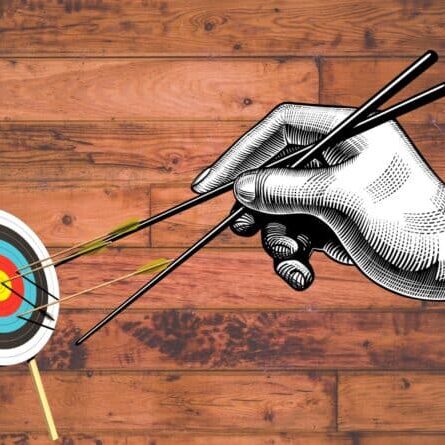
What Can’t Chopsticks Do? A Guide to Using Chopsticks Properly
Welcome to Best of Korea!
Please Sign Up for Updates
We hate spam. You can unsubscribe anytime.

Korean Etiquette: 7 Do’s and Don’ts in Korea
Korea has its own customs, traditions, and rules for manners, just like your own country does. Some of these customs are completely fine in your country, but are considered offensive in Korea. These fascinating differences are necessary to learn before your visit to Korea.

Table of Contents
- Korean Dining Etiquettes
- Basic Korean Drinking Etiquette
- Asking Someone’s Age in Korea
- Place Setting Rules for Dining in Korea
- Don’t Write Names in Red in Korea
- Never Sit in Priority Seats in Korea
- Take Your Shoes Off at Home in Korea
How KoreanClass101 Can Help You Learn More Korean
Today, KoreanClass101 is going to explain to you seven important Korean etiquettes in detail so that you can avoid making these mistakes while in Korea! Also, keep in mind that Koreans are not afraid of calling you out on behavior they find offensive, which is where our vocabulary learning will come in handy.
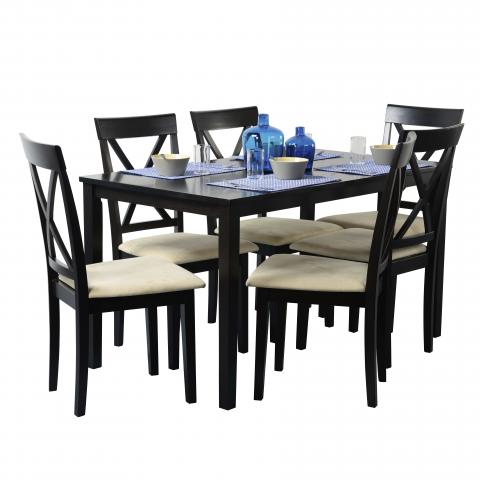
Do’s and Don’ts in Korea #1 : Korean Dining Etiquettes
1- do: wait until elders start eating their food.
In Korea, you cannot start eating until the elders grab the chopsticks and start eating their own meal. The order of eating has to be according to age . For example, if you are sitting with your grandfather, parents, parents’ friends, and your younger sister at a dining table, the order should be :
Korean Vocabulary List
- 할아버지 (harabeoji) – “grandfather”
- 부모님 (bumonim) – “your parents”
- 부모님의 친구 (bumonimui chingu) – “parents’ friends”
- 나 자신 (Na chashin) – “myself”
- 여동생 (yeodongsaeng) – “younger sister”
2- Do: Chew with Your Mouth Closed and Try to Hide the Bones
Try not to make noise when you chew your food in South Korea. It is considered rude if you do make any noise when chewing, so try to chew with your mouth closed.
Also keep in mind that Koreans eat grilled fish, marinated chicken, and so on. It is advised that if you have bones, you hide them by wrapping them in some tissue or placing them under the rice bowl.
- 생선 가시 ( saengseon gasi ) – “fish bone”
- 생선 가시를 발라내다 ( saengseon gasireul ballanaeda ) – “debone a fish”
- 우리 밥 먹을 때 조용히 먹자. ( uri bam meogeul ttae joyonghi meokja .) – “Let’s just eat quietly.”
3- Do Not: Leave the Table Until You Are Done with the Meal
If you need to go to the 화장실 ( hwajangsil ) “bathroom”, try to go before sitting at the dining table; it is considered rude to leave the table while eating. However, if you really need to leave the table for some urgent reason, the best way is to politely explain the situation to the eldest person.
Also note that it’s considered rude to place your elbow on the table as well, especially if you are dining with the elders or someone who is older than you.
4- Are You the Youngest Person in a Group? Rules to Remember
Here are a couple of important rules in the Korean table manner that you need to remember if you are the youngest person in a group:
When you go to a restaurant or prepare the dinner at home with your Korean homestay family, you are expected to prepare 수저 ( sujeo ) “spoon and a pair of chopsticks”, as well as other amenities such as water.
Also, you may need to grill the meats for elders or those of higher status when you go to a restaurant with other colleagues. However, this is not mandatory as the task of grilling the meats for everyone depends on who sits closest to the barbecue grill.
Have you started studying Korean lately and want to improve your listening skills? Listening Comprehension for Absolute Beginners

Do’s and Don’ts in Korea #2: Basic Drinking Etiquette
1- do: make sure everyone’s glass is full.
If you are the youngest, check to see if others’ glasses are empty, as it is rude to allow anyone to have an empty glass. Fill up the person’s glass first who is older or of higher status than you, by politely saying 한 잔 더 받으세요 ( han jan deo badeuseyo ) “Let me refill your glass.”
There are a couple of South Korean basic drinking etiquettes that will prove helpful when you go drinking with colleagues, friends, or elders in the future. Firstly, you need to hold the bottle and shot glasses with two hands when someone pours 막걸리 ( makgeolli ) “rice wine” or 소주 ( soju ) “Korean distilled liquor” for you. Also, it is polite to turn away from elders while you drink.
2- Do Not: Pour Your Own Drink
In Korea, it is considered rude to pour your own shot. Therefore, wait until someone offers to pour for you; this will usually be done by the youngest person. Sometimes, however, older or higher-status people may offer to pour for you. This usually means that the person wants to establish a great relationship with you, especially if the person is your boss or someone whom you cannot usually interact with in daily life. So, if he or she offers to pour you an alcoholic drink, accept it. If you refuse firmly, it may greatly harm the atmosphere . If you do not want to drink alcohol, just leave the glass as it is and order a different drink, or politely say 죄송하지만, 저는 술을 한 방울도 못 마십니다 ( Joesonghajiman, jeoneun sureul han banguldo mon masimnida ), “I am sorry, but I don’t drink even a drop.”
Do you want to learn Korean alphabet? Click here to learn Hangul: Hana Hana Hangul
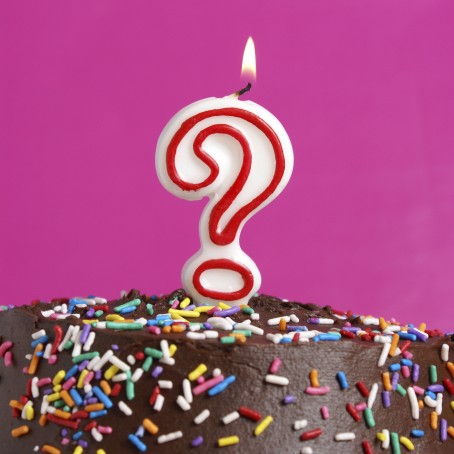
Do’s and Don’ts in Korea #3: Asking Someone’s Age
1- it is very normal to ask someone’s age.
It’s absolutely normal to ask someone’s age in South Korea, so don’t get offended if you’re asked. Seeing as it is rude to ask someone’s age in most Western countries, this is a great example of etiquette differences between countries.
Koreans ask your age in order to determine what kind of language they need to use when talking with you. For example, if you meet someone in class for the first time, you would ask 몇 년생이세요? ( myeot nyeonsaengiseyo ) “What year were you born?” or 나이가 어떻게 되세요? (nai-ga eotteoke doeseyo) “How old are you?”. Then, if he or she is older than you, you need to start using formal language and show respect to him or her.
On the other hand, if a person is younger than you, you can speak casually with them, whereas he or she must speak to you in formal language.
Did you know that international and Korean age are different?
Do you know how to say “Where are you from?” in Korean? Learn key Korean phrases on KoreanClass101 for free
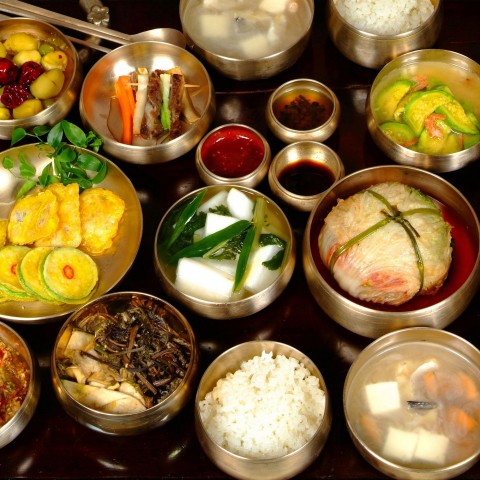
Do’s and Don’ts in Korea #4: Place Setting Rules for Dining
Did you know that there is a number of place setting rules for dining in Korea? For example, a spoon and a set of chopsticks should be placed next to the rice bowl, on the right-hand side. Also, a spoon stays to the left while chopsticks stay to the right.
Stew (such as Kimchi stew) is usually placed in the middle so that everyone can share the soup together, surrounded by many different kinds of side dishes such as: 김치 ( Kimchi – a Korean dish of spicy pickled cabbage) and 야채 ( yachae – vegetables).
Typically, 고기반찬 ( gogibanchan ) “meat side dishes” stay on the right-hand side and 야채반찬 ( yachaebanchan ) “vegetable side dishes” stay on the left-hand side of the dining table.
In summary:
- Right-hand side: Warm and hot dishes, watery food, meat dishes, and so on
- Left-hand side: Cold dishes and dry foods, vegetable dishes, and so on
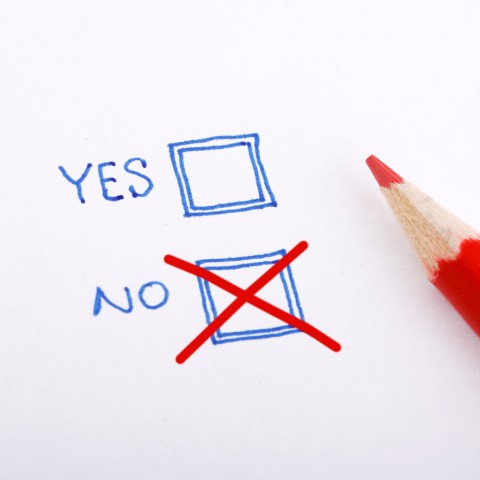
Do’s and Don’ts in Korea #5: Don’t Write Names in Red!
Did you know that it is considered extremely offensive to write someone’s name in red ink? Writing a person’s name in red ink means that he or she is deceased , and if he or she is still alive, it means that the person who wrote your name wishes that you were dead. 빨간 잉크 ( ppalgan ingkeu ) “red ink” was used in the past to write a deceased person’s name. So it should go without saying that you shouldn’t write your friend’s name down in red ink!
Learn these top 10 phrases in Korean and amaze your Korean friends
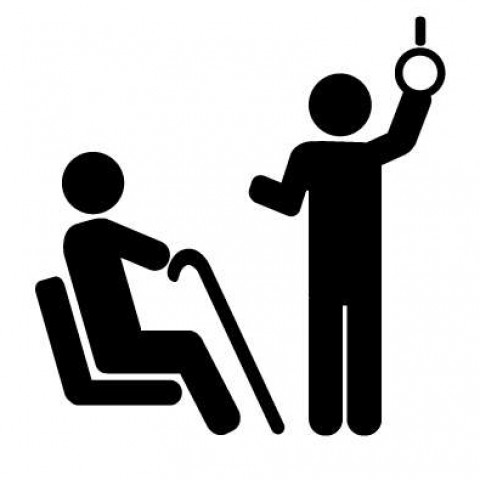
Do’s and Don’ts in Korea #6: Never Sit in Priority Seats
When riding on buses or subways, you should avoid sitting in the priority seats; they are for the handicapped, the elderly, and pregnant women. You can easily identify them because there is a label that says 노약자석 ( noyakjaseok ) “For the handicapped, the elderly, and pregnant women” above the seating area, depicting the profiles of the three groups. It is important not to take these seats even if they are empty .
This is what you are going to see at priority seats: 장애인, 노약자, 임산부, 영유아 동반자 좌석입니다 ( jangaein, noyakja, imsanbu, yeongyua dongbanja jwaseogipnida ) “Seats for the handicapped, weak, pregnant women or accompanied with baby.” Also, you will frequently hear announcements such as 노약자석에 앉지 마세요 ( noyakjaseoge anjji maseyo ) “Please don’t sit on priority seats” to let everyone know that these seats need to remain available at all times.

Do’s and Don’ts in Korea #7: Take Your Shoes Off at Home
In Korea, you will always find a 신발장 ( sinbaljang ) “shoes shelf,” or an area where Koreans keep their shoes. For example, if you are at a 레스토랑 ( reseutorang ) “restaurant” where you sit on the floor at a low table, you will need to take off your shoes beforehand. Also, when you enter someone’s house, you must take off your shoes and leave them at the entrance.
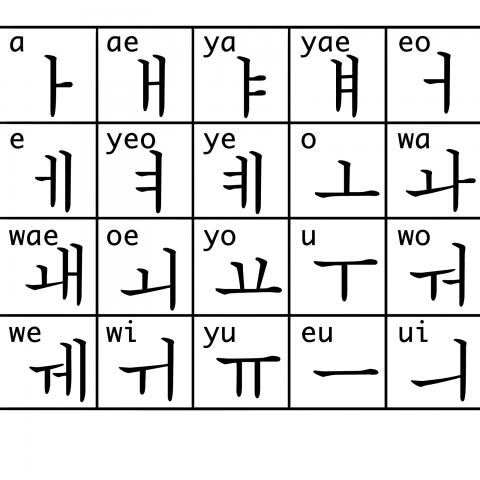
In summary, we introduced seven important Korean etiquettes and relevant Korean vocabularies for you to remember! KoreanClass101 has many study materials that you can download for free. Also, have you come across any Korean words that you don’t know? Look them up on KoreanClass101 dictionary with free audio for you to practice pronunciation! We are here to help you improve your Korean, so feel free to use our website anytime. You can learn more Korean etiquettes, along with polite ways to speak Korean, on KoreanClass101. Check out our Culture Classes and Business Korean Series!
Thank you and have a great day!
Or sign up using Facebook
Got an account? Sign in here

18 Useful Korean Greetings You Should Learn

How to Say I Love You in Korean – Romantic Word List

How To Say ‘Thank you’ in Korean

Let’s Learn about Korean National Anthem (History, Lyrics)

30+ Useful Korean Classroom Phrases and Words

60+Korean Restaurant Phrases: Korean Phrases for Ordering Food
Blood type personality in korea: what it says about you, how to learn korean with korean dramas.
- Austin's Orphanage
- Forum Spotlight
- Explore Korea
- Scheduled Maintenance
- Guest Bloggers
- Hyunwoo's Mindmap
- KClass Videos
- How Koreans Do It
- Humor in Korean
- Korean Holiday
- Korean Music
- Korean Language
- Korean Translation
- Advanced Korean
- Korean Alphabet
- Korean Grammar
- Korean Lessons
- Korean Online
- Korean Phrases
- Korean Podcasts
- Korean Words
- Tips & Techniques
- Listener Videos
- Media Coverage
- Feature Spotlight
- Steve's House
- Success Stories
- Team KoreanClass101
- Travels in Korea
- Word of the Day
- Words with Many Faces
- Visas, Immigration
Copyright © 2024 Innovative Language Learning. All rights reserved. KoreanClass101.com Privacy Policy | Terms of Use . This site is protected by reCAPTCHA and the Google Privacy Policy and Terms of Service apply.
- Jeju Island
- Sejong City
- North Chungcheong
- South Chungcheong
- North Jeolla
- South Jeolla
- North Gyeongsang
- South Gyeongsang
- Restaurants
- Cafes & Bars
- Adventure & Outdoors
- Festivals & Events
- Best in Korea
- Weekend Getaway
- Book your trip!
- Transportation
- Weather & Seasons
- Emergency Situations
- K Drama & Film
- K Beauty & Fashion
- K Tradition
- Expat Services
- Work and Study
- Where to Live
- Shopping Basics
- Foreign Language Hospitals
- Various Issues
- Search by Map
- Ask a Konnector
- Collab with Us
- Favorite Articles
- Favorite Places

Social Links

Korean Culture: Guide to Korean Culture and Etiquette.
🇳🇬 aiyanyo titi.
- April 4, 2021
Worried that you might offend your host or friendly strangers you meet whilst you’re in Korea? Then you need this essential Guide to Korean Etiquette.
Dinning Korean Etiquette
Keep this in mind when dining out:
Don’t Pour Your Own Drinks
If there are drinks being poured (such as for a toast), then don’t pour one for yourself. someone else will pour it for you – it’s considered rude to pour for yourself. The first time I went for lunch with my supervisor and colleagues, I noticed they took turns to pour drinks for each other. When pouring the drinks, you are expected to use two hands.

The two-hand rule is a way of showing respect to the person you’re serving. Either place your hand on your wrist, or somewhere along your arm.
Look Away When Drinking A Shot
Koreans love to drink soju (the world’s most popular liquor). When people get together, you are expected to drink your shot but not look at the person who poured it for you. I know subordinates do this with their superiors, but I am not very sure it is obtainable amongst peers.

Shoes Are Not Always Allowed Inside
Floors are kinda sacred in Korea. Shoes are not allowed in Korean houses but there are many restaurants in South Korea which have traditional floor tables with no chairs. If you see a restaurant with a shoe rack by the entrance, then you should take your shoes off before you enter.

Don’t Tip in Restaurants
Tipping is a big no-no in South Korea. The price you see on the menu is the price you will pay. In fact, people won’t accept any money you leave behind.
Don’t Lick Your Fingers When Eating
It’s considered dirty to lick your fingers and food should be eaten with chopsticks where possible (not easy with Korean BBQ or ribs!). You will always find wet tissues to clean your hands if you to.
Travelling Around Korean Etiquette
Here are some essential etiquette issues to know about when travelling .
Join the Queue.
In Korea, people wait patiently and queue up when getting on a bus, train or subway. There are lines to show where to wait and spaces to allow people to disembark. If you are visiting Korea, do your best to follow line and wait patiently.

Another thing to note is that there are sections for the elderly, pregnant women, and people on wheelchair. Try to avoid sitting on seats reserved for these sets of people.
Do not eat on transit.
It is illegal to eat or drink on the buses. Eating on the train, especially on long journeys, is usually fine. If you do have to eat, try not to litter, or spill your drinks.
Guide to Socializing Korean Etiquette
This guide will help you interact with people comfortably in Korea.
Shake Hands with Two Hands
This may seem trivial, but the handshake is a sign of respect in South Korea and doing it wrongly could be a sign of disrespect.

When shaking hands, shake with one hand and place the other hand somewhere between your wrist or elbow.
Avoid Using Personal Names Until You know a Person.
Some Koreans will happily tell you their full names and be happy to be called by their personal (first) names. However, if you’re unsure, or you’re in a business situation, it’s best to refer to the other person by their surname.
Respect for Elders
As with many cultures, and older people are respected more than younger ones. The same is obtainable in Korea. Age can dictate the way you act or behave to someone. You will probably be asked your age for people to figure how to relate with you.
Nationalism Is Strong in South Korea
Korea has a high level of nationalism and people take pride in their country and national symbols and holidays. Koreans are proud of their growing economic, cultural, and sporting achievements considering where they are coming from and the battles they have fought.
Related Articles
Related topics.
- korean life
- Life in Korea

Even after 7 years living in Korea, still have love for Kpop, Kdrama and everything K
Get Our Newletter
Subscribe now to our newsletter
Recent Articles

How to become a student in Korea
- 🇷🇴 Emilia Bucsan

Here’s How To Find A Job In Korea In Really No Time
- 🇵🇰 Majid Mushtaq

Best Books to learn Korean
Leave a reply cancel reply.
Your email address will not be published. Required fields are marked *
Save my name, email, and website in this browser for the next time I comment.
Input your search keywords and press Enter.
- Find Account / Password
Enter something special:

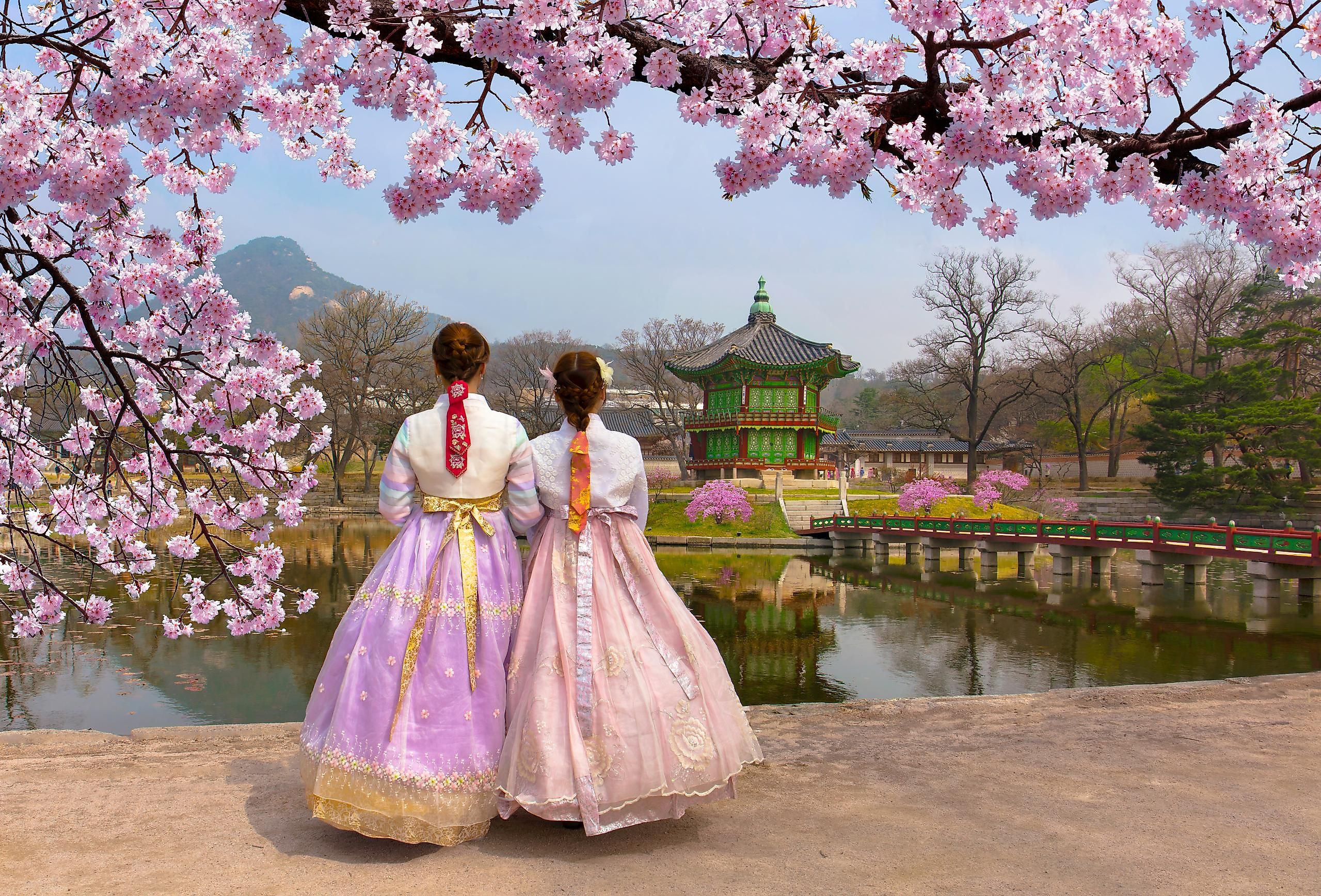
Understanding South Korean Etiquette: A Guide for Americans
With almost 52 million people residing in South Korea , it's a country where living closely with one another is the norm, especially in bustling cities. South Korea boasts a powerful sense of cultural unity, with 97% of the population being native Koreans and of the most homogenous nations in the world. While Americans might be given a pass on some of the cultural nuances, embracing and understanding South Korean customs can make interactions smoother and more rewarding.
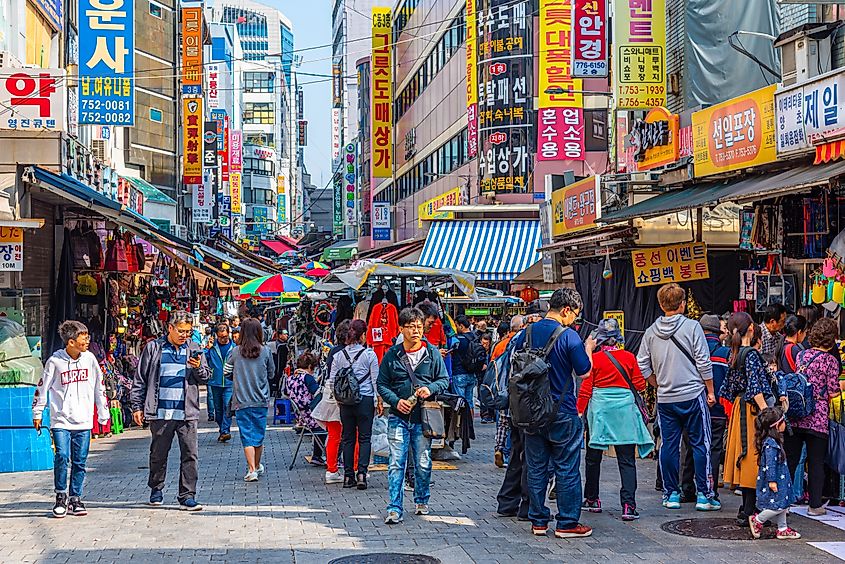
How to greet in Korean - Hello = Annyeong-hasimnikka
There are some basic rules to follow when being introduced to someone in South Korea.
The most important thing to realize going into a social situation is that there is a well-established social hierarchy, and understanding it informs both a great deal of verbal and non-verbal communication. In general, this hierarchy is based on offering respect to those who are older or in superior professional positions.
It is always best to be humble and assume that who you are talking to is above you in the social hierarchy. Offering an excess of respect is far more acceptable than too little and will be laughed off the same way your dad would make the terrible joke, "Mr. Smith is my father; call me Jim."
The key to making a good impression on an initial meeting is patience and attentiveness. If meeting a group of people, address each in turn, taking care to acknowledge each with a slight bow. Handshakes are common, but wait for the eldest individual to extend their hand first.
Greeting Customs Key Points:
- Over-politeness will never hurt.
- Use both hands when shaking hands.
- A polite bow is required; note how deep the other person bows, then bow slightly deeper.
- Give them your full attention; do not be distracted during an initial meeting.
- Wait to be introduced by a third party at social gatherings. Aggressive friendliness is not encouraged.
- When leaving a group, bow to them individually and thank them for their company.
Korean Eating And Drinking Etiquette
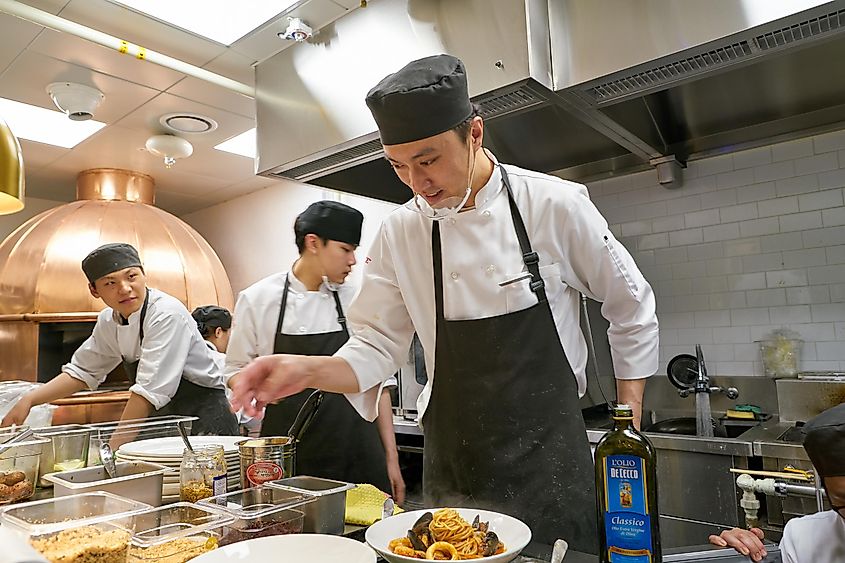
Food and drink is a huge part of Korean social interaction. Korean hosts will be excited to introduce their food and culture to a foreign guest. You will be encouraged to try multiple dishes and accept each suggestion and offer eagerly. Picky eaters are not common in Korea and refusing to try something because it is new could be seen as a slight against the person offering it. Koreans are extremely proud of their cuisine and will be very interested in how a Westerner reacts.
Food and drink will be offered and served, no one should pour their own drink. Ensuring that older individuals are served first, a drink will then be poured to younger people. It is expected that all guests should keep the pace set by the eldest or most senior attendee. If possible, everyone should remain at the table until the most senior individual indicates that the evening is over.
Never point with chopsticks or use them for anything other than their intended purpose. Chopsticks should be placed on the table neatly and sided by side when not in use. Do not leave them sticking out of a bowl of rice. This has symbolic connotations associated with funeral traditions.
Tipping is not expected or warranted for the vast majority of establishments. Servers make a fair wage and do not rely on tips to supplement their income. A few Western-style hotels or restaurants may add a gratuity for large groups. However, this is unusual. If you become a regular at a restaurant or bar, it is not uncommon to become friendly with the staff and owner. Small physical (not monetary) gifts can be offered to deserving staff in this scenario.
Key Points:
- Remember to serve others before yourself.
- Remove shoes when entering most restaurants. Watching other guests and taking cues from them will help inform of the correct way to behave.
- Be respectful of the food and the establishment, and complement the food that warrants it rather than criticizing other dishes.
- Be mindful of gestures made with cutlery, especially chopsticks.
- It is very important not to seem greedy or glutinous. The first offer of second helpings should be refused.
- Tipping is not required, except in certain rare situations. Follow the lead of those around you.
Business Dress Etiquette

Korean professionals favor conservative and functional attire. For men, a dark suit and tie are recommended. Facial hair is tolerated by western visitors. However, among Koreans, it is considered dirty and unprofessional. Other than wedding rings, it is unusual for men to wear jewelry.
For women, a conservative outfit is ideal. A business suit will never be the wrong choice. Heels are worn to work, to dinner, and in general, anywhere you might be seen in public. Be subtle with jewelry and accessories. South Korea is a nation that believes that less is more in this regard.
In general, Korea has adopted Western attire, and by dressing in a semi-formal manner, it would be hard for anyone to get the wrong impression.
- Dress conservatively and professionally.
- Facial hair is considered unprofessional.
- Jewelry on women is acceptable. However, body piercings other than earrings are not common.
The Exchange of Money, Gifts, or Documents
Gifts may be given in most arranged personal interactions. When giving or receiving any item two hands should be used, it is also advisable to fully acknowledge the person and not seem dismissive or distracted. A polite bow can punctuate the exchange will show thanks and humility.
If you have been handed a business card, reciprocate with your own and examine theirs before placing in your wallet or purse. Make sure to treat the card carefully, and make sure not to write notes on it.
Thank You = Kamsahamnida You're Welcome = Anieyo
- Accept all gifts (including business cards) with two hands.
- Never write on a business card you receive.
- Upon receiving a gift, if it is wrapped, you should open it later, a gift of equal value should then be offered in return.
- Thank you cards for gifts and dinners are expected and appreciated.
Conversation Etiquette Guide

At social gatherings feel free to make small talk, with sports, TV, and food all as safe topics. Refrain from criticizing anything related to Korea, and specifically Korean culture. Stay positive throughout the interaction.
Korean people are very nationalistic and proud of their country. Commenting on the success of the South Korean economy or recent sporting victories will be very well received. Showing an interest in their culture by asking questions is also a very good icebreaker. Do not be alarmed should salaries and other personal topics be discussed openly. This does not carry the same taboo as it does in North America.
- Respect the culture and actions of South Korea.
- Showing an interest in South Korean history, food, and politics will endear you to many.
- Very personal questions are often asked in initial introductions; do not be offended. Only answer what you feel comfortable.
More in Society

The Longest Sniper Kills in History

Which US States Have More Women Than Men?

Cities That Have Hosted The Olympics
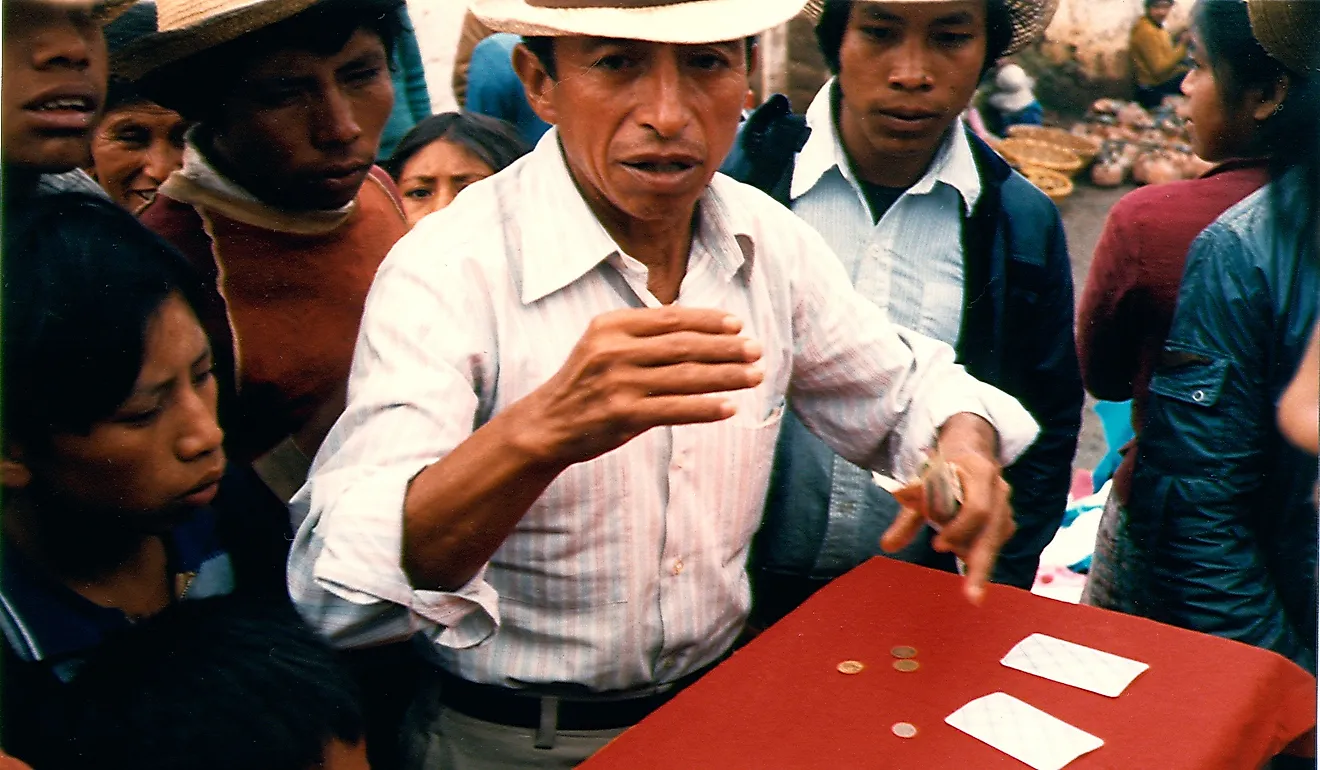
Countries That Gamble The Most
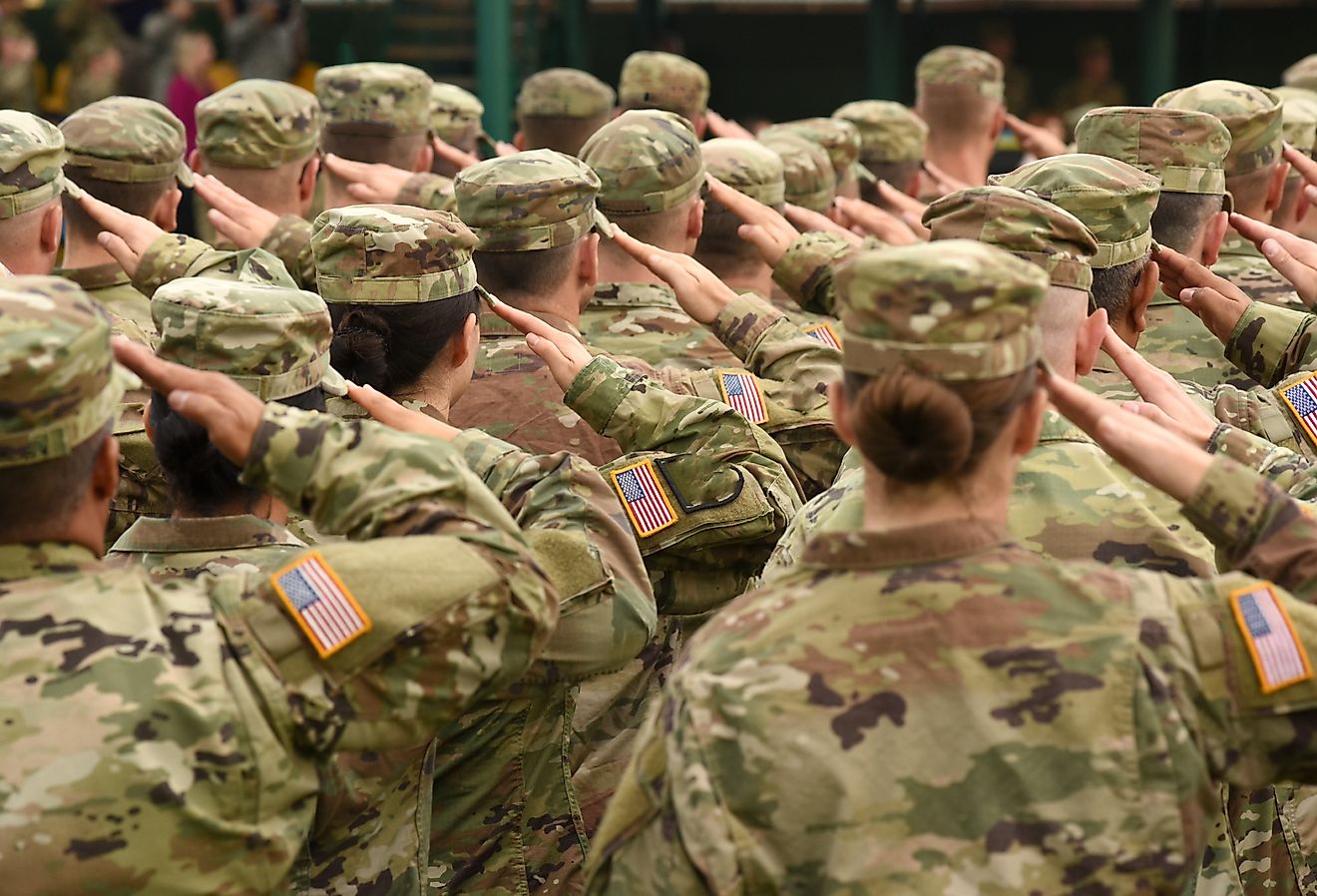
The Most Powerful Armies In The World

The Most Isolated Tribe on Earth

Countries Who Have Never Won A Summer Olympic Medal
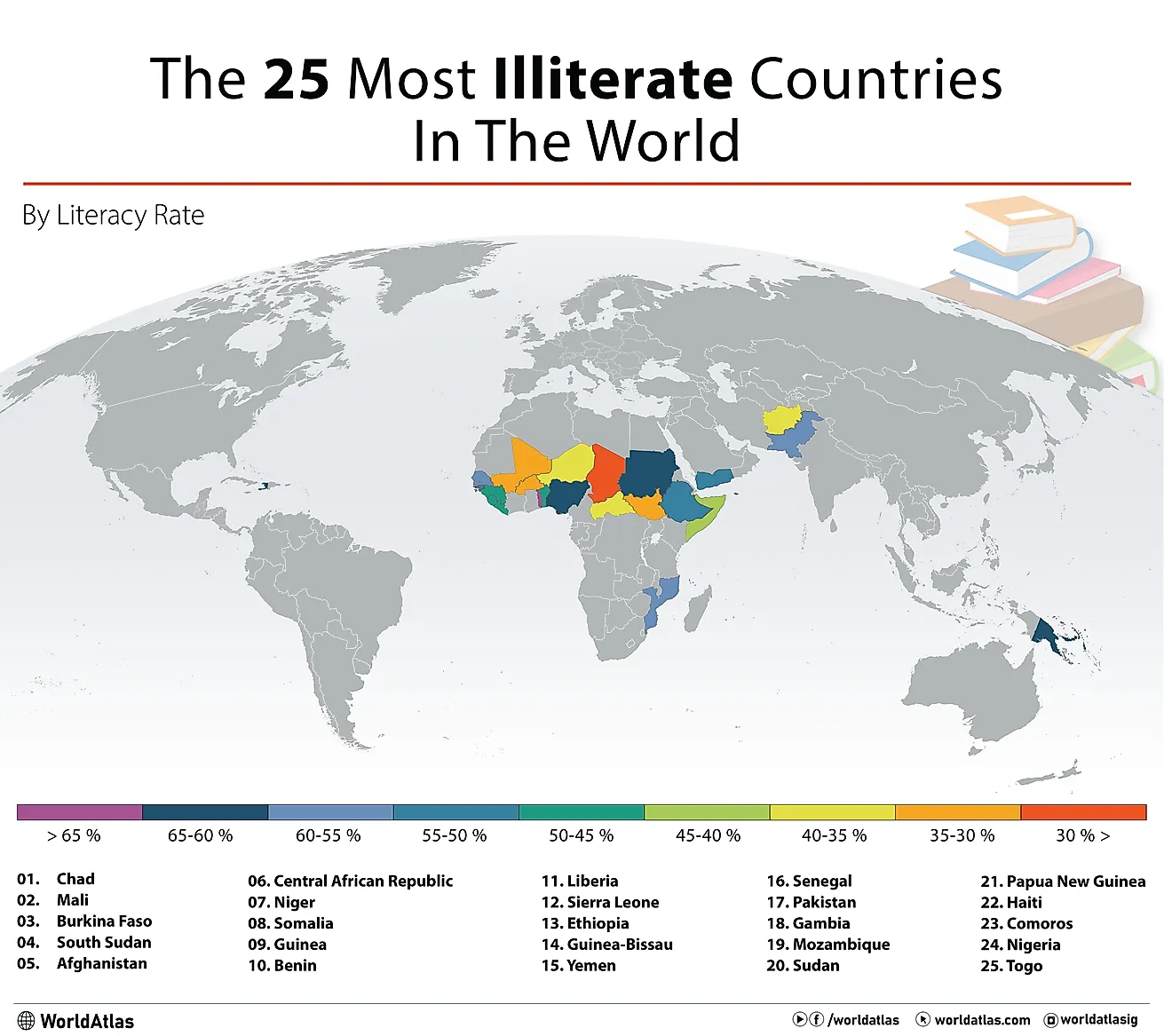
25 Most Illiterate Countries

- + 91 98111 90137

Your Guide to Korean Etiquette & Culture
Your guide to korean etiquette & culture.
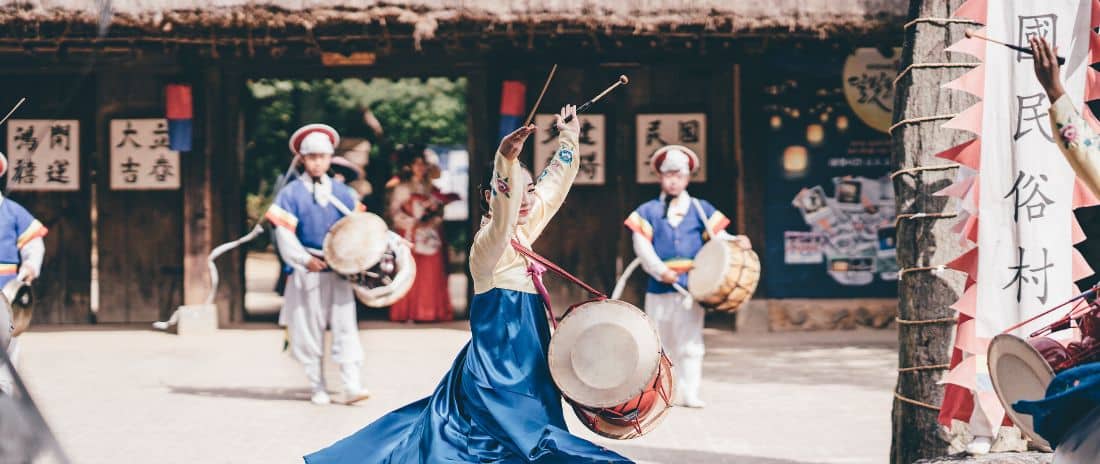
Please click the hashtags below to find out more!
- #Meeting People In Korea #Socializing In Korea # Korean Social Hierarchy #What To Avoid Doing
- #Religious Beliefs & Customs #Korean Work Culture
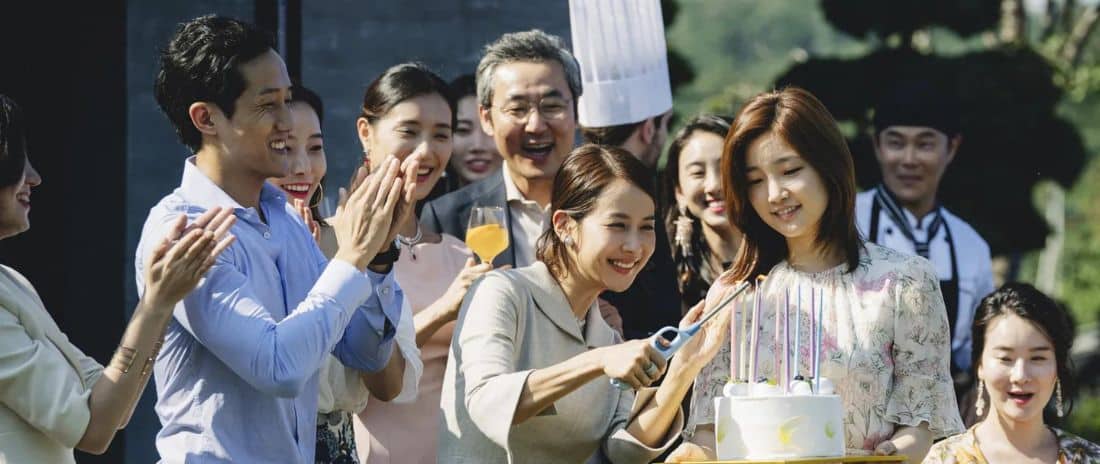
Korean Etiquette for Meeting People
In this part of the guide, we’ll learn how to meet and greet people in Korea. There are some important rules to remember, and we’ll also share easy ways to make Koreans feel comfortable when you meet them. By following these tips, you can make friends quickly and easily.
Making a Great First Impression in Korea
Whether you’re arriving at Incheon Airport or spending time with new Korean friends, these Korean etiquette tips will help you make a good impression and avoid awkward situations.
In Korea, first impressions are vital, and being formal is significant in their culture and language. Understanding how to meet and greet people properly can help you make friends and show respect for Korean traditions.
Here are three ways to meet and greet people in Korea:
Greeting: When you meet someone in Korea, it’s polite to do a slight bow. The deeper the bow, the more respect you show. But usually, a small bow is enough, unless it’s a very formal occasion.
Saying Goodbye: To bid farewell, you also bow or nod as a way to wish the person well on their journey. If you’re the one leaving, bow before you go out of the room or just before you get into a vehicle.
Handshake: In Korea, handshakes are common, especially among men. When shaking hands, it’s best to use both hands – either clasping the other person’s hands with both of yours or putting your spare hand on your wrist, elbow, or waist.
Making a Bad First Impression
Even billionaires can make etiquette mistakes when meeting people.
Bill Gates, for example, once made headlines in Korea for his ‘casual’
one-handed handshake with his hand in his pocket while meeting former Korean leader Park Geun-Hye.
Read here .
How to Be Polite in Korea
After introducing yourself to someone in Korea, it’s essential to avoid Korean etiquette mistakes, especially with physical contact. While friendly gestures like a pat on the back or a hug are common in the USA to make friends, they might have a different impact on Koreans.
Korean society values formality and conservative behavior, and maintaining a positive public image is crucial for harmony. Excessive body language can cause embarrassment and disrupt harmony. When unsure, it’s best to refrain from physical contact.
Here are three ways to avoid unintentionally offending Koreans when you meet them.
No hugging: Unless you’re close friends, avoid hugging or touching people in Korea. It can make strangers uncomfortable, especially older individuals.
Be mindful of body language: Be cautious with your body language. Crossing your legs in front of someone or waving your arms around near others can be seen as impolite.
Use proper names: It’s best not to use first names for strangers. Instead, address them with their title (e.g., Mr. Kim) or professional titles. Remember, in Korea, the name order is reversed – surnames come first, and first names come last.
Respectful Behavior in Korea
When visiting Korea, you might notice that older Koreans can appear a bit pushy, especially while waiting in lines or using public transportation. It’s because there’s an unspoken rule that gives them priority in such situations. If you happen to be in their way, they might gently push you to make room for themselves. It’s important to be understanding and allow them the space they need. Showing respect for their customs will help you have a smoother experience in Korea.
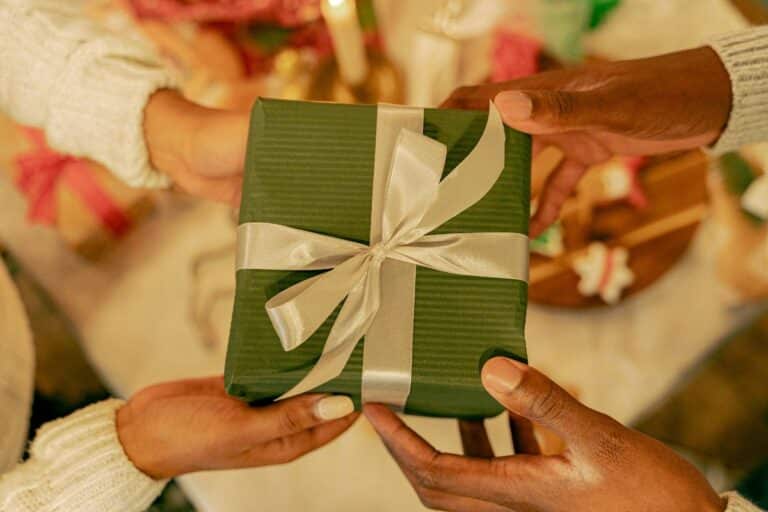
Korean Gift Giving Etiquette
Giving gifts in Korea is a nice gesture, but it’s essential to follow proper etiquette to avoid misunderstandings. When giving or receiving gifts from elders or at work, use both hands to show respect. It’s also polite to give a small bow during the exchange.
Among friends, small gifts are common on various occasions. However, avoid spending too much money on gifts, as it may put pressure on the recipient to give an expensive gift in return.
Remember these three important Korean etiquette rules for giving and receiving gifts in Korea.
Two-hand rule: When giving or receiving items, always use both hands to show respect. This applies to paying in shops, receiving gifts, and pouring or receiving drinks. It’s not as strict with younger Koreans or people you know well.
Return the favor: If someone in Korea gives you a gift, it’s a nice gesture to give them a gift of similar value at a suitable time. Western gifts, chocolates, cakes, or flowers are good choices. Make sure to wrap the gifts neatly.
Wait to open: When you get a gift in Korea, don’t open it right away. Look at the wrapping, say thank you, and put it aside. You can open it later when you’re alone, unless they ask you to open it immediately. Opening it too quickly might embarrass the giver.
Avoiding Gift Mishaps in Korea
To prevent offending someone, avoid giving gifts that are too expensive or culturally inappropriate, like sharp objects, sets of four items, or items with red writing, as they symbolize negative meanings like cutting ties or death. Also, stay away from dark wrapping paper, especially red.
Now, let’s explore some suitable Korean gift ideas.
Building Good Relationships in Korea
To maintain good relations with your Korean friends, neighbors, or acquaintances, follow these helpful tips. Polite conversation in Korea relies on subtlety and harmony, so it’s crucial to be able to understand when someone may feel uncomfortable or embarrassed, even if they don’t directly say it.
In the next section, this Korean etiquette guide will cover more about socializing, including dining out and drinking etiquette tips.
Here are three Korean etiquette rules to strengthen your connections in Korea.
Say “Yes”: In Korea, it’s not polite to say “no” directly to offers or invitations. If someone seems hesitant or avoids answering, respect their hint and drop the topic. When asked to do something, try to say yes or decline politely.
Take Hints: Koreans might not express things directly; they may give hints instead. Pay attention to subtle comments that might indicate an issue. Some people might feel too shy to complain directly.
Watch Your Hands: Pointing at people with your index finger is rude in Korea. Instead, use an open hand gesture. When beckoning someone, keep your palm facing down, not up to the sky.
Cultural Differences in Contact
In Korea, it’s common for friends and family to have close physical contact. Same-sex friends, both guys and girls, might hold hands, hug, or sit on each other’s laps comfortably. Even children and parents scrub each other’s bodies in saunas. These practices might feel surprising to people from different cultures who are not used to such close contact.
Making Friends in Korea: Socializing Etiquette
In this part of the Korean etiquette guide, we’ll talk about how group harmony and hierarchy play a role in everyday interactions, like dining together, seating arrangements, and sharing drinks. These tips will help you understand Korean culture better and make a positive impression when socializing with Koreans. By following these etiquette tips, you can build meaningful connections and show your appreciation for their customs and traditions.
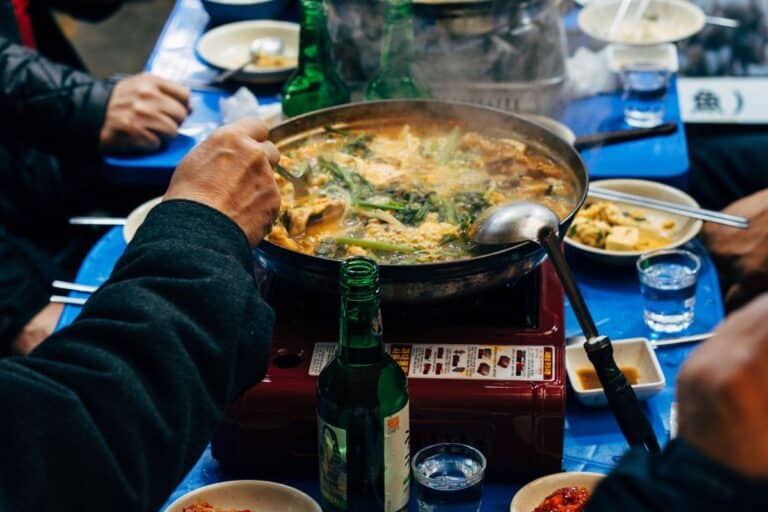
Etiquette Tips For Dining Out In Korea
In this part of the Korean etiquette guide, we’ll talk about how group harmony and hierarchy play a role in everyday interactions, like dining together, seating arrangements, and sharing drinks.
These tips will help you understand Korean culture better and make a positive impression when socializing with Koreans.
By following these etiquette tips, you can build meaningful connections and show your appreciation for their customs and traditions.
Wait for your seat: When you join a group meal, don’t rush to take a seat. In formal or work settings, seats are assigned based on social status. Let the senior or respected members sit first, then you can find your place.
Follow your elders: At meals, the oldest person is served first. Everyone waits for the senior person to start eating before they begin. This rule is more important in formal settings. The same applies for drinks, where a toast is made before drinking.
Be mindful of chopsticks: Chopsticks are important in Korean meals. Avoid pointing them at others as it’s rude. Also, don’t stand them up in rice, as this is a symbol of death and used only in funerals. Remember these chopstick etiquette rules when in Korea.
Enjoying Korean Meals Together
Eating a Korean meal is like experiencing Korean culture in a nutshell. It’s not just about the food; it’s also about following unspoken rules to create harmony. When you sit down for a meal in Korea, it’s all about sharing the experience with others, helping each other enjoy the food, showing respect, and prioritizing the group over individuals. It’s a beautiful way of coming together and fostering a sense of togetherness while enjoying delicious Korean dishes.
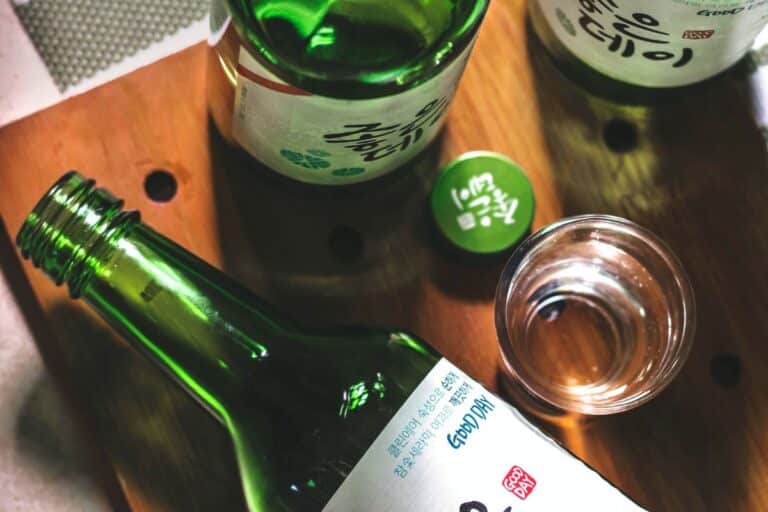
Drinking with Koreans: Etiquette Tips
Alcohol plays a big role in Korean social events, helping everyone relax and have fun together. Korean beer and soju are popular and affordable, so people often order a lot.
Drinks are served in small glasses, and it’s common to take a shot in one go, saying “one-shot!” Toasts are also popular, and you might be asked to give a speech or toast at a dinner or drinks party.
After a meal, some Koreans go for a “second round” at a bar or noraebang (karaoke) for more fun.
Here are three etiquette tips for drinking with Koreans.
Pouring Hierarchy: The most senior person starts by pouring a drink for the younger ones. After that, it’s the younger person’s responsibility to refill the elders’ drinks. If you’re unsure, play it safe and pour for others. Remember to use both hands when pouring as a sign of respect.
Don’t Pour for Yourself: Avoid pouring your own drink. In Korea, there’s a belief that doing so will prevent you from getting married. Instead, pour for others, and they’ll pour for you too.
Turn Your Head: When you drink, avoid facing older people directly. Turn your head to the right or left and cover your mouth with your hand while drinking as a sign of politeness.
Cheers, Korean Style!
When you say “cheers” in Korea, hold your cup with both hands. Make sure your glass is lower than your seniors’ to show respect. In Korean, “cheers” is “geonbae,” which means “empty glass.” Your Korean hosts might have many more expressions or jokes for toasts.
Paying the Bill in Korea
In Korea, it’s interesting that even though people share and enjoy meals together, the way they handle paying the bill is different. Instead of splitting the bill, one person usually pays for the whole meal. The situation determines who pays, with work or formal dinners being more structured than outings with friends.
In a work setting, the boss or the most senior person often pays. If someone invites you, they’ll likely cover the bill before the meal ends to avoid any awkwardness. With friends, you might take turns paying.
Remember these three etiquette tips for settling the bill in Korea and avoid arguing about it to avoid embarrassment.
Who Pays the Bill?
In Korea, the older and more senior person usually pays the bill. Younger ones show respect by serving and pouring drinks during the meal. Among friends, someone may offer to pay for everyone.
Return the Favor:
If a friend treats you, be sure to treat them another time. Don’t openly offer to pay in advance as they might feel burdened. Instead, invite them out, and when it’s time to pay, rush to the counter before them.
No Tipping:
In Korea, tipping isn’t common. There’s no need to leave money as a tip, as it might be returned to you. A service charge is rarely added to the bill.
Feeling the Warmth of ‘Jeong’ in Korea
‘Jeong’ is a special Korean idea that means feeling warmth and care for someone and wanting to help them. You might experience jeong when someone unexpectedly treats you to a meal. It comes from the belief in taking care of each other and creating harmony in society. This concept shows how much Koreans value their relationships with others and their sense of responsibility toward the community.

Being a Great Guest in a Korean Home
Visiting a Korean friend’s house is a big honor because homes are usually private places for family and close guests. To show respect, follow some simple etiquette rules. Take off your shoes when you enter and bring a gift. Also, remember the eating and drinking etiquette tips we mentioned earlier.
As a guest, don’t pour your own drinks, eat with others, and be ready to give a speech or two if you’re drinking. When it’s time to leave, thank the host and offer to host them in return. The host might walk you out, which is a sign of respect.
Follow these three ways to be the perfect guest when visiting a Korean friend’s house.
Bring a Gift: If you’re invited to someone’s house, it’s nice to bring a small gift like sweet foods or bread. Flowers are also good, but keep the gift simple, so the host doesn’t feel obliged to give something expensive in return. Gift wrapping is appreciated.
Remove Your Shoes: After a respectful bow of greeting, remember to take off your shoes. All Korean homes have a place for removing shoes and wearing slippers inside. Wearing shoes indoors is considered unlucky and unclean.
Toilet Slippers: If you need to use the restroom, you’ll need to change into separate slippers provided for the bathroom. Don’t forget to take them off when you’re done! This is also common in traditional Korean restaurants.
The Special Guest
In Korean culture, jeong is significant, and it applies when visiting someone’s home. If you’re invited to a Korean home, they’ll treat you like family. To show respect, be punctual, bring a gift, and avoid saying or doing things that might upset them. It’s essential to be mindful of their customs and make a good impression as their honored guest.
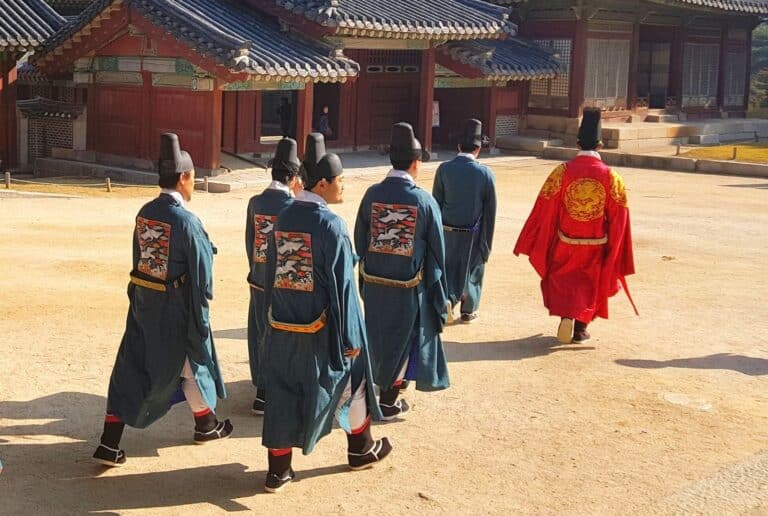
Understanding Korean Social Hierarchy
To grasp why Korean etiquette is important, let’s explore the Korean social order and hierarchy. From ancient teachings to modern culture, there are fascinating aspects that shape Korean behavior.
Discover the five different relationships in Korean society and how they affect addressing people by their names. Learn about kibun and nunchi, crucial aspects of Korean culture. Before diving into these details, let’s get an overview of Confucius, who greatly influences Korean social hierarchy.
The Influence of Confucian Teachings in Korea
Over 2,500 years ago, a wise Chinese philosopher named Confucius shared important teachings. These teachings still strongly impact Korean society today, making Korea the most Confucian society in the world. Confucius believed in harmony, caring for others, and putting the group’s needs before our own, making Korea a collectivist society.
These teachings shaped Korean morals, laws, and etiquette. Despite sometimes being confusing to Western visitors, Korean culture is welcoming and friendly. The positive aspects of this influence include respect for elders, generosity to strangers, and avoiding conflicts.
Modern Korea reflects this through friendly service at places like restaurants and cafes, where tipping isn’t common. You’ll also see kindness on the subway with reserved seats for the elderly or those in need. Koreans are often ready to help strangers without expecting anything in return. If you visit Korea alone, you might meet friendly locals who want to chat and learn about your culture.
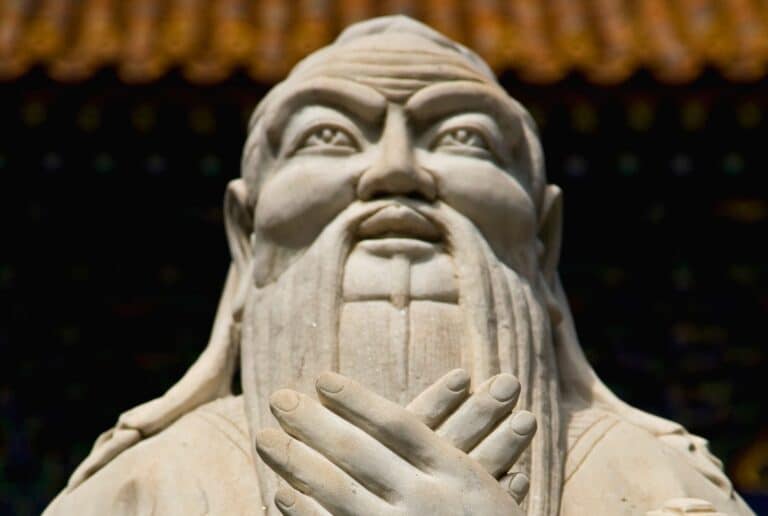
Navigating Cultural Differences in Korea
Confucianism has many positive aspects, but there are some things to be aware of. In Korean culture, group harmony is essential. Loud or offensive actions, like crossing your legs or hugging, can make people uncomfortable. They may not mention it to avoid embarrassment or conflict.
For travelers visiting Korea, the clash between Western (individualistic) and Korean (collectivist) cultures is usually not a big issue, as tourists are seen as outsiders. But if you plan to live in Korea, understanding that the group comes first is crucial. Speaking up and being loud is not valued. Humility and following rules are important.
Despite cultural differences, both Americans and Koreans value friendship, generosity, and respect. The way these values are expressed might differ, but they share common morals and beliefs.
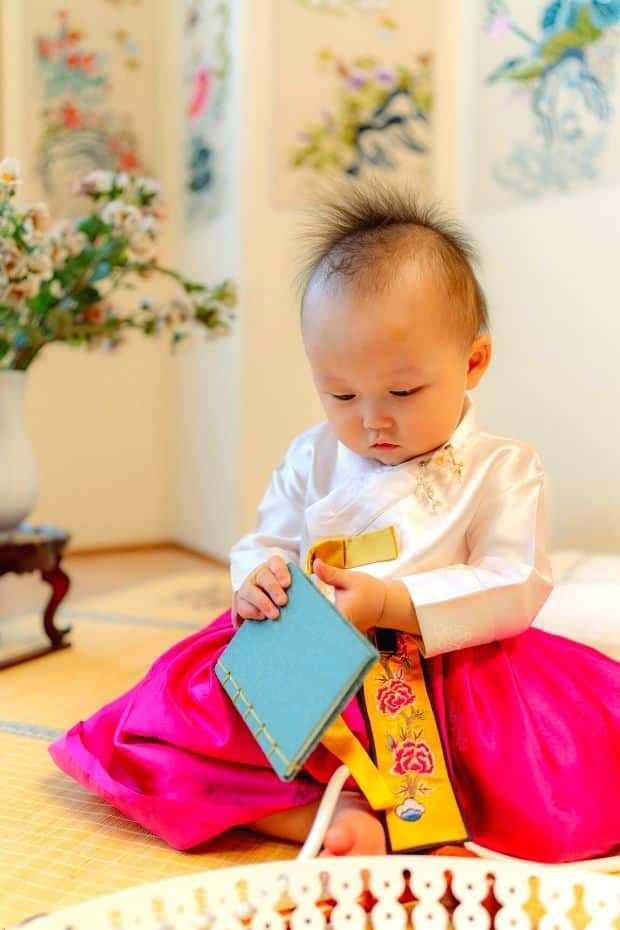
Korean Social Structure Based on Age
Confucian teachings have influenced a strict social structure in Korea, where age and social status matter. People’s standing is determined by their family, upbringing, wealth, education, and job, though these factors are less crucial than in the past.
In traditional Korean society, there are five hierarchical relationships: King to subject, husband to wife, father to son, elder to younger, and friend to friend. Only friendships are considered equal, so Koreans often befriend people of similar age to avoid hierarchy rules.
Knowing someone’s age helps you understand their position in the social hierarchy and how to behave with them. It’s common for Koreans to ask someone’s age directly or indirectly. While it might surprise some, it’s a normal part of social interaction, and Koreans don’t feel embarrassed to ask.
If you’re unsure about someone’s status, it’s best to be respectful and polite, which is good advice in any situation.

Understanding Kibun & Nunchi in Korea
In Korea, there are hidden aspects of etiquette and culture called ‘kibun’ and ‘nunchi’ that can be tricky for visitors to grasp. To navigate social events, it’s crucial to know why kibun and nunchi are important.
Kibun is a person’s sense of face, pride, feelings, and honor, tied to their position in society and how others respect them. Damaging someone’s kibun hurts their dignity and pride, so Koreans avoid this, even if it means telling small lies or avoiding conflicts.
Nunchi is the ability to sense others’ feelings and maintain everyone’s kibun harmoniously. People use body language and listen to the tone of voice to understand nunchi.
Kibun and nunchi are complex concepts that guide social interactions, even if confrontations are avoided, sometimes at a cost.

Language and Korean Social Hierarchy
In Korea, language reflects respect and social hierarchy. There are three types of speech: informal, formal, and respectful. Respectful speech is for elders or superiors, like in shops and restaurants to show respect to customers.
Formal and respectful speech are called 존댓말 (jon-daet-mal), while informal speech is 반말 (ban-mal). They are mostly the same, but respectful speech has different words for some things, especially personal topics like family.
To show respect, you can address someone by their job title or relation, like calling them ‘boss’ or ‘aunty’. If you don’t know their name, you can call them 선생님 (seon-saeng-nim), which means ‘teacher’, a respected position. If they are your peer, you can use their name, but add the honorific 님 (nim) or 씨 (sshi).
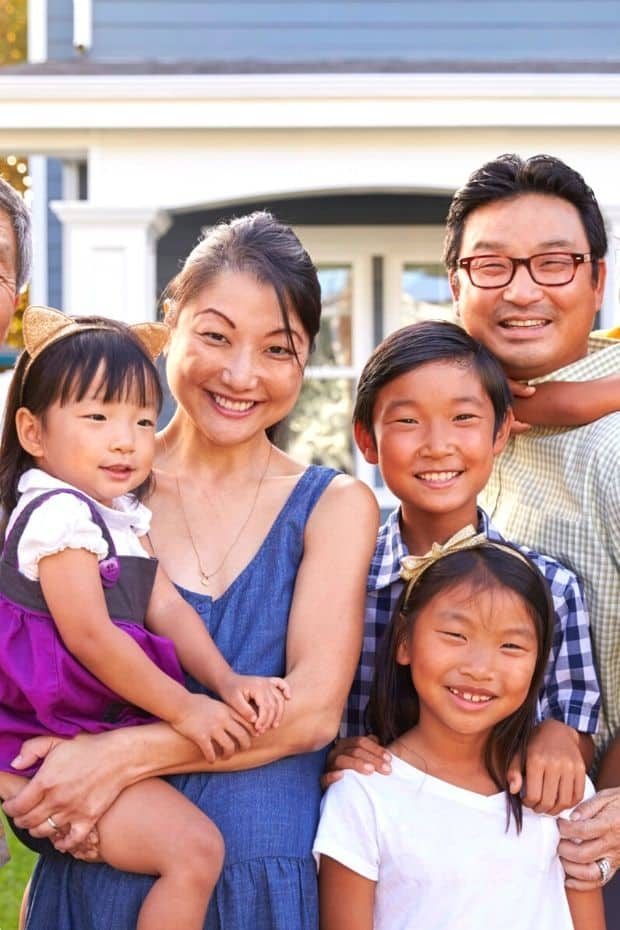
Family First In Korea
Family is highly important in Korea, like in many other countries. Their strong family ties and traditions are influenced by Confucian ideals. Filial piety, which means respecting parents and elders, is a big part of Korean family life and etiquette.
Parents take care of their children and support them in various ways, like spending money on their education and helping them buy a home. Children are expected to respect and obey their parents, and later, take care of them when they are older.
Arranged marriages are still common in Korea, where parents and friends help find life partners. Divorce rates are low as getting divorced was seen as a rare and difficult decision.
In Korea, family names are different from the US. Children usually take their father’s surname, and married women keep their own surname. The oldest son traditionally takes on the responsibility of caring for the family and their parents in their old age.

The Powerful Korean Ajumma
When talking about Korean social hierarchy, we must mention the ajumma (아줌마) – married, middle-aged women often called “aunty”. You’ll find them everywhere in Korea, bustling around, chatting, and making their presence known.
Ajummas seem to enjoy breaking the rules, pushing their way onto public transport, talking loudly in public, and dressing in vibrant, eye-catching outfits. They don’t conform to traditional social norms!
If you’ve seen the show “Kim’s Convenience”, Umma’s character is a great example of a Korean ajumma, though she might need a bigger perm!
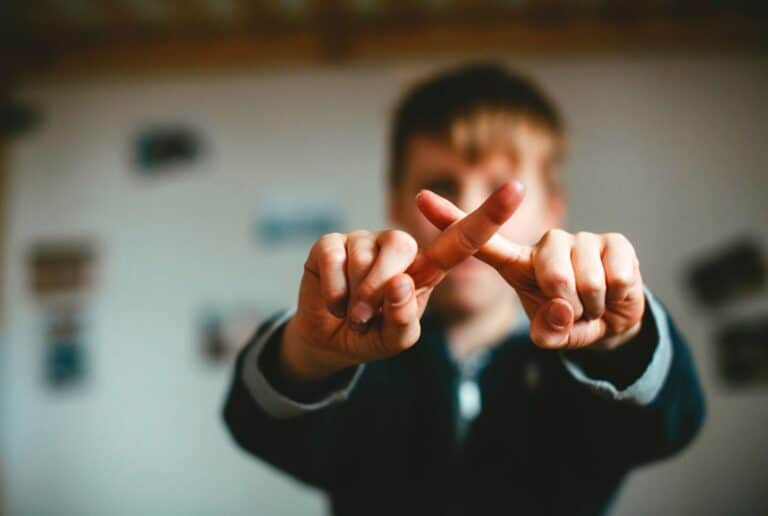
Korean Etiquette Taboos: What to Avoid
Korea is a friendly and tolerant society, but it’s best to steer clear of cultural mistakes that might upset your Korean friends or hosts. While there are many ways to unintentionally offend someone, remembering a few key etiquette taboos can save you from trouble and awkward situations.
Some taboos are related to eating, like not pointing with chopsticks, not wearing shoes inside restaurants, and using wet wipes instead of licking your fingers. Others are about personal space, so be mindful of getting too close to others, even if you admire K-Idols!
Here are six simple etiquette taboos to keep you out of trouble.
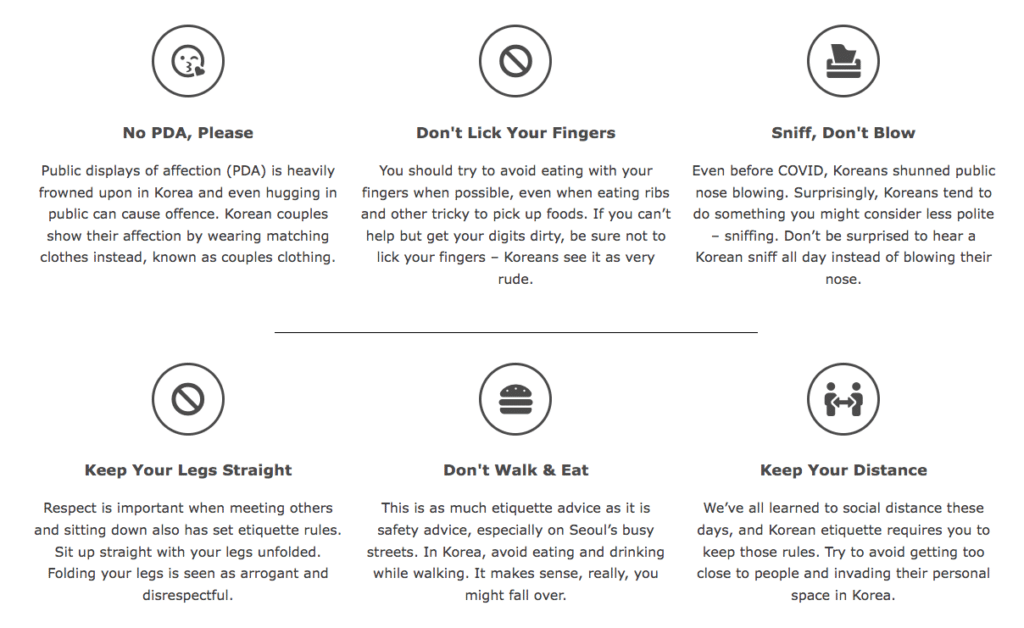
Beware of Deadly Korean Superstitions
Modern Korea is known for its technology and entertainment, but it also holds deep superstitions based on traditional beliefs. These superstitions may surprise those unfamiliar with Korean and East Asian cultures, as they involve accidentally wishing harm on others or inviting bad luck.
For example, using red ink, certain numbers, or certain chopsticks can be associated with death and funerals. Another peculiar superstition is the belief that leaving electric fans on at night can be fatal. Since the 1920s, some Koreans have feared the “whirling blades of death” from electric fans.
Here are three spooky superstitions to watch out for in Korea.

Discovering Korea's Religious Diversity
Korea is a country with various religious beliefs, but a significant number of people don’t identify with any religion. However, you’ll find interesting customs and practices among the people. Some visit fortune tellers before marriage, while others pay respect at Buddhist temples and hold ceremonies to honor their ancestors.
The two main religions in Korea are Buddhism and Christianity, but they have different histories and origins. Buddhism has been in Korea for centuries, while Christianity entered the country through Chinese scholars and faced challenges throughout its history.
Korea also has ancient animistic and shamanistic traditions predating both Buddhism and Christianity. If you wish to visit temples, shrines, or churches, remember to do so respectfully. Shoes are not allowed inside temples, and eating or drinking may be restricted. It’s important not to disturb monks or priests during their worship or ceremonies. Treat these places with the same respect as you would as a guest in someone’s home.
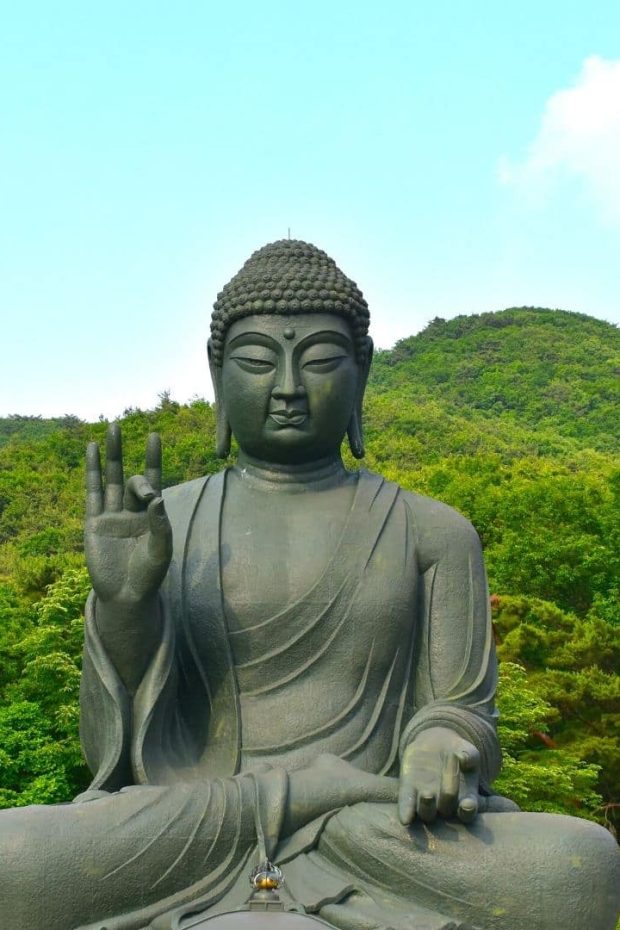
Religions in Korea: Buddhism and Christianity
In Korea, there are two main religions – Buddhism and Christianity. Even though you might see many Buddhist temples when traveling in Korea, the largest religion is Christianity. Around 20% of Koreans are Protestant, 8% are Catholic, and 16% follow Buddhism.
When you visit Korea, you’ll notice many churches with bright red crosses in cities, while Buddhist temples are more common in the countryside, especially near national parks. Buddhists have a strong connection with nature and mountains.
If you want to learn about Korean Buddhism, consider a temple stay. It’s a great opportunity to experience the daily life in a Buddhist temple, have conversations with monks, and even spend a night there.
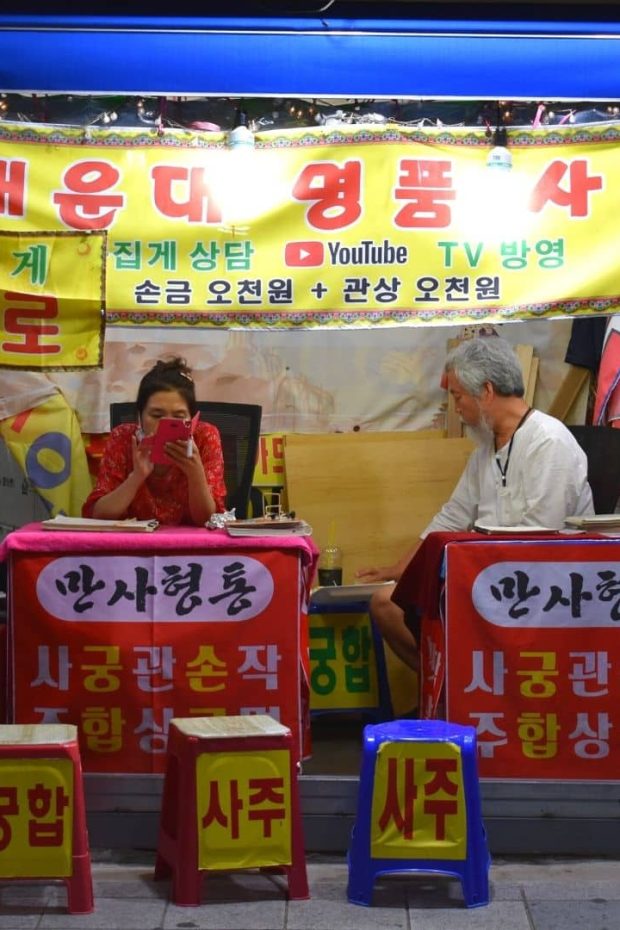
Traditional Beliefs in Korea
Besides Christianity and Buddhism, there are other traditional beliefs in Korea. Korean shamanism, an ancient belief system, was widely followed in the past. It involves worshipping gods, nature spirits, and ancestors. Even the recent President of Korea believed in it.
There are around 150,000 Korean shamans who act as intermediaries between the spiritual and material worlds. They use rituals like songs, dances, and prayers to solve people’s daily problems.
Fortune telling and tarot are also popular in Korea, with over 300,000 people claiming to communicate with spirits. Fortune tellers can be found all over Korea, offering their services before important events like marriage, exams, or the new year.

Korean Business Etiquette & Culture
If you’re a business traveler in Korea, it’s crucial to understand Korean etiquette and cultural norms. Confucian principles and social hierarchy play a significant role in the business world.
To succeed in Korean business, be friendly, trustworthy, honorable, and show respect in both work and social settings. Building strong connections often happens outside the office, like sharing drinks of soju.
In Korean companies, following etiquette and cultural norms is even more critical than in social or family settings. Pay attention to kibun and nunchi – avoid conflicts and never make anyone lose face due to your actions. When giving or receiving items, use both hands to show respect. Bow when greeting and leaving someone, and try speaking some Korean to make a good impression.
The work ethic in Korea may be different from the US. Koreans, especially in big corporations, like Samsung, work long hours and might stay late at the office, sometimes until midnight. Working on weekends is expected in some cases, but not that common. Koreans find it challenging to say no to requests, which can lead to extra hours of work when asked to do something.
Family plays a significant role in the Korean business world. Many major companies, including Samsung, are run by families, and family members hold management positions throughout the organization. This creates close connections between different business units, making it confusing for outsiders to understand the company’s internal dynamics and politics.
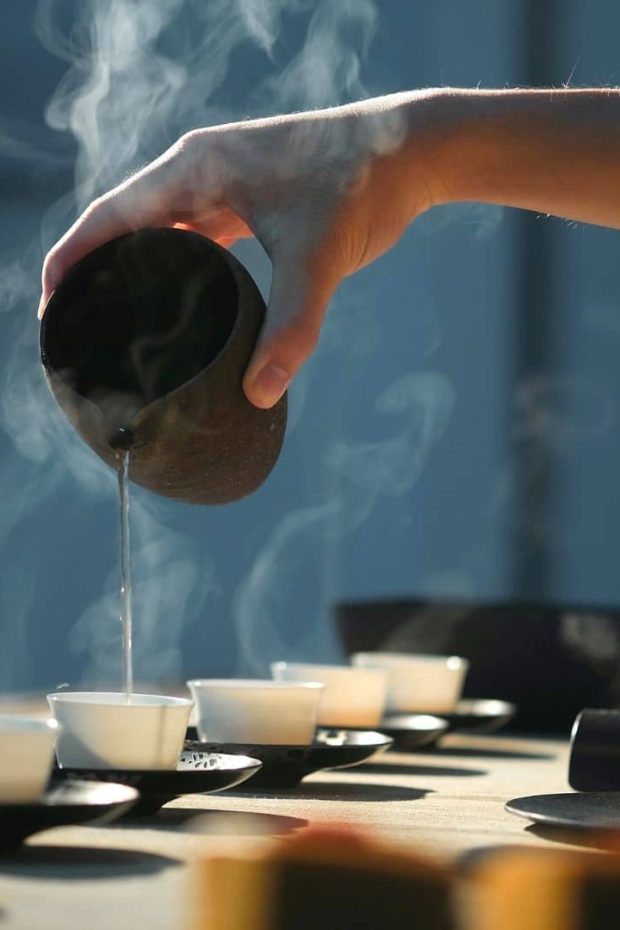
The Power of Teamwork in Korean Business
In Korea, teamwork and group harmony are crucial for business success. People in the workplace spend a lot of time building relationships and staying connected with others, even after leaving a company.
The Korean workplace follows a strict hierarchy, where bosses give orders and expect employees to follow them without questioning. Challenging these orders is considered impolite and can embarrass the manager.
Korean companies put a lot of effort into boosting team spirit. They often organize team-building activities called “membership training.” These activities can include outings, meals, or even short vacations within Korea. Companies set aside funds for these events, considering them an investment in team harmony. However, this tradition is changing, especially among younger generations who value more time with their families.
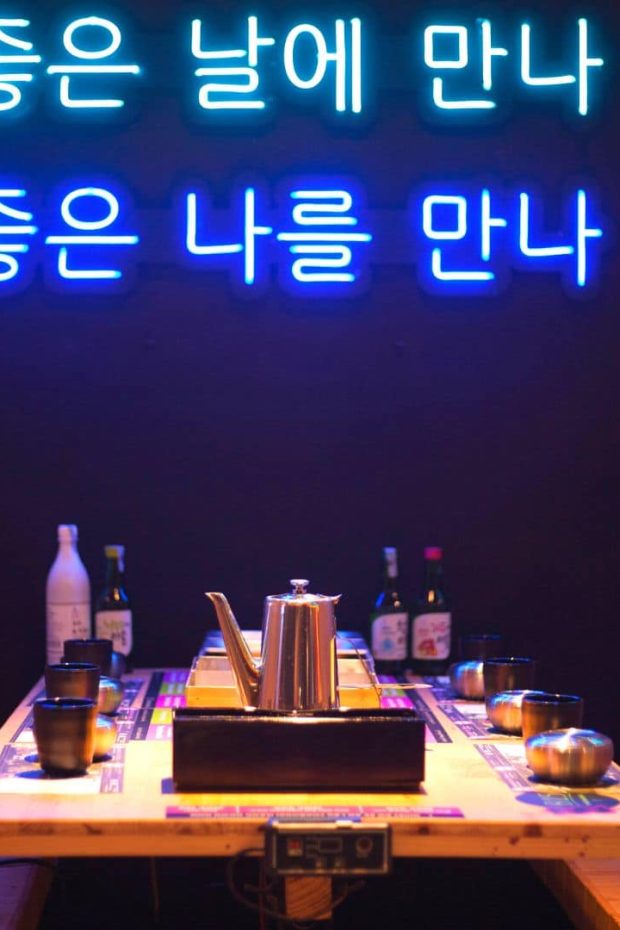
Korean Work Parties: A Fun Way to Bond
In Korea, work parties are common and important for employees and managers. These gatherings offer a chance to relax, connect with colleagues, and show respect to superiors.
At work parties, people often drink soju, a popular Korean alcohol. Remember the etiquette rules we talked about earlier, like pouring drinks for your seniors and waiting for them to eat first.
Be careful with soju because it can make you drunk quickly. You don’t have to drink a lot if you’re not comfortable. Just join the first toast, and then you can leave your glass full for the rest of the night. Others will refill it for you if it’s empty.
Discover More About Korean Culture and Etiquette!
If you’re curious to learn more about Korean culture and etiquette, we have plenty of interesting articles for you! Explore topics like Traditional Korean Funerals, Korean Weddings, and Valentine’s Day traditions in Korea.
Dating in Korea can be a bit confusing with not just one romantic day, but 12 Korean Romantic Dates throughout the year! Also, find out how Koreans use Blood Types to determine someone’s personality.
Want to understand why Korea has become a cultural powerhouse and why K-Culture is so exciting? Read our in-depth guide on How South Korea Became the Capital of Pop Culture.
If you’re interested in visiting cultural sights, we have a list of Seoul K-Drama Filming Locations for you to explore. Plus, check out our recommendations for delightful Korean children’s books to learn more about Korean culture.
If you’re planning to travel to Korea, head over to our South Korea Travel Guide to start planning your trip.
Remember, this guide only touches the surface of Korean culture and etiquette. There’s so much more to discover about Korea’s rich and unique traditions, customs, and beliefs. Keep coming back to Best of Korea for more fascinating insights and articles!

DYNASTY HOLIDAYS PVT. LTD. Plot No-33 Second Floor, Pocket 16, Sector-24 Rohini Delhi 110085 T : +91-9811190137 +91-9811900137 E : [email protected]
DYNASTY KOREA CO. LTD #516-102 Sk-Hub Officetel Samildaedo 461, Jongro-gu Seoul, Korea T : +82-2-736-0338 MB : +82-10-6850-0338
Follow Us to stay Updated!
- Photo Gallery
- Privacy Policy
- Terms of Services
- Payments and Cancellation
- Feedback & Complaints
Destinations
- Gyeonggi-Do
- Chungcheong-Do
Popular Attractions
- N Seoul Tower
- Bukchon Hanok Village
- Nami Island
- Gyeongbokgung Village
- Jeju Island
- Haeundae Beach
- Haedong Yonggungsa Temple
- Changdeoggung

Korean Manners and Etiquette: Do’s and Don’ts of First Meetings
- Korean Culture
- business etiquette
- business etiquette in korea
- drinking etiquette in korea
- etiquette in korea
- korean etiquette
- korean manners
- manners in korea
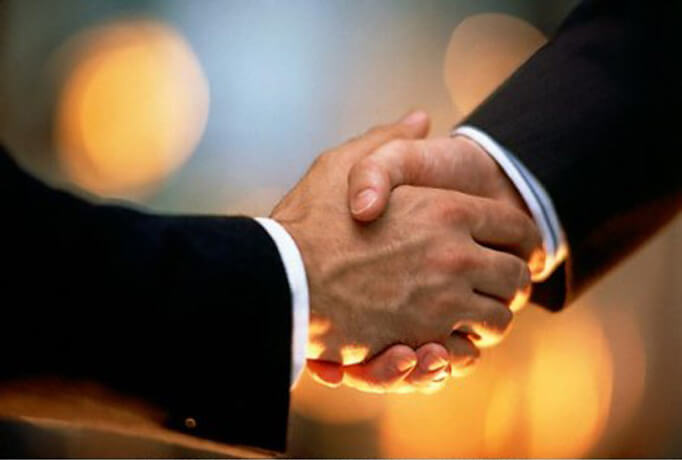
First time meetings in Korea are not always as simple as “hello.” There’s a lot of times people might be offended. Find out the do’s and don’ts of Korean etiquette when meeting someone for the the first time!
Informal Settings
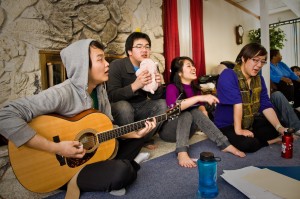
Courtesy of Dustin Cole
If you’re meeting friends of friends, your internet penpal, or maybe even a few chaps at the pub, greeting etiquette in Korea is quite relaxed. Most informal settings only require a small, short bow and a smile. Hand waves to say hi or bye are also quite common (but are more casual). To make an even better impression, say hello in Korean. And… that’s about it. Sorry, there’s no secret handshake or codeword for picture perfect Korean manners in informal situations. Just be cool and smile, and other people will too.
These casual meetings are mostly true for younger Koreans. The older the person, the stricter the rules become. See “Formal Settings” below for more Korean etiquette tips.
Language Tip:
Hello in Korean is 안녕하세요 (annyeonghaseyo).

Source: Flickr
Don’ts
Hugs : Don’t hug someone you’ve just met for the first time. This also applies when saying goodbye. Even if you’ve just had the most spirit-kindling noraebang singing session, hugging might make things awkward. Although the culture around hugging is changing, hugging in Korea is generally reserved for couples or for close friends or family that are saying goodbye for a long while. Instead, if you want some skin, you can opt for the universally acceptable high-five ;).
Formal Settings
Bow Hard : Formal settings can include meeting future parents in law, your child’s teacher, or even a blind date. The more serious the meeting (i.e. important business meeting, meeting future in-laws for the first time), the more respect should be shown. And in Korea, respect is all in the bow. Don’t give one of those casual nodding style bows you give to the convenience store lady. Make sure your bow is serving its purpose and that you’re putting in the effort (note: effort levels are often noticeable in bows).
Tip: Handshakes also commonly accompany bows. However, it’s more common for Korean men to offer a handshake than women.
Titles and Names : When calling other people, Korean etiquette often dictates the use of titles instead of names. So rather than calling your father-in-law “Mr. Park,” the title 아버지 (abeoji – “father”) is more appropriate. Most of the time the titles are quite obvious (i.e. teachers, bosses, etc.). If you’re ever not sure what to call the other person, just ask! It’s not an uncommon question in Korea. If it’s an awkward question for you, pull someone else to the side and say, “Dude! What do I call him?!”

Drink (or Fake It) : All that rigidness that’s built into the culture needs a bit of tweaking. And there’s no better social lubricant than booze. To those who enjoy the partaking of alcoholic beverages, this is wonderful news. To non-drinkers, it might result in a head-pounding makgeolli hangover the next day. If you’re not a fan of drinking, here’s a few tips:
• Explain first that you’re not a fan of alcohol. In the past, you would be force-fed. But these days people are much more understanding. • Don’t finish your drink so you don’t get refills. In Korea, glasses are refilled when the glass is empty. • Drink the first glass, only. The first glass is the most important and it’s an expression that you are part of the group. You can also leave the first glass unfinished.
If you don’t want to drink at all (religious, personal reasons), just say so. Although drinking is part of the Korean culture ( find out why drinking is so important here ), people will understand.
Click next page for more cultural DOs and DONTs!

28 Comments
how about a muslim which can’t consume alcohol. How do the korean see that & how to responds?
No problem! Just tell them you can’t for religious reasons 🙂
What if you are allergic to alcohol.. if i even drink 1 shot of liquor or anything i end up throwing up. how do you convey that?
just tell them that you are allergic, you won’t be shunned
Thank you for this very informative post! So my question is, if you meet a new person and have nobody besides you whom you can ask what to call the person – what do you do? Ask the person directly what you should call him/her and be impolite for a small moment, not ask and be forever impolite or just call the person 선생님? I’ve been to Korea before and I experienced one situation like this. It was very difficult, especially since my Korean is not very good and the other person could not understand English at all (and was older than me).
So, if asking directly is possible and not too impolite because there’s no one else around – how would you ask in Korean?
And thank you for your wonderful and informative homepage – love it! Lisa from Austria
Is it a must for a foreign female to bow to the ground when first met Korean guy’s parents?
No that’s a bit too much. That’s reserved for only special circumstances (i.e. funerals, new years, etc.)
Do Korean parents find it offensive if you bow to them when greeting even if you’re from another origin?
Not offensive at all. In fact, it would probably even be appreciated!
This is really informative! Just one question: My boyfriend wants me to meet his parents. Could you describe what to do when a foreign girl meets a Korean guy’s parents for the first time?
they will get offended mate
Thanks for the information. My wife and I are close with a young Korean girl, and she is bringing her new husband (and baby) to the US so her husband can meet us. He hasn’t been to the US before. How do we greet him upon arrival? I am much older than him. Do I bow?
Hi Joe. It sounds pretty informal. A handshake is probably good enough 🙂 He’ll probably reach with two hands to shake your hand, I’d recommend you to do the same — it’ll show your initial respect as you’re meeting for the first time.
I think he has to act like American because he is in America
Hi! I have a couple of questions regarding greetings. My family and I are letting a 16 year old South Korean boy live in our home as part of a language exchange for 12 months. The understanding on both sides is that he’ll be treated as part of the family (as a son and sibling). When we go to pick him up at the airport, how do my parents greet him (obviously them being far older than him)? How does my brother greet him (younger)? And how do I greet him? I’m 3 months younger than him. And for my parents, are hugs acceptable at all? Or should we all just stick to a handshake? Thanks for your reply 🙂
I just hugged a Korean from a small Korean town and it was super awkward. Do I need to apologise? I just meant to wish new year as she is my neighbor.
I am attending a korea corporate forum, with seating assignd, is it rude to leave early?
Hello Kim, Great article. I want to know how I should say Hello to my professor. Is it “anyoung haseyo” or “anyoung hashimnikka”?
Thanks lot!!!
I am genuinely happy to glance at this blog posts which consists of plenty of useful facts, thanks for providing these kinds of information.
I was wondering about a few things that were not addressed here. I’m going to be applying to teach English in South Korea, so it’s very important to me to learn at least a few things I can do to ensure that I’m seen as polite, and not at risk of getting kicked out.
First, do I have to specify which Korea I’m talking about, or is it just Korea?
Second, are tattoos acceptable, for foreigners or otherwise? I only have one, and it’s very easily hidden, but I know that they really are not seen as a positive thing in Japan. I am still learning about Korean culture.
I’m just trying to learn as much as I can before I apply. I really sunk all expectations into teaching first in Japan, but that is not currently a possibility, so I thought Korea would be the best place to try instead based on what I have heard about the country.
Im a 16 year old girl meeting my boyfriends Family… How do I greet his father? Yet, would it be rude to hug his mother? My name may be Korean but im a American. What wil most Korean think about that, for im staying there till end of september… What will most students think of my apearance? and thank you for the information, it really helps.
Good files,thanks… http://ajobunarben.cf http://bussajesrata.ga Paper Service Coursework
I was on Twitter looking for Neiko Tools Cordless Tools when I found a link to this blog, happy I stopped by – Cheers http://www.options-trade.writimplacantric.gq
I enjoy a good fart my question is, should I lift my leg to blow one off or just simply squeeze my butt cheeks?
Hahaha, maybe cough at the same time as you fart hopefully no one hears it, and definitely don’t fart at the same time as you bow. Better yet you should probably excuse yourself and go outside or to a restroom before blowing one off. Respect is huge in Korea. Maybe try to remember that.
It would be an understatement to say that the website assisted me in meeting the requirements of the academic assignment.
poker88 adalah situs judi online yang sangat direkomendasikan untuk anda – link alternatif poker88
Leave a Reply Cancel reply
Your email address will not be published. Required fields are marked *
9 Must-Follow Rules for Korean Business Etiquette
- Everything About
- The Alphabet
- Common Phrases
- Beautiful Words
- Reading Hacks
- Writing Tips
- Pronunciation
- Expressing Emotions
- Telling Time
- Learn FASTER
- More Resources
By OptiLingo • 8 minute read
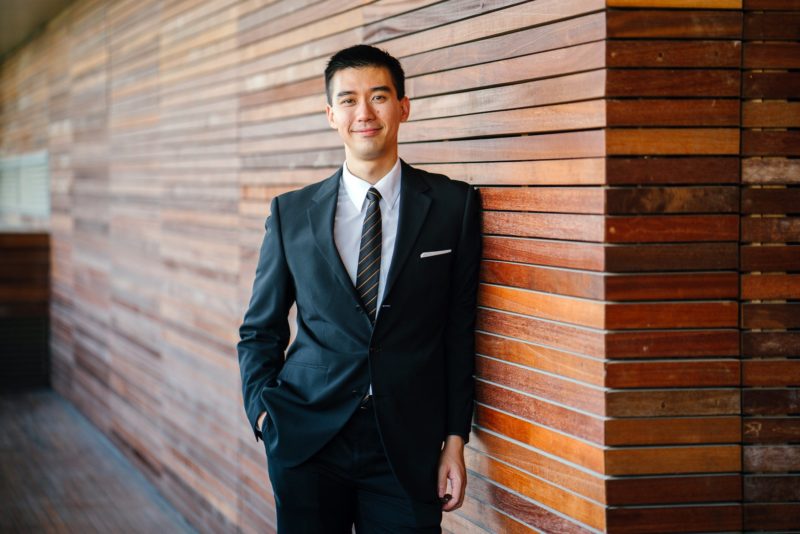
The Importance of Business Etiquette in South Korea
Whether you’re building Korean business relationships, or you’re planning to work in South Korea, you need to know the rules of Korean business etiquette. Business culture in Korea is much different from Western business culture. The last thing you want to do is accidentally offend a potential business partner. To keep that from happening, it’s crucial you understand these differences, and avoid the faux pas of Korean business behavior.
9 Rules to Follow for Basic Korean Business Etiquette
Confucianism is deep-rooted in Korean culture . This means that respect for age, authority, and education is very important in Korea. However, m odern Koreans don’t adhere to the principles of Confucian as strongly as the previous generations did. Still, these principles form the basis of many rules and practices of doing business in Korea. The steps below will highlight everything you need to make a lasting professional impression.

Psst! Did you know we have a language learning app?
- It teaches you useful words and phrases.
- Presented in a natural, everyday context.
- Spaced out over time, so you absorb your new language organically.
- It’s kind of like learning the words to your new favorite song!
You’re only one click away!
1. Respect Age and Status
Hierarchy affects all forms of social interactions in Korea. Having respect for status and age is crucial in Korean culture. Hierarchy means that everyone has a role to play in society therefore it is important to respect the role that everyone plays.
Koreans get very comfortable when they interact with a person they consider their equal. A number of factors such as marital status, role in an organization, and which university a person attended determine status in Korea.
2. Bow and Shake Hands When Appropriate
Koreans bow to their seniors as a sign of respect and greeting. The junior person will always initiate the bow. The bow is usually deep and the senior person will slightly bow to acknowledge the greeting and respect shown.

When meeting a group of Koreans, greet the individual with the highest status first then proceed to greet the oldest person. You’ll note the individual with the highest status because they always enter the room first.
Shaking hands when meeting someone for the first time has become common in Korea these days. However, it hasn’t completely overtaken bowing which in certain circumstances may happen during or before a handshake.
You can slightly bow during a handshake and break eye contact. You can have a firm handshake similar to the one offered by your counterparts, but it’s advisable if yours is gentler.
To show great respect during handshakes, a person with a lower status can shake using both hands or they can place their hand across their belly or support it at the forearm.
Korean women might bow instead of offering a handshake. That’s the norm because, in a formal business setting, it’s considered appropriate when women maintain a certain distance from men.
3. Have Your Business Card Ready
Have your business cards ready for exchange during initial meetings. Koreans love to understand status. A business card allows them to have a chance to assess the title, rank, and position of their potential business partner. Before sitting down for your meeting, politely give your business hand with both hands and take one in return.
Don’t put the card in your pocket. Instead, quickly review the titles, positions, and names on the card. When you sit down, remember to place the business card on the table and pick it up when the meeting ends.
A business card will show that you are organized. Remember to always have clean cards ready (and provide translated versions of your card to your business counterparts when necessary).
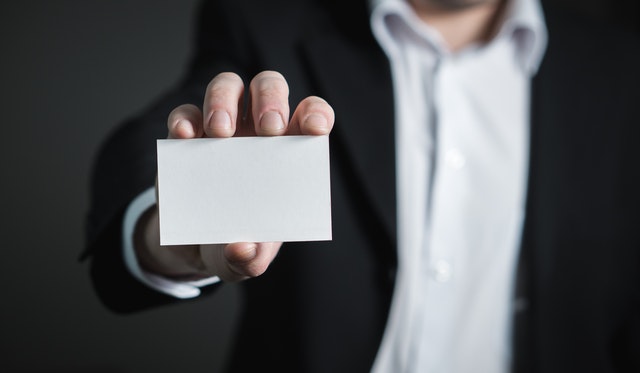
4. Give Appropriate Gifts
Gifts are always welcome in Korea because they symbolize the importance of a relationship. However, be considerate when gifting. If your gift is very expensive and the person receiving cannot afford to reciprocate, you can be viewed as inconsiderate.
Red and yellow are loyal colors. Wrap your gifts in these colors. You can also wrap your gifts in yellow or pink because these colors represent happiness. Never use white or black wrapping paper and never sign a card using green or red ink.
Always carry gifts with you when invited to a Korean home. Gift ideas for such occasions include flowers, chocolates, or fruit. Remember to hand over the gifts using two hands and understand that the gifts will be opened later and not immediately when received.
Keep in mind that South Korea holds anti-graft laws since 2016 . This means, that your gift to public officials can’t exceed a certain amount. Journalists, private school teachers, and their spouses can’t accept meals of more than 30,000 won (about 27 USD). And there are limits for gifts of 50,000 won (about 45 USD) – 100,000 won (about 90 USD) at private events such as weddings and funerals.
5. Use Family or Given Names Properly
During initial meetings, it’s best that you use a Korean family name when speaking to your business partner directly or when speaking about them when talking to another Korean. However, when you get to good terms with your counterparts, you can use their given name.
There are settings that are very formal and require great respect. These vary in nature, but it will be clear to you that it’s not a casual meeting. In such settings, use the formal title and the surname of your counterpart when addressing them. And if you’re not sure, always err on the side of caution and stick to the formal greetings.
6. Build Strong Professional Relationships
Relationships are crucial when conducting business in Korea. You can develop these relationships during informal social gatherings. Oftentimes, such informal social gatherings would involve alcohol. Drinking is a huge part of Korea’s business culture and is often considered the easiest way of relieving work stress and forming closer bonds with colleagues or business partners.

7. Dress in Professional Business Attire
Appearance is vital in Korea. Koreans dress more formally, have very conservative business attire, and don’t focus much on individual expression. Men should dress in white shirts with ties and dark-colored suits. Jewelry should be kept at a minimum, (such as a watch and a wedding ring). Women are advised to dress conservatively in colors and patterns that aren’t too vibrant or distracting.
8. Prepare Yourself for Business Dinner Invitations
Dinner is the biggest meal of the day in Korea and usually happens between 7 pm and 9 pm. Business dinners in Korea are strictly for the people doing business, so you should not extend the invitation to your spouse or partner. The host usually orders food. And be prepared, all the food usually arrives at the same time to the table.
Wait for the host’s invitation before you start eating your meal. When passing food around the table, use your right hand. It’s important to note that Korean cuisine has both extremely spicy and mild dishes. So, if you don’t like the heat, be careful.
Koreans generally like being quiet during a meal to ensure that they fully concentrate on their food. Conversations are held after the meal over tea or coffee.
The host always pays for meals; however, a good argument may arise over who is to pay. Remember it is considered polite when a foreigner offers a dinner invitation to reciprocate the kindness of the hosts.
Adopting these tips during your next business dinner will show your potential partner or current boss that you respect the Korean culture. This will help you build stronger relationships that are crucial for lasting success in your business.
9. Speak Korean
If you truly want to impress your Korean business partners, you should learn Korean. Even a few words can already make a positive impression. Learning a foreign language shows loyalty and appreciation. Most importantly, it can go a long way to benefiting you both as a person and as an employee. And if you want to learn Korean fast, you should use OptiLingo.
OptiLingo is a convenient language learning app that gets you results fast . By showing you high-frequency phrases, you can learn exactly how the locals speak. And with built-in pronunciation guides, you can start building your speaking skills from the first lesson. Each lesson will give you the confidence you need to speak fluently and impress your Korean business partners.
Vital Tips to Doing Business in Seoul
Seoul is the vibrant and dynamic capital of South Korea. It has amazing internet connectivity, numerous innovation hubs, and it’s the home for many startups. However, you should also be aware that a few bigwigs stand taller than most businesses in the city. These businesses are known as chaebols.
How Influential Are Seoul’s Chaebols?
Chaebols are companies that played a critical role in liberating Korea from poverty after the Korean war . However, in the years that followed, they installed a hierarchical system that forms a major part of the Korean business etiquette.
The key characteristic of Chaebols is that their businesses are family-owned and operated. These corporate giants control a huge part of the Korean economy and greatly influence the cultural and political aspects of Korea. Due to this influence, key positions in the corporate world are not earned but rather given out in a type of “structured” nepotism.

The leading chaebols are the SK Group, Samsung, Hyundai, and LG. The media in South Korea and some international agencies refer to them as the “Big Four.” And you can feel the impact of these companies throughout South Korea.
While these aren’t the only chaebols that influence the economy of South Korea, you need to understand the major players when doing business in Seoul. Businesses thrive on personally built relationships with these leading companies. And s ustaining these relationships, proving that you are a respectable business partner with a good character that reflects the values of Korea, is the key to success in business.
Related posts

How to Study Korean Without Romanization

Tips to Become Flawlessly Conversational in Korean
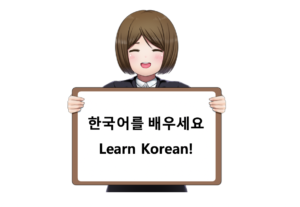
Best Webtoons to Help You Learn Korean
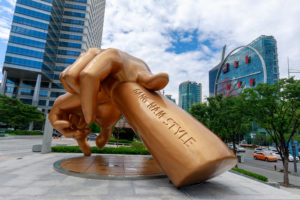
Learn Korean with K-Pop and Sing Your Way to Fluency!
Many people believe they aren’t capable of learning a language. we believe that if you already know one language, there’s no reason you can’t learn another..

The Ultimate Guide to Korean Business Etiquette and Culture (2024)

Navigate Korean business etiquette with confidence! This ultimate guide decodes cultural subtleties, dining norms, and communication practices essential for successful partnerships in South Korea.
%206.png)
Garrett Owen
Ryan is a highly skilled leader with extensive experience in multi-billion-dollar businesses on a global platform. With over ten years in the international arena.
South Korea presents an exciting opportunity, especially for food and beverage companies. The country offers a liberal marketplace, a thriving economy, and a culture rich in tradition and innovation. But to ensure a successful venture, it's crucial to understand Korean business etiquette. This guide aims to equip you with essential knowledge about the unique cultural and business practices in South Korea, to help you navigate this vibrant market with confidence.
To prepare this guide, we asked our network of experts at GourmetPro who have been successfully navigating the South Korea business culture for decades to share their insights. We distilled all their wisdom into this 12-point guide about South Korean business etiquette and culture.
1. Understanding the Role of Chaebols
In the heart of South Korea's economic landscape are the chaebols, large family-owned conglomerates that exert significant cultural, political, and economic influence. Born out of the Korean War's aftermath, they were instrumental in rebuilding the South Korean economy, transforming Seoul into a modern megapolis.
Chaebols such as LG, Samsung, Hyundai, and SK Group (the "Big Four") dominate the business scene, owning a significant portion of the Korean economy. As a foreign executive, recognizing the role and influence of these chaebols is vital when navigating the South Korean business landscape.
2. The Importance of Kibun and Face
At the core of Korean business etiquette is the concept of Kibun, which emphasizes maintaining dignity and harmony in personal and business relationships. Kibun is often misunderstood from a Western perspective, but understanding this principle is critical for success in South Korea.
In adherence to Kibun, Koreans avoid direct confrontations and negative responses. As such, they may agree to consider proposals even when they're unlikely to proceed. Recognizing these communication subtleties can save both parties from potential misunderstandings and frustrations.
3. Business Etiquette 101: Demonstrating Korean Values
In Seoul, business relationships are deeply personal. Demonstrating Korean values such as respect for authority, hard work, humility, and punctuality can significantly contribute to your business success. Additionally, hierarchies are crucial, with decisions often made at the executive level. Therefore, patience and understanding of these dynamics are key to establishing fruitful business relationships.
4. Rituals of Business Cards
Business cards carry significant importance in Korean business etiquette. When exchanged, they should be offered and received with both hands, and the recipient should take a moment to appreciate the card before placing it face-up on the table. Remember to carry plenty of business cards, preferably translated into Korean on one side.
5. The Art of Korean Greetings
In South Korea, greeting customs involve slightly bowing while keeping your hands at your side or folded in front. Bowing is common when saying hello, goodbye, or apologizing for minor mistakes. When it comes to handshakes, wait for the senior person to initiate, and remember, a strong handshake is considered coarse and rude.
6. Navigating Meetings: Dress and Conduct
When preparing for business meetings, adhere to conservative business attire and muted colors. Introductions by third parties are more effective than cold introductions, and patience is a virtue, as business decisions usually take time.
Ensure you get titles correct and treat people with superior titles with due respect. Avoid overt competitiveness and show humility and integrity at all times. Remember, in South Korea, your first meeting is likely to be about establishing relationships rather than focusing on business.
7. The Role of Dining in Korean Business Culture
Socializing is central to business in South Korea, and meals are a crucial part of this. Here are some of the vital rules to follow for both eating and drinking.
- Mealtime is important: Business meetings often include a meal, particularly dinner. Be prepared for conversations to continue over food.
- Respect your elders: Allow the eldest or highest-ranking person to begin eating first.
- Use both hands: When receiving dishes, use both hands as a sign of respect.
- Don't refuse: Try at least a little of everything that is offered. It's a sign of respect and appreciation for the host's efforts.
- Chopstick etiquette: Never stick your chopsticks upright in your rice bowl. It's considered bad luck as it resembles incense sticks at a funeral.

- Beware of Soju: South Korea's national drink, Soju, is a popular choice at business dinners. Be mindful of its potency!
- Accept gracefully: When a superior offers you a drink, accept it with both hands to show respect.
- Pour for others: Always refill the glasses of others when they are empty, but never refill your own glass. Wait for someone else to do it.
- Turn away when drinking: If you're drinking with someone older or of higher status, it's polite to turn your head to the side when taking a sip.
- Know when to stop: If you've reached your limit and want to stop drinking, simply leave your glass full. It's a polite signal that you won't be drinking more. But remember, it's also perfectly acceptable to communicate your limits directly.
Are you looking for spirits opportunities in South Korea?
The market for spirits in South Korea has blossomed since the Covid-19 pandemic. Read our guide to the latest spirits opportunities here .
8. Nunchi: Korean Emotional Intelligence
Think of 'Nunchi' as Korea's answer to J apan's ' Kuuki wo Yomu ,' both essentially mean 'reading the air.' It's all about tuning into others' feelings and adjusting your actions accordingly. South Korea is a high-context culture, where a lot is said through unsaid signals and the context of conversation.
Getting the hang of Nunchi can help you fully understand business interactions. But remember, you're an out-of-towner. So, while you're getting a feel for the subtle dance of Korean communication, be sure to keep your own messaging clear. Make sure your Korean colleagues fully understand your intentions, desires, and requirements. Striking this balance is your ticket to smooth communication in the South Korean business world.
9. Building Trust through the Concept of Jeong
In Korea, business relationships often evolve into personal relationships. This process is facilitated by Jeong, a deep emotional bond that develops over time through shared experiences. Creating Jeong with your Korean counterparts can lead to trust and long-term business relationships.
This is an essential aspect to understand when entering the South Korea market. To get a better understanding of potential partners to start building a relationship with, check out our guide to distribution in South Korea .
10. Gift-Giving Tradition
Gift-giving is a common practice in Korean business culture, often seen as a sign of respect and goodwill. However, it's crucial to be aware of the rules. Gifts should not be too expensive (to avoid the impression of bribery), and they should be wrapped and given and received with both hands. As in many Asian cultures, numbers play a significant role, and gifts should not be given in sets of four, which is considered unlucky.
11. The Significance of Public Holidays
Understanding Korean public holidays can also be beneficial, as these can impact business operations. Notable holidays include Lunar New Year (Seollal) and Korean Thanksgiving (Chuseok), during which businesses often close for several days.
12. Understanding the Korean Work Ethic
Koreans are known for their strong work ethic, often working long hours and late into the night. In fact, South Korea has some of the longest working hours among OECD countries. Recognizing this work culture can help set realistic expectations for your business interactions.
Now Give Yourself An Unfair Advantage in the Korean Market With GourmetPro
The insights shared here will definitely give you a head start in mastering Korean business etiquette. However, remember, these are just the first few steps into the vast realm of South Korean business culture. If you're envisioning launching your food and beverage venture in South Korea, then our team of Pro’s—fluent in Korean language, culture, business norms, and regulations—can be your guiding light in this seemingly complex market.
GourmetPro’s multilingual experts bring to the table an average of 10+ years of experience working in South Korea, specializing in areas such as:
- Market Entry
- Market Research
- Market/Brand Localization
- Business Development
- Technical Specialists
- E-commerce, and more
Let's pave your path to success in the South Korean market together. Reach out for an introductory call today!
Q1 - What is the table etiquette in South Korea?
In South Korea, dining etiquette is significant, especially in business settings. The eldest or highest-ranking individual typically starts the meal. Wait for them to lift their utensils first. Don't pour your own drink—pour for others, using both hands. It's also essential to eat at the same pace as the group. Navigating these customs can be challenging, but our GourmetPro Pros can guide you. Reach out today!
Q2 - What is the business card etiquette in South Korea?
When exchanging business cards in South Korea, present and receive with both hands, ensuring the card is facing the recipient. Take a moment to read the card before placing it on the table or in a card case. Never put it in your pocket or write on it. It symbolizes the person's identity.
Q3 - Is it impolite to tip in South Korea?
In South Korea, tipping is generally not customary, and sometimes it may even be considered rude. Service charges are typically included in the bill at restaurants.
You have growth objectives
We have solutions to reach them
Explore other gourmetpro trending publications.

The 29 Largest Grocery Chains in the US in 2024

The Top 17 Supermarkets in Australia in 2024

The 12 Biggest Supermarkets in Vietnam in 2024

koreadeepdive.com
Korean Business Etiquettes: A Detailed Guide for Foreign Professionals
Embarking on the Journey: The Importance of Korean Business Etiquettes
South Korea’s business environment is underpinned by a set of distinct, culturally-rooted etiquettes. Foreign professionals seeking to succeed in this environment must familiarize themselves with these conventions. Understanding Korean business etiquettes not only paves the way for effective communication but also shows respect for the country’s traditions and customs, making a positive impression on your Korean colleagues and superiors.
Exchange of Business Cards: More Than Just Sharing Contact Information
Business cards, or ‘myeongham’, hold a special place in Korean business culture. They are not merely tools for sharing contact details; they represent one’s professional identity. Here’s what to remember when exchanging business cards:
- Present and receive cards with both hands.
- Take a moment to read the card before putting it away.
- Avoid writing on someone’s card in their presence.
- Store the cards carefully as mishandling can be seen as disrespectful.
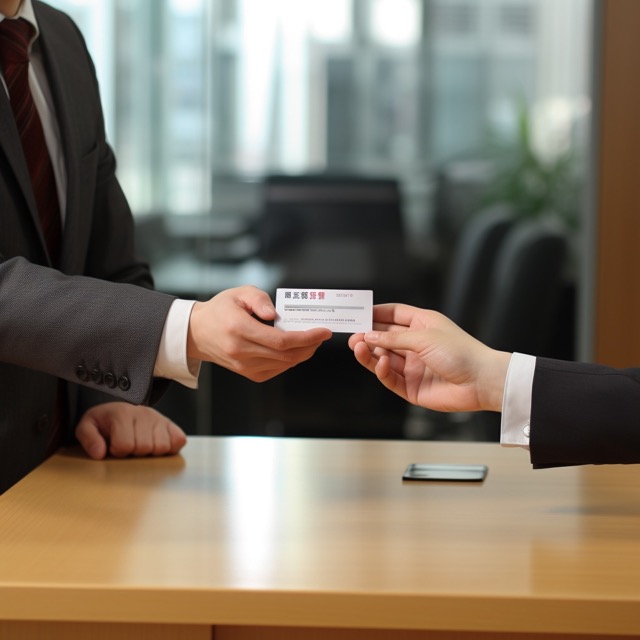
Business Meetings: Hierarchy, Punctuality, and Respect
In Korean business meetings, hierarchy plays a significant role. Always greet the most senior person first. Additionally, punctuality is highly valued. Arriving late for a meeting is considered disrespectful. Here are some additional points to consider:
- Wait for the senior person to initiate the meeting.
- Avoid direct disagreement; instead, express your views diplomatically.
- Confirm meeting details a day in advance to avoid any miscommunications.
Understanding the Art of Bowing: A Gesture of Respect
Bowing is a traditional Korean etiquette that extends to the business world. The depth of the bow often indicates the level of respect. A small nod is generally sufficient among colleagues, while a deeper bow may be appropriate when greeting a superior.
Navigating Business Dinners: A Platform for Strengthening Relationships
Business dinners, or ‘hoesik’, are an integral part of Korean work culture, providing an opportunity for team bonding. Here’s what you should keep in mind:
- Wait for the most senior person to start eating or drinking.
- Refusing a drink from a superior can be seen as impolite. If you do not wish to drink, politely express your reasons.
- Participate in conversations and engage with everyone at the table.
Dressing for Success: Formality and Modesty
Koreans take their professional attire seriously. Men typically wear dark suits with ties, and women wear modest dresses or business suits. While ‘Casual Fridays’ have become more prevalent, it’s safer to lean towards formality unless otherwise specified.
In Conclusion: Small Steps, Big Impact
While the intricacies of Korean business etiquettes may seem overwhelming at first, mastering these norms can significantly impact your professional journey in Korea. It’s about understanding the culture, showing respect, and being willing to adapt. So, embrace these etiquettes and pave your way to success in the Korean business world!
Understanding Korean Work Culture: Tips for Foreign Professionals
Related post
Leave a reply cancel reply.
Your email address will not be published. Required fields are marked *
Save my name, email, and website in this browser for the next time I comment.

- +44 0330 027 0207
- +1 (818) 532-6908
- [email protected]
- e-Learning Courses Online

- You are here:
4 Aspects of Korean Business Etiquette You Really Need to Know
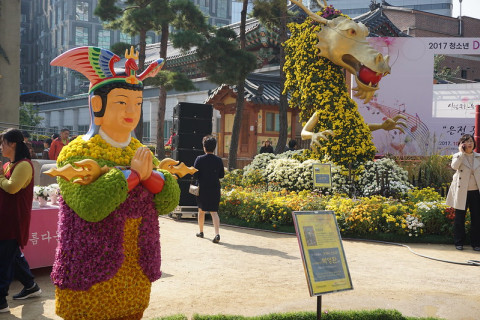
When working abroad, it’s crucial to make a good impression.
Presenting yourself well and demonstrating good manners make all the difference.
In some countries, the business culture may be relaxed and quite easy to navigate for foreigners; however, there are plenty where this is not the case.
South Korea is one such country.
The culture is one of many factors in making it more of a challenge.
Korean culture is very formal and ritualized, meaning etiquette is very important.
Here, we’re going to look at 4 aspects of Korean etiquette that foreigners can sometimes get very wrong.
Don't miss out! At the end of the page is a link to a free guide to Korean culture and etiquette!
Koreans take appearances seriously. What you wear is very important.
Historically Koreans wore clothing that identified them as being from a particular class or strata of society.
We can still see a sense of this today.
In the business world, suits, shirts and ties are a must. Women also dress in business attire.
You can not be casual with your dress in South Korea – it will be taken badly.
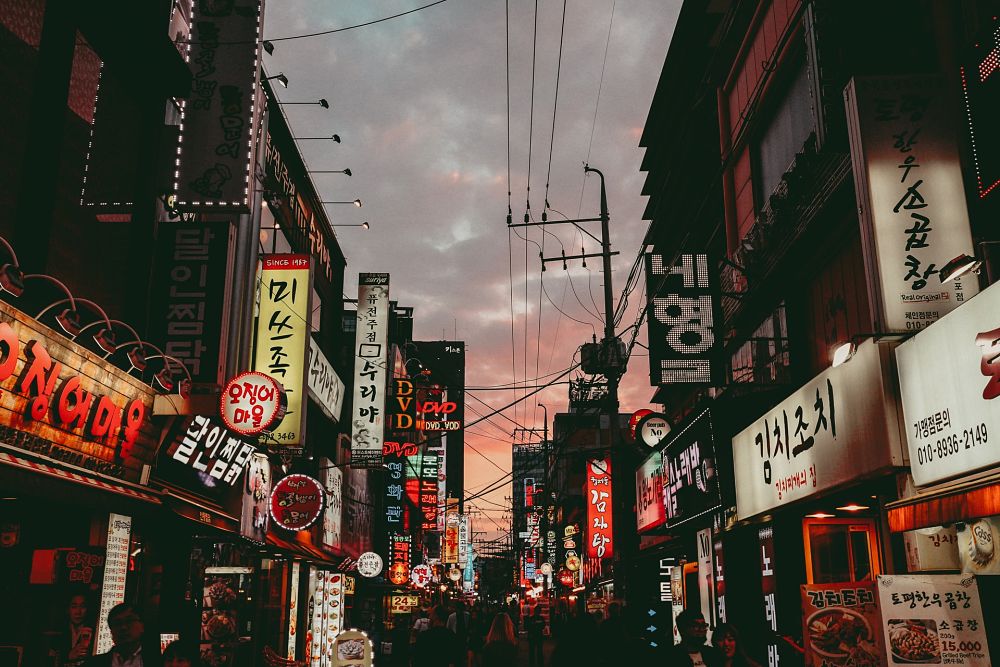
According to the Business Culture Complexity Index™ , South Korea has the 30th most difficult country to do business in for foreigners!
Photo by Sava Bobov on Unsplash
2. Business cards
Exchanging business cards is still a big deal in South Korea.
Turning up to meetings or engagements without your cards looks sloppy, so always make sure you have a good supply physically on you.
It’s good etiquette to have your cards in Korean as well as English.
Make sure when you present and receive cards not to use your left hand. Using both hands is common; some people may just use the right hand.
Never write on someone’s card.
3. First names
Koreans tend not to use first names with one another.
Although you may work with some Koreans who are comfortable with it, you’ll find that when in the company of others, it’s not the done thing. Refer to them formally.
Never jump to using someone’s first name; wait until you’re invited to do so, or just keep addressing them formally.
This may be with their official title, or simply using Mr. and Mrs.
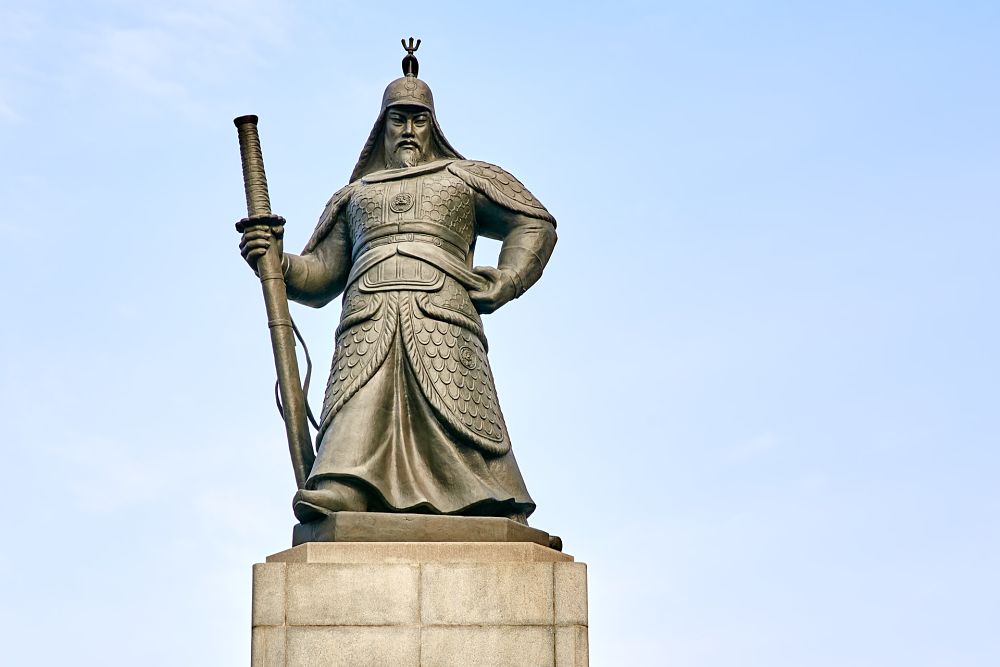
Korean business culture is traditional & hierarchical.
Learn more about the Korean Management Style here
Photo by Mathew Schwartz on Unsplash
4. Standing Up
Showing respect is important in Korean culture.
As a result, when someone more senior or important walks into a room, Koreans will stand up.
This may be when a boss enters a room or even if guests enter a room.
They will usually then wait for the person to be seated before themselves doing so.
If you notice a Korean not standing, this may be a sign that they don’t want to see the person in front of them!
Learning Summary
So, in answer to the question "What etiquette should I know about before doing business with Koreans"? you know understand that...
- It's important to dress well
- It's vital to pay attention to business cards
- It's crucial not to jump to first names
- It's essential to stand up when seniors enter a room
Expert Training on Korean Business Culture
When doing business in another country or with another culture, it’s always a good idea to do your homework!
For business professionals looking for more tailored support, we offer live training webinars with our South Korea experts who can give practical advice.
CLICK HERE FOR OUR FREE GUIDE TO SOUTH KOREAN CULTURE & ETIQUETTE
Blog image by Pedro Cambra (CC BY 2.0)
By accepting you will be accessing a service provided by a third-party external to https://www.commisceo-global.com/
34 New House, 67-68 Hatton Garden, London EC1N 8JY, UK. 1950 W. Corporate Way PMB 25615, Anaheim, CA 92801, USA. +44 0330 027 0207 or +1 (818) 532-6908
34 New House, 67-68 Hatton Garden, London EC1N 8JY, UK. 1950 W. Corporate Way PMB 25615, Anaheim, CA 92801, USA. +44 0330 027 0207 +1 (818) 532-6908
Search for something

Korean Culture – Guide to History, Customs, People, and Modern Day
Last modified: Jul 05, 2024 | 19 min read | By Joseph Gerocs
Are you curious about Korean culture ? Many people are since the culture in South Korea is becoming more popular all across the globe.
Perhaps you’ve heard about K-Pop , K-Dramas , Korean food , or Korean movies but don’t know much about them. Or maybe you’ve just heard a lot about South Korea in general, and you’re curious what the country is all about .
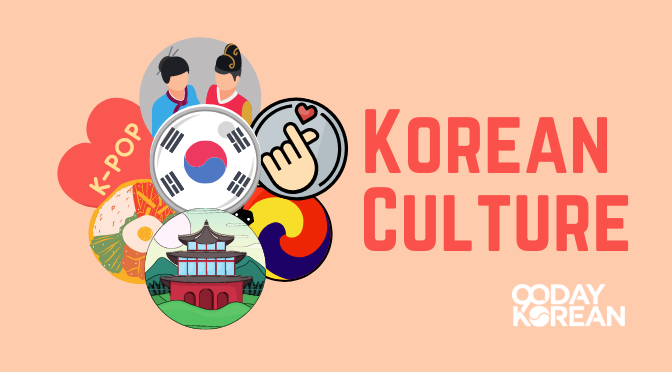
Rest assured; you’ve come to the right place! This page is chock full of everything you’ve ever wanted to know about South Korean culture .
Read on to find out more!
- 1 History of Korean Culture
- 2 Basic Facts about Korea
- 3 Korean Beliefs
- 4.1 Korean Ancestral Rites
- 4.2 Korean Burial Sites
- 5.1 Korean dance
- 5.2 Korean painting
- 5.3 Korean Pottery
- 5.4 Korean music
- 6.1 Korean cinema
- 6.2 Korean dramas
- 7.1 Korean traditional homes
- 7.2 Modern Korean House
- 7.3 Korean clothing
- 8 Korean cuisine
- 9 Korean Concept of “Face”
- 10 What is South Korean culture like?
- 11 What is the History of Korean culture?
- 12 What does the dragon mean in Korean culture?
- 13 Korean Holidays
- 14 Understanding Korean Culture
History of Korean Culture
The Korean culture is one of the oldest continuous cultures in the whole wide world. Today, starker cultural differences exist in today’s Korea, which has been split into North and South Korea. However, originally this cultural and historical heritage was shared quite identically across the entire Korean peninsula and even southern Manchuria.
Korean culture comprises all of its history, customs, traditions, and beliefs . It has been shaped by each of its different dynasties, wars, changes in religious beliefs, the modernization of the world as a whole, and many other customs and traditions that have been passed on between generations, experiencing slight changes with each generational pass. The lasting tensions between North and South Korea, which were split into their separate countries in 1945, continue to shape up both countries today.
On a perhaps more visible surface, Korean culture also consists of its food, holidays, national sports, and societal norms, as well as its popular culture in the form of music, movies, dramas, and fashion. And those are just some of the small pieces of what the culture is as a whole.
Basic Facts about Korea
The Korean peninsula, consisting of North and South Korea, is one of the most homogeneous regions in the world. Meaning that almost everyone residing in any part of the region is ethnically Korean. In South Korea, the population of Korean people is estimated to be a little over 51 million, and a little over 25 million in North Korea.
Additionally, there are around 7.4 million ethnic Koreans living all around the world. The native language is Korean, which you can read all about here . Lastly, their government type is a republic, with a president as the head of state.
Korean Beliefs
The spiritual ground and beliefs of Koreans are built mainly around the religions of Confucianism, Buddhism, and Christianity. Of these, especially Confucianism has a long record of influence in Korea, and its political and social philosophies can still clearly be seen in today’s Korea.
However, Buddhism and Christianity are also highly visible in the society where Buddhist South Koreans account for 46% of the population, and a lot of the areas in South Korea that are listed as world heritage sites are Buddhist temples.
For example, the concept of hierarchy in Korea comes from Confucianism. The hierarchy is built based on a person’s age , job status, education level, and general social rank. Thanks to Confucianism, a lot of emphases is put upon respecting one’s elders and ancestors .
And although especially the younger generations of South Koreans are becoming more and more individualistic, Korea is still a largely collective society, with the family, workplace, business, and others’ perception of you holding a lot of importance. Therefore, it is not rare to still see the type of family dynamics where the eldest son of the family holds additional responsibilities over the family. He is also expected to take care of the parents when they reach retirement age.
Korean traditions and customs
There are two major holidays in South Korea every year: Lunar New Year’s Day (설날, seollal) in January-February and Korean Thanksgiving (추석) in September-October. Both holidays are celebrated together with family, with respecting ancestors, certain holiday foods and family games playing a big part of the day. These are all part of Korean traditions and customs .
One of the most important parts of 설날 (seollal), both traditionally and today, is to perform a ritual called 세배 (sebae). In it, the whole family, dressed in 한복 | hanbok | Korean traditional dress), performs a traditional deep bow while wishing for the year to bring in a lot of luck. For food, it is normal to eat rice cake soup, savory pancakes, and stir-fried glass noodles with vegetables.
On 추석, on the other hand, it is 차례 (charye), an ancestral memorial rite, that is the most important part of the holiday. It involves a whole lot of preparation in order to create a table of offerings, and on the table will also be two candles at the edges, an incense holder in the middle, and the memorial tablet, symbolizing the spiritual presence of the ancestors, at the very center. For food, stuffed rice cakes (called 송편, songpyeon) are made as to the most traditional one, with a whole lot of others being enjoyed as well.
Korean Ancestral Rites
Koreans hold their ancestral rites for their ancestors through a memorial ceremony called 제사 (jesa) on different occasions, such as on holidays or on the death anniversary.
There are different kinds of Korean ancestral rites that are observed. They are 기제사 (gijesa), 차례 (charye), 성묘 (seongmyo), and 묘사 (myosa).
기제사 (gijesa) is held during the death anniversary of one’s ancestor. 차례 (charye) is done during the traditional holidays in Korea in each of the family’s homes to pay respect to their loved ones. 성묘 (seongmyo) is when Koreans visit the tombs of their ancestors to show love and respect to them. And finally, 묘사 (myosa) is done at the tomb site in the lunar month of October.
Korean Burial Sites
There are 2 common types of Korean burial sites where they enshrine and commemorate the remains of the deceased. One is called 묘지(myoji), which means burial ground. Cemeteries are called 공동 묘지(gongdong myoji).
The other one is called 봉안당 (bongandang), a place where the remains are enshrined after cremating the deceased. There is also 봉안담 (bongandam), which is an outdoor wall-style version of 봉안당 (bongandang).
Korean traditional arts
There are a variety of traditional arts in South Korea that can still be seen and enjoyed today. Thanks to the Korean people who are mastering these arts for many of us to enjoy. You can see them being performed in the country at special events and celebrated in exhibits around the world.
Korean dance
Based on Korean history , dances in Korea were formed as a part of shamanistic rituals an impressive five thousand years ago. Over time and the different dynasties, varieties of folk dances have evolved from these ritualistic dances. There were more than 12 types of Korean dances that were popular to perform in the court in front of royals, for example.
Some of the most popular and common traditional dances, well-known even today, are as follows:
- 탈춤 (talchum) = a dance performed while wearing a mask
- 가인전목단 (gainjeonmokdan) = a calm dance where a vase of flowers is placed at the center of the stage, and the dancers will dance around the vase, picking out flowers from the vase
- 농악 (nongak) = an energetic dance also including drums
- 부채춤 (buchaechum) = a fan dance
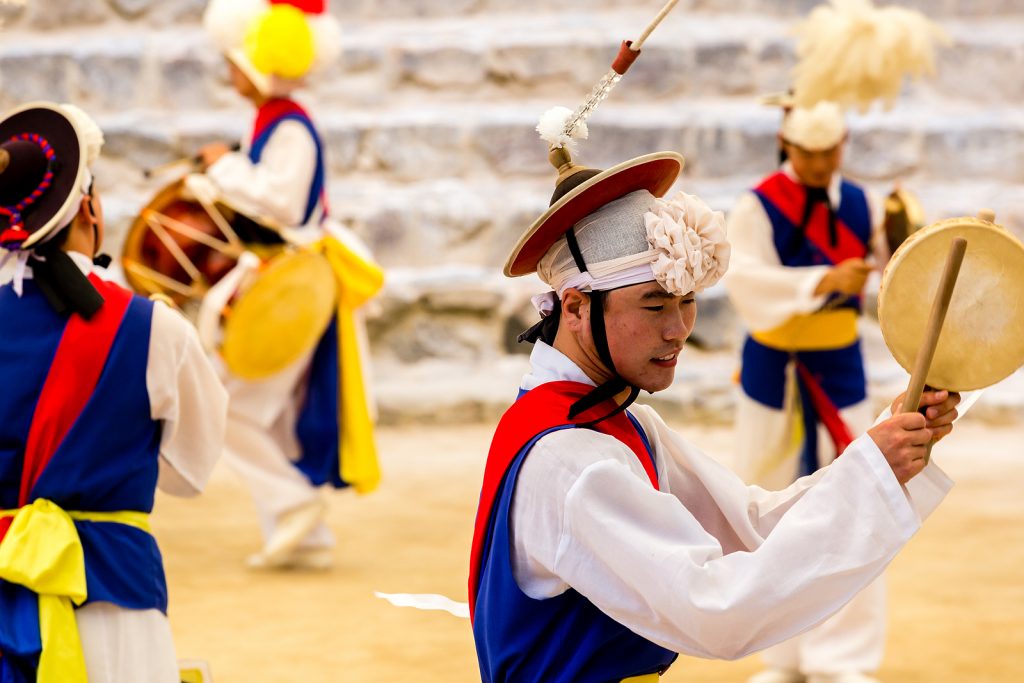
Korean painting
Painting is a type of Korean art that has been a part of Korean culture since prehistoric times. In its earliest form, Korean painting was a form of rock art, where images were created by carving out parts of a rock surface. Once Buddhism arrived in Korea, new painting techniques were introduced, quickly becoming the common and popular way to paint. This includes, for example, calligraphy .
Korean Pottery
The history of pottery and ceramics in Korea goes back thousands of years. The dominant ingredient used in Korean pottery and its style have changed over the dynasties (Goryeo dynasty to Joseon), ranging from coils and clay to pottery to porcelain. Korean ceramics have also had a strong influence on shaping Japanese ceramics.
Korean music
Besides K-pop songs , Korean music is made up of traditional Korean songs ranging from folk and court to religious. This aspect of culture comprises the music in the Korean peninsula (North and South). As a whole, this genre that is made up of traditional Korean songs is known as 국악 (gukak).
Korean Folk Music
The Korean folk song or music is typically referred to as 판소리 (pansori), which has even been designated as an intangible cultural property by UNESCO. Pansori is performed by one singer and one drummer. Some pansori songs also include dancers and/or narrators. Another type of folk music is 풍물 (pungmul), which involves drumming, singing, and dancing; it is traditionally called 농악, which has been mentioned above.
Korean Court Music
Besides folk music, Korean court music is another traditional Korean music. It was developed at the beginning of the Joseon Dynasty, getting some of its influences from Chinese court music. There are also similarities to Japanese and Vietnamese court music.
There are three types of court music. The first form is 아악 (aak), which was drawn directly from the Chinese, performed in state sacrificial rites, and still exists today as music performed in some Confucian ceremonies. The second form is 향악 (hyangak), which was created entirely by Koreans. 향악 was often accompanied by traditional country dances, with the dances being performed for an audience. The third one is 당악 (dangak), which mixes Chinese and Korean court music styles into one style. There are specific types of dances that go along with 당악.
Korean popular culture
Often referred to as “ hallyu ” or the Korean wave, the Korean popular culture is no longer only famous and popular in Korea but becoming widespread across the globe.
Korean wave mainly includes Korean pop music, dramas, and movies. In fact, although K-Pop, through acts like BTS , is a hot topic these days, it was originally Korean dramas that became famous for watching in other countries.
Korean cinema
When speaking of Korean cinema , it usually counts the time from 1945 onward. The movies take a lot of influence from Korea’s own past, featuring a lot of material from the Japanese occupation, the Korean War, the road towards democratization and globalization, and so on. Although there is still present some shyness to putting certain materials on film, simultaneously Korean filmmakers are bold in expressing their views of society through internationally well-received movies like The Handmaiden and Parasite .
Korean dramas
Korean dramas differ from a lot of Western TV content, as they are typically only made to last for one season, with one overarching plot lasting 12 to 16 or so episodes. Historical stories and sitcoms may last longer, even up to 200 episodes, but the majority of prime-time television is set up this way. The dramas range on a variety of topics, from history and action to school and work life.
However, many of the most popular dramas have had a romantic story as their main element. Love stories on screen in Korea often play out quite differently from what is common in the West, with bedroom scenes and even deep kisses still remaining relatively rare to see. In the past few years, Korean dramas have also become more interested in tackling today’s societal issues, such as classism, mental health, bullying, spy cameras, corruption, and so on.
K-Pop is short for Korean pop, Korea’s response to Western mainstream music. The music itself samples different genres, from rock and jazz to hip-hop and techno, influenced by worldwide trends.
However, despite the influences, K-Pop is also quite different from Western pop, with idol groups being its leading force. The K-pop groups are formed by entertainment agencies from hoards of young trainees, who have been signed to the agencies in hopes of debuting as an artist at a young age, often years before getting lucky. In each group, each member plays their own role: there’s a dancer, a rapper, the main singer, a pretty face, and so on.
And although the songs themselves are important, the entire concept of each “comeback” – the term used whenever a group or an artist releases new content – is carefully crafted. From hair styling to dance moves and music videos, there is often a specific theme behind each single or album release, which also influences the mood and tune of the songs.
Korean homes and clothing
As with other aspects of South Korean culture, traditional homes and clothing continue to be visible in today’s Korea, and you’ll be able to see them in your daily life in South Korea. For example, in neighborhoods like Seoul’s Gwanghwamun, it is possible to see modern Korea’s glassy high-rise buildings blend in seamlessly with historical Korea’s traditional palaces, all in one spot, complete with locals and tourists walking about wearing traditional attire.
Korean traditional homes
A traditional Korean home is called 한옥 (hanok). It was thought that they could not be built on any random spot, but the site to build the house on needs to be carefully selected. In detail, this means that the houses should be built against a hill so that they’d receive as much sunlight as possible, a way of thinking that is still shared in modern Korea as well.
These traditional houses typically comprise an inner wing and an outer wing. How these “wings” are used depends on the wealth of the family, and in general, the size of the house was also directly correlated with how rich the family was. However, even if it was the richest family in Korea, the right to the largest house was reserved for the king.
A basic design of the inner wing would include a living room and a kitchen, as well as a central hall. The richer families may have some more rooms attached to this layout. Meanwhile, the poorer families would use the outer wing for their cattle. The most common building materials were wood and clay, followed by tile, stone, and thatch. That is one large reason why so many of these houses are no longer preserved in today’s Korea.
For heating, 온돌 (ondol) was used. 온돌 means floor heating. It has been in use in Korea since prehistoric times, and it is still the main form of heating today, in modern apartments as well, typically heated up using gas.
Modern Korean House
The majority of Koreans live in a modern Korean house . And there are many types of modern Korean houses: apartments, villas, officetel or studios, service residences, and private houses.
A few common characteristics of these houses are having an area where sunshine can come in, open areas, lots of windows, and crystal doors.
Apartments are usually high-rise buildings that you’ll commonly see around the country, especially in Seoul.
Villas are low-rise buildings that typically don’t exceed 5 stories. Officetel, on the other hand, is also known as one-room. This house is inexpensive and is mostly located near subway stations.
Service residences are apartment buildings that have facilities and services similar to a hotel.
Private houses, also known as stand-alone houses, are the most expensive type of house among all the types of houses mentioned above. And you’ll not often see this type of house in urban areas.
Korean clothing
The traditional outfit in Korea is called 한복 (hanbok). It consists of a long-sleeved shirt and a long wide hemmed skirt. The specific styles and colors of each 한복 differ. Even today, it is normal for 한복s to be worn during the big holidays of 설날 and 추석. In addition to which they’re often also worn at weddings by the bride and groom’s parents, as well as the bride and groom at some point after the ceremony. Or even during the ceremony if it’s held in a traditional Korean style. It can also be worn on special events in the family, in the company, or on business events.
There were different types of 한복s in use. There was the kind used for every day, the kind for ceremonial events, and the special kind, which was usually restricted for the use of shamans, officials, and the like.
In general, clothing used to be an important mark of someone’s social rank, with people of different ranks dressing differently. Those of lower ranks typically wore plain clothes of plain colors, whereas upper classes and royals wore heavy and flashy outfits, complete with jewelry.
Korean cuisine
At the very center of Korean cuisine is rice. Korea has a long history of being nearly exclusively an agricultural country, with this having changed only recently, and you can still clearly see this in today’s cuisine. Fish and other seafood also play an integral part in shaping Korean cuisine.
Besides them, fermented dishes are largely important, kimchi being the most famous of them, rich in nutrients. The most common ingredients to use for cooking are 된장 (doenjang) which is a fermented bean paste, ginger, chili powder, fermented hot pepper paste, garlic, salt, sesame oil, and soy sauce.
In general, Koreans eat a lot of rice, vegetables , and meats. It’s typical for each meal to consist of multiple different side dishes, called 반찬 (banchan), in addition to the main course. Of them, kimchi is the staple side dish present at every meal.
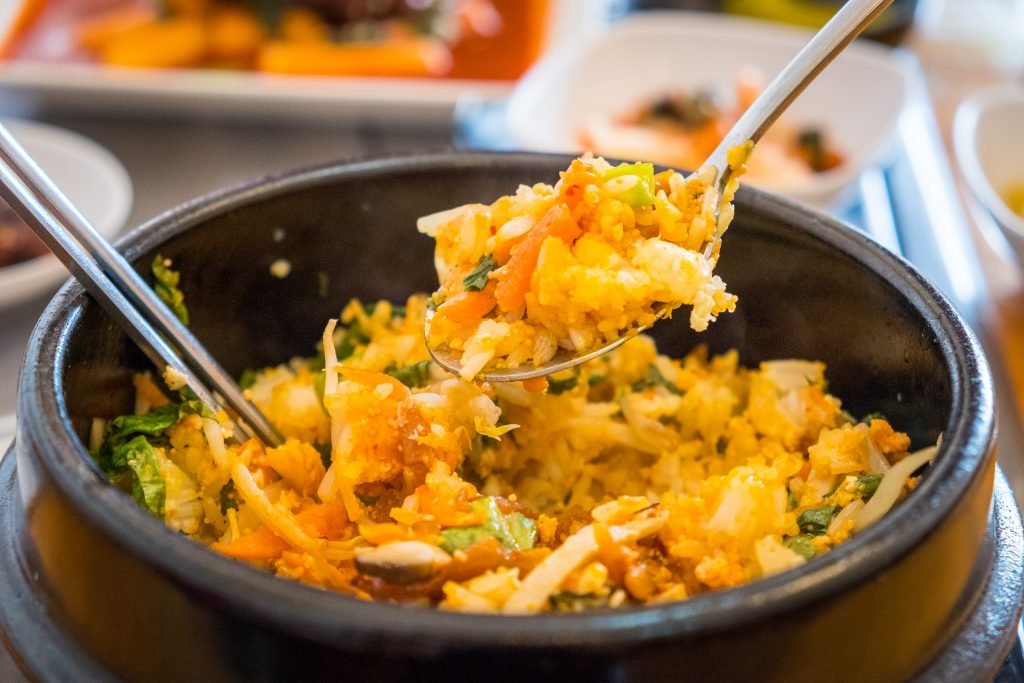
Pork is perhaps the meat eaten the most in Korea , with 삼겹살 (samgyeopsal), which is grilled pork belly, one of most Koreans’ favorite foods. Several different chicken dishes also exist, including chicken feet. Beef is seen as the meat with the highest value, which explains its comparatively higher price, although since the latter 20th century, it has become more common to eat on a regular day instead of solely on special occasions.
A lot of Korean food is served grilled, steamed, fermented, or pickled. There are also a large variety of soups and stews, as well as noodles. In addition, several specific foods, such as salty pancakes or tofu with kimchi, are commonly eaten while enjoying alcohol.
Korean Concept of “Face”
To fully understand the way of behaving and thinking of Koreans, you need to understand the concept of the face – 체면 (chaemyeon) in Korean . It is among the most integral and important things in influencing how Koreans behave in their daily life and interactions with others.
체면 (chaemyeon) in meaning translates as the appearance a person wants to – or seeks to – offer others of themselves. It is especially prevalent when it comes to one’s status in society. For example, if someone is going through hardships with a relationship, an employment situation, finances, or even something more simple as struggling to do well in school, they will want to disguise that and instead show a more poised version of themselves.
This concept is also important for interactions with interpersonal relationships. Largely because of Confucian influences, Koreans hold maintaining harmony in high regard. And therefore, all conflict with others is to be avoided, and it is even feared that it could lead to saving face. Thus, it is more sought after to keep harmony and hold in negative thoughts and emotions.
This is an age-old concept in Korea. However, due to the hardships that came from being under Japan’s rule and then the war that led to Korea being split into two, it has regained importance in Korean society.
What is South Korean culture like?
South Korea is a unique culture with influences from China , Japan , and the West. When you first come for a visit, you will notice some things that are familiar to your home country. For example, you will likely see chain restaurants and global stores that are popular back home. At the same time, you’ll notice customs, styles, and social norms that are uniquely South Korean.

What is the History of Korean culture?
Korea is one of the oldest cultures in the world. Koreans have passed down their traditions and stories for centuries. The country started to become split between North Korea and South Korea in 1945, and since then, the two Koreas have increased cultural differences.
Some of the South Korean traditional arts are ceramics, music, crafts, dance, and paintings. You can often see these displayed if you’re visiting the cultural and tourist areas of South Korea, such as 인사동 (Insadong) or 명동 (Myeongdong).
What does the dragon mean in Korean culture?
If you visit traditional buildings or look at Korean artwork , you will often see dragons. For Koreans, the dragon has a positive meaning. It symbolizes water, rain, clouds, and farming. Therefore, Korean dragons are often said to have lived in bodies of water such as oceans, rivers, and lakes. The word for dragon in Korean is 용 (yong).
Korean Holidays
South Korea shares many holidays with the rest of the world but also has some holidays unique to its culture. The most popular holidays are 추석 (Chuseok | Korean Thanksgiving) and 선랄 (Seollal | Korean Lunar New Year). During these two holidays, many Koreans return to their hometowns to visit their families.

During public holidays in Korea, most offices, banks, and government buildings are closed. However, places like museums, restaurants, cafes, amusement parks, and shopping malls remain open. The night before most public holidays, it is usually very busy in Korea with people going out to celebrate and meet friends.
There are some Korean holidays that are culturally celebrated but are not public holidays. Some examples of those are Pepero Day , Valentine’s Day , White Day , and Black Day . Koreans do not get a day off during these holidays.
| Korean Holiday | Date | Type of Holiday |
|---|---|---|
| | January 1 | Public Holiday |
| | 1st day of 1st lunar month | Public Holiday |
| | February 14 | Cultural Holiday |
| | March 1 | Public Holiday |
| | March 14 | Cultural Holiday |
| | April 14 | Cultural Holiday |
| | 8th day of 4th lunar month | Public Holiday |
| | May 5 | Public Holiday |
| | May 8 | Cultural Holiday |
| Memorial Day | June 6 | Public Holiday |
| Constitution Day | July 17 | Public Holiday |
| | August 15 | Public Holiday |
| | 15th day of 8th lunar month | Public Holiday |
| | October 3rd | Public Holiday |
| | October 9 | Public Holiday |
| | November 11 | Cultural Holiday |
| | December 25 | Public Holiday |
Understanding Korean Culture
Korean culture is truly full of history, tradition, and uniqueness. If you want to properly learn about Korea, it is important to educate yourself on its basic pillars, which you have just done by reading our article. Korea’s speedy rise from a war-ridden and undeveloped country to one of the global economy’s high hitters is one reason that allows for South Koreans, and for us, to enjoy such a blend of tradition and modernism in their culture today.
What aspect of the culture are you most excited to get to explore once you’re in Korea yourself one day: the food, the music, the history, or something else?
Related Posts
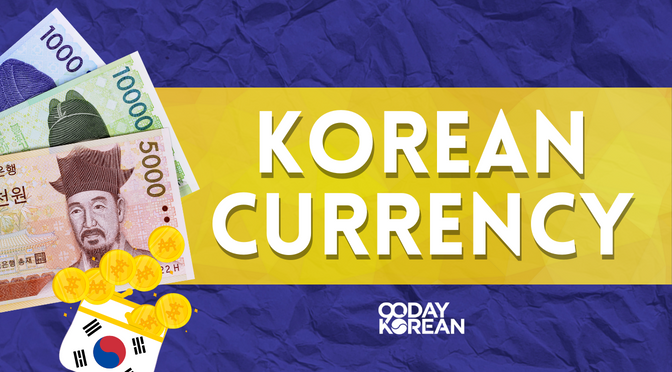
Korean Currency: All About Money, Bills, and Coins in the South
Last modified: Jul 12, 2024 | 9 min read | By 90 Day Korean
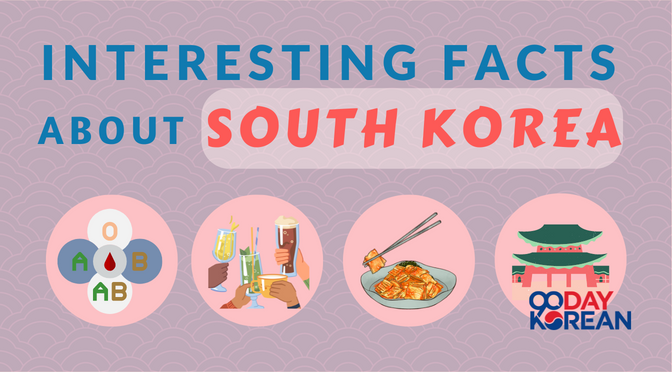
Facts About South Korea – 30 Interesting Things to Learn
Last modified: Jul 12, 2024 | 28 min read | By 90 Day Korean
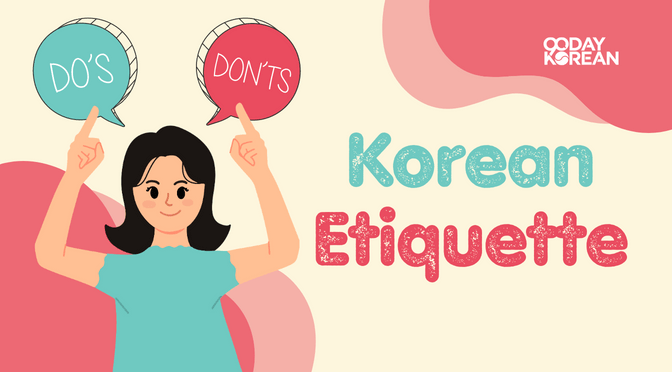
Korean Etiquette: 11 Customs You Need to Know
Last modified: Jul 12, 2024 | 11 min read | By 90 Day Korean
41 thoughts on “Korean Culture – Guide to History, Customs, People, and Modern Day”
I have been into K-pop for such a long time (probably about 7 years), now I am a senior in High School doing a research based essay on the history of Korean culture and this article was extremely helpful to me. It provided a lot of information about the history of Korea (both South and North Korea).
Awesome! Glad to hear that, Ella! ^^
Thank you for sharing information about Korea. It was amazingly informative and interesting!
It’s our pleasure, Tetyana! ^^ I appreciate your kind words! If you want to know more about the Korean language and culture, you can also check our blog and visit our YouTube channel for articles and videos with great Korean content.
ALWAYS GREAT INFORMATION…THANK YOU!
Awesome, thanks for your comment, Tim!^^ If you want more lesson on Korean, you can also check our check our blog and visit our YouTube channel for articles and videos with great Korean content.
Quite informative article. Thanks for sharing it!
Awesome, thanks for your comment! I’m glad that our article has been helpful to you. ^^ If you want more lesson on Korean, you can also check our check our blog and visit our YouTube channel for articles and videos with great Korean content.
Leave a Comment Cancel Reply
Your email address will not be published. Required fields are marked *
Choose your skill level and start getting fast results with your Korean:

- Schedule Now
- Client Login
- Reporter Login
- Join Remote Depo

Business Etiquette in South Korea – From Table Manners to Conversation
Doing business in seoul.
Doing business in Seoul is an interesting experience. Business is life in Seoul, literally structured under a dynastic business structure that runs one of the largest, most modern metropolitan areas in the world. While many of the traditional formalities of Asian culture prevail, the city itself is an amazingly high-tech and newly developed following the Korean War. It leads in internet connectivity and digital technology. It is a hotbed of new startups, innovation hubs, and yet controlled by business titans like Samsung, which are called chaebols. Despite a liberal marketplace and cultural phenomena like K-Pop, people identify heavily with work, prioritizing it above social and extra-curricular life. So there is not much of a line between business and personal life. South Korean values play deeply in their work. Most business is structured around personal, sustained relationships. Showing that you are of good character and reflecting Korean values is fundamental to business success and business etiquette.

What is a Chaebol?
Understanding the business climate is important to navigating the South Korean business landscape. One of the first things that may confuse Westerners is the distinct structure of South Korea’s economic, geographic, political, and business landscape. At that center of city of Seoul and all of South Korea are the chaebols. But, what is a chaebol and why is it important?
Following the Korean War, a number of family-owned businesses were charged with rebuilding the South Korean economy—and quite literally building up the megapolis of Seoul National Capital Area. The industrial and economic foundations that traditionally supported Korea had collapsed. Identified by the government as business leaders, government policies and programs helped support several family-owned companies in rebuilding the war-stricken country. As a result, these companies rose into global powers and grew into large conglomerates, called Chaebols. [Chaebol means chae (wealth) and bol (clan).]
While these companies were integral in pulling post-war Korea from poverty, they also installed a top-down, hierarchical system. Family ownership and subsidiary organizations define chaebols. More than corporate goliaths, these dynastic companies own a great portion of the Korean economy and exercise cultural and political influence. Much of their corporate structure is determined patriarchally. Thus, key positions are not only earned, but given out in a structured nepotism.
The four major chaebols are LG, Samsung, Hyundai, SK Group—dubbed the “Big Four” by the South Korean press and international agencies. You will see their influence around Seoul. While there are many chaebols influencing the South Korean economy, knowing the major players is helpful in doing business.

Traveling in Seoul, South Korea
Seoul is a clean, business-oriented megacity spanning 234 square miles. It boasts one of the largest metropolitan areas in the world and is the 5 th most populated. To put it into perspective, Seoul has twice the population density as New York. There are over 10 million people in the main city of Seoul, but over 25.5 million in the larger metropolitan area. That means over half of the country’s entire population is in Seoul.
Crowds are inescapable. There is a lot of crowding, shoving, and pushing through people. Personal space, much like in the rest of Asia, is not a cultural concept. Do not take crowding personally.
The subway system is clean, safe, and effective. However, signs are in Korean and as a huge, bustling city it can be easy to get lost. Have a map marked ahead of time. Always keep a business card of the hotel where you are staying. Cabs are commonplace, but don’t speak English.
Getting to and from the airport to Seoul is a simple, but long car ride. Book shuttles ahead of time whenever possible.
Understanding the Asian Concept of Face, or Kibun
A core to value in Asian society is Kibun, which is about how you show yourself to the world. The concept of kibun is about preserving the dignity of yourself and others. Harmonious personal and business relationships are important to kibun.
Kibun is a key value in most Asian societies that can be misevaluated as prideful or even disingenuous from a Western point of view. This is a critical error in doing business in South Korea. It can lead to business miscommunication, leaving both parties frustrated.
In keeping face, Koreans will often avoid acrimony or confrontation. Korean etiquette means avoiding saying a direct “no” and will instead agree to try, help, or consider a matter that will likely not go forward. This is an attempt not to embarrass—or lose face—for either the person requesting and the person responding to a proposition.
Because kibun is so important, rank is very important in South Korean society. Your first meetings will likely be about trying to understand who you are. People will be interested in discovering your marital, business, educational, and age. These social criterions determine who you can meet within business and towards what end.
Business Etiquette in South Korea
Demonstrate korean values.
Business relationships are personal relationships in Seoul. Who you are is part of the ultimate bottom line. South Korean traits to demonstrate in business—and everywhere in Asia—are:
- Respect for authority and elders
- Hard working and eager to learn
- Virtuousness and modesty
- Punctuality (it’s seen as a sign of respect)
Still there are a lot of benefits of doing business in Seoul, including lasting contacts. (Oh, and incredible food!)
The Definitive International Deposition Guide
The benefits of doing business in south korea.
- Increasingly liberal marketplace
- Widespread English language in business
- Thriving economy
- Safe for travelers
- Personal relationships that are both formal and friendly
Hierarchical Business Etiquette
Business is hierarchical, which can mean a lot of movement up and down the chain of command. Pad your time to allow for the extra business layers. Things often come down to executive decision, even when the meetings that lead to that are very positive.
Be prepared to be social and polite. You never know who will be at a meeting. Often, the group will be larger than you were anticipating. Decisions, or even getting the right meeting, may take longer than anticipated. And, you’ll never get a business decision in the first meeting.
Titles carry special importance in South Korea, rather than being a reflection of what someone does. These are largely honorific. Be sure to note and use the proper title and surname of each person involved. As we will explain, it is customary to exchange business cards, study them, and leave them face up on the table. That can be a helpful way to remember the position of each person at a meeting.
Business Card Rituals in Seoul
Business cards are very important in South Korea and there is an important ritual to them.
An exchange will happen at the beginning of meetings. Business cards are given and received with both hands, placing the writing so that it is face-up and readable to the recipient. Hold the card between your thumb and top knuckle or index finger in both upper corners. When taking a business card, take a moment to appreciate the card, studying the name and title. Compliments are well-received but overdoing them will seem insincere.
- Do not write on business cards in front of the giver.
- Do not fold or pocket business cards.
- Keep plenty of cards (preferably translated into Korean on one side).
- Treat cards with utter respect.
- Keep business cards face-up on the table or putting them delicately into a business card holder.
A business card holder is one of your most important business accessories while doing business in South Korea.

Greetings and Bowing
Slightly bowing is a normal salutation. Keep your hands straight at your side or folded in front of your stomach with your legs together. Your head should stay bowed, not looking upward.
In company, keep your legs straight. Having a slight slouch is a polite way of showing respect.
You should bow whenever saying hello or goodbye. Bowing is also a way of showing an apology, even for minor inconveniences or mistakes.

Greetings and Handshakes
The more senior person instigates handshakes. Wait until a hand is extended by people of higher title or age to shake hands. Unlike in Western countries, a strong handshake coarse and rude. Use a softer handshake. Some South Koreans will support their forearm with their other hand.
Greetings and Addressing People
Always address people honorifically. If guessing on how to address someone, use their title followed by their surname. Surnames come first in South Korea and China.
For Example, the President of China is Named Xi Jinping. His last name is Xi. His first name is Jinping. You would address him as President Xi.
Navigating Meetings in South Korea
Preparing for business meetings, dress in traditional conservative business attire. Keep to muted colors. When speaking with counterparts, follow proper business etiquette:
- Get titles correct and treat people of a superior title with proper deference and respect.
- Meet people with open eye contact.
- Show honesty and integrity at all times.
Helping others with humility is of high value. Avoid boasting, one-upmanship, and showmanship. Unlike some business cultures, being obviously competitive is distasteful.
- Introductions by third parties are more effective than cold introductions in South Korea. Maintain and develop relationships over time.
- Do not focus on business during a first meeting. The first meeting is for getting to know one another and build trust.
Book all meetings in advance and arrive on time, well put together, and stocked with business cards.
Seating is important. Follow cues. If hosting, do not accidentally insult anyone. Leaders should sit opposite one another. Introduce people to one another, prioritizing older people and then women.
Business Relationships and Meetings
Expect to be social. Business and pleasure are mixed in South Korea. This is not a bottom-line business culture. You will have to invest the time in developing business relationships. Personal relationships are central to Korean business. Koreans will build a relationship with you through sports, entertainment, and gaining information about your family and social life.
Leave space for dinner invitations should your meeting end near mealtime. The invitation by the host will be considered part of business.
The good side is that doing business in South Korea can feel very welcoming. You will never leave hungry or thirsty.

The Business Etiquette of Language and Body Language in Asia
Much of South Korea has a basic English comprehension, but this is not an English-speaking country. Keep the following communication tips in play:
- Speak basic English and be careful not to lose or humiliate your audience with lofty language.
- Use visual aids as often as possible.
- Sneezing, blowing one’s nose, and bodily functions are considered extremely rude. Try and be quiet if you must sneeze. Apologize immediately. It is best to remove yourself from company.
Because of the aversion to conflict and kibun, yes or no questions are answered indirectly. Ask questions from a variety of angles to suss out the response.
Promptness of response is revealing. Communications will often be answered the same day. Not being answered is a “polite” way of showing disinterest. Try and answer correspondence expediently. Don’t go a week without responding.
Conversational Rules:
- Wait to speak. Allow time to pass for the complete response of your company.
- Do not interrupt or compete for talking time.
- Avoid vulgarity, jokes, and slang
- Never point with your fingers
Business Dining Etiquette in South Korea
Because socializing is central to business in South Korea, you will likely share meals. Food is a very important part of Korean culture. Know what to expect and be prepared.
Shoes will be removed , so be prepared to have presentable, clean feet. Think about socks when you pack.
Don’t refuse tea or beverages , which will always be offered. It is disrespectful to refuse, though you are not obligated to consume your beverage.
Feel out if there is room for business discussion. Only talk business once social graces have been completed. Do not jump into business discussions. The best approach is to wait until your host brings it up.
Splitting costs is considered rude . Most commonly, the host will pay. The check will be on the table, sometimes concealed. However, the check is taken up to a counter at the front for payment.

A List of Table Manners in South Korea
- Obey good table manners at all times.
- Expect to remove shoes at restaurants.
- The most honored person is not seated at the head of the middle. Instead, they are seated in the center of the table.
- Pick up your utensils only after your seniors in title and age.
- The most senior person will be the first to eat and set the pace for the meal.
- If someone senior to you rises, you should also rise while they leave the table.
- Avoid putting your elbows on the table.
- Never use your fingers.
- Do not hold your soup or rice in your hand during dinner.
- Do not leave chopsticks sticking out of your rice or laid across your bowl.
- Do not pierce food with your chopsticks.
- Do not point with chopsticks.
- Do not hold both chopsticks in one hand.
- Do not set tableware or chopsticks down on plates or bowls.
- Take what is in front of you rather than picking through the dish.
- Drink your soup before other dishes.
- Eat whatever someone is kind enough to put on your plate and accept drinks poured for you.
- Finish all food in your spoon.
- Servers will leave you to eat in peace, which means you should call them over or press a call button on the table for service.
- You may share a table with another group, but you can carry on a conversation among your group as usual.
- Pay for your meal at the counter. The bill will be left at the table.
- Tipping is appreciated but not widely practiced.
Drinking Culture in South Korean Business
Drinking culture is still a very important part of business. It is part of the evening after-work business culture. Men are more expected to partake than women.
To slow down drinking , do not allow your glass to empty.
Pour others’ drinks rather than your own. If the person next to you has a half-full drink, you are obliged to refill it. If you refill your own, you cause that person next to you to lose face. Sometimes, a glass will be filled and the carafe passed to the person on the right. Only then should you fill your own glass.
If you would like more to drink , fill your neighbor’s drink a little even if they are more than half-full.
Turn your face away to drink when drinking with someone senior to you.
Stay alert enough to pick up on business should it come up and avoid making a spectacle of oneself.
Gift Giving and Being a Guest
Gift giving is very common. Gifts are often given as tokens of the country. Accept gifts like you would a business card, with both hands. Expect the refusal of a gift several times before it is accepted.
If invited to someone’s home, bring a small gift, like wine or flowers, for the host. Gifts should be given and received with both hands, just like business cards.
Note: Gifts are not opened in front of the giver.
- First Name *
- Last Name *
- Firm Name *
- How Can We Assist You?
Planet Depos
Pin it on pinterest.
- About Deck Sherpa
- Why Deck Sherpa
- Sherpa Wisdom

8 Simple PowerPoint Presentation Etiquette Rules You Need to Follow
Data Visualization Fonts PowerPoint Design PowerPoint Designer PowerPoint Presentation Presentation Design Agency Presentation Design Services Presentation Designers Professional Presentation Design

PowerPoint presentation etiquette is key to delivering a professional and engaging slide deck. Whether you're designing PowerPoint presentations for a corporate meeting or a big event, knowing the do's and don'ts is crucial. These small details can make all the difference. With industry-leading tips, you can improve your presentation design. You'll be able to craft effective presentations that capture your audience's attention. From keeping your PowerPoint design clean to mastering the right transitions, these basics matter. Understanding etiquette helps ensure you’re not just making a slide deck. You’re creating a compelling visual story.
In this article, we’ll explore what PowerPoint presentation etiquette is all about. We'll explain how it ties into designing PowerPoint presentations that leave a lasting impression. We’ll also break down the benefits of using PowerPoint to design presentations. Then, we’ll dive into simple yet effective rules for creating industry-leading slide decks. Stay tuned as we cover essential topics. These include what PowerPoint presentations are, key etiquette to follow, and other important rules to remember when preparing your next presentation.

What are PowerPoint Presentations?
A PowerPoint presentation is a series of slides used to communicate information. It is commonly used in business, educational, or professional settings. The tool delivers content in a visual and organized way. It combines text, images, videos, charts, and animations. PowerPoint offers built-in templates and design elements. This makes it easier to create high-quality PowerPoint presentations that are both engaging and visually appealing.
When designing PowerPoint presentations, it’s important to understand basic design principles. You should choose readable font styles and maintain consistent colors. Limiting the text on each slide is also key. These simple rules ensure your slides communicate effectively without overwhelming your audience.
PowerPoint also allows users to integrate multimedia, such as videos and graphics. This makes it easier to engage your audience. By following proper PowerPoint presentation etiquette, like using smooth transitions and keeping the layout clean, you can deliver impactful presentations. These presentations not only look professional but also hold the audience's attention.

Benefits of Using PowerPoint to Design Presentations
PowerPoint is widely recognized as a powerful tool for creating engaging and effective presentations. It offers numerous benefits that help presenters communicate their messages clearly while maintaining audience attention. Below, we explore some key advantages of using PowerPoint for presentation design:
1. Enhances Visual Communication
PowerPoint makes it easy to incorporate data visualization tools like charts, graphs, and images into presentations. These visual aids help break down complex information, making it easier to understand. By turning numbers into graphics, you can engage your audience more effectively and make your content memorable.
2. Supports Multimedia Integration
PowerPoint allows users to integrate animations and other effects, including video, audio, and interactive elements. This variety of media can add depth and creativity to your slides, helping to keep the audience engaged. However, it's essential to use animations carefully to avoid overwhelming or distracting the audience.
3. Organizes Complex Content
With features like slide templates and outlines, PowerPoint helps organize even the most complex design structures. This ensures your presentation flows logically, allowing you to present your ideas in a clear and digestible way. By following basic PowerPoint presentation etiquette, you can avoid overloading your audience with too much information on a single slide.
4. Offers Flexibility in Design
PowerPoint provides flexibility with templates. This allows users to create presentations with different fonts, layouts, and themes. You can tailor your presentation design services to suit various styles or purposes, ensuring brand consistency while maintaining professionalism.
5. Boosts Audience Retention
Interactive features like transitions and hyperlinks make it easier to hold attention during a presentation. This ensures that you keep your audience focused on key points, helping them retain the most important information. Well-designed slides can also prevent overwhelming or confusing the audience, avoiding overload.
6. Time-Saving Features
PowerPoint includes features like pre-designed templates and slide duplications that make it faster to create presentations. You can take your slides to the next level quickly without sacrificing quality. These tools allow for efficient production while maintaining a polished, professional look.
Incorporating PowerPoint presentation etiquette helps ensure your slides are clear, well-organized, and visually appealing. By integrating fonts, data visualization, and multimedia elements wisely, you can create impactful presentations that keep your audience engaged and prevent distractions. PowerPoint’s flexibility and powerful features make it an invaluable tool for both beginners and experts alike.

PowerPoint Presentation Etiquette Rules That You Must Follow
PowerPoint presentation etiquette plays a crucial role in delivering an effective presentation that captures the attention of your audience. Following proper guidelines ensures that your slides are visually engaging, informative, and professional. By applying simple rules, you can avoid common pitfalls like overwhelming your audience with too much information or distracting them with unnecessary effects. Below are 8 essential etiquette rules to enhance your presentations.
1. Limit Text on Each Slide
Avoid overcrowding your slides with excessive text. Instead, use short phrases or bullet points to convey key ideas. This prevents information overload and keeps your presentation clear. Stick to the 5/5/5 rule: no more than five words per line, five lines per slide, and five text-heavy slides in a row. This approach helps keep your audience focused on your message.
2. Use Readable Fonts
Selecting the right fonts is essential for readability. Choose simple, clean fonts like Arial or Calibri, and ensure they are large enough to be seen from the back of the room. Avoid decorative or fancy fonts, which may be hard to read and can distract the audience from the content. Consistency in font style throughout the presentation helps maintain a professional look. Here's a list of the best fonts for PowerPoint presentations that we curated.
3. Incorporate Data Visualization
Using data visualization tools such as charts, graphs, and diagrams makes complex information easier to understand. Visuals provide a clear representation of data without overwhelming your audience with numbers. Ensure that your data visuals are simple and relevant to the content of the slide, avoiding complex graphics that may confuse rather than clarify.
4. Avoid Overuse of Animations
While animations and other effects can enhance your slides, using too many can be distracting. Stick to subtle effects that serve a purpose, such as emphasizing key points. Avoid flashy transitions or unnecessary animations that might distract your audience from the message you're trying to convey.
5. Choose Simple Backgrounds
Your slide background should support your content, not compete with it. Use simple backgrounds with plenty of white space to keep your slides clean and uncluttered. Busy patterns or intense colors can make text difficult to read and divert attention from your message.
6. Use Consistent PowerPoint Templates
Pre-designed PowerPoint templates offer a cohesive and professional structure for your presentation. These templates help maintain consistency across slides in terms of layout, fonts, and colors, ensuring that your presentation flows smoothly from one slide to the next. This consistency helps keep your audience engaged and reduces visual distractions.
7. Keep Slide Transitions Simple
Excessive slide transitions can make your presentation feel amateurish. Stick to simple transitions that do not delay the flow of your content. A well-timed, smooth transition keeps the presentation moving and maintains the audience’s attention(.
8. Use Short Text and Visuals
Instead of lengthy paragraphs, opt for short text supported by visuals. This keeps the focus on your spoken presentation while the slides reinforce your message. Simple images or diagrams can make the slide more visually appealing without overwhelming the audience.
By adhering to PowerPoint presentation etiquette, you ensure that your presentations remain professional, clear, and engaging. Keep your slides simple, use visuals effectively, and avoid overloading your audience with too much information. A well-structured presentation will not only capture attention but also leave a lasting impact on your audience.

Other Rules that Support PowerPoint Presentation Etiquette
Understanding the various rules that support PowerPoint presentation etiquette can significantly improve the effectiveness of your presentations. These rules offer guidelines to help you organize content, maintain audience engagement, and avoid overwhelming your listeners. Below, we’ll dive into three essential rules: the 5/5/5 rule, the 10/20/30 rule, and the 7x7 rule.
1. The 5/5/5 Rule
The 5/5/5 rule suggests limiting each slide to no more than 5 words per line, 5 lines of text per slide, and 5 slides in a row following these rules. This guideline keeps your content concise and prevents your audience from feeling overloaded with information. By keeping the text minimal, this rule allows the speaker to focus on engaging with the audience instead of relying heavily on reading from the slides. Additionally, this rule emphasizes using visuals and other interactive elements to make presentations more dynamic and less text-heavy.
2. The 10/20/30 Rule
Popularized by Guy Kawasaki, the 10/20/30 rule aims to create a balance between content and audience engagement. It suggests using no more than 10 slides, delivering the presentation within 20 minutes, and using a minimum 30-point font size. This rule is particularly helpful for ensuring presentations are concise and to the point. Limiting the number of slides prevents information overload, while the larger font ensures readability, even for those sitting further away from the screen
3. The 7x7 Rule
The 7x7 rule helps simplify presentations by limiting the amount of text on each slide. According to this rule, you should use no more than 7 lines of text, with no more than 7 words per line. This ensures that slides are easy to read and don't overwhelm your audience with too much information. By adhering to this rule, you can avoid clutter and keep the focus on your main points
By following these three rules as part of your PowerPoint presentation etiquette, you can create clear, engaging, and professional presentations. These guidelines ensure that your audience remains focused on your key messages without feeling overloaded by text or lengthy slides. Implementing these rules consistently will not only enhance your delivery but also help your audience retain more information.

Deck Sherpa: Ensuring Professionalism Through PowerPoint Presentation Etiquette
Adhering to PowerPoint presentation etiquette ensures your presentations are clear, engaging, and professional. By following essential rules like limiting text, choosing appropriate fonts, and incorporating data visualization, you can create slides that capture attention. These rules help convey your message effectively. Additionally, guidelines such as the 5/5/5, 10/20/30, and 7x7 rules streamline content. They prevent overwhelming your audience and keep them engaged throughout the presentation. Consistency in design is also important. Simplicity in layout and careful use of transitions and animations further enhance the audience’s experience.
For businesses looking to elevate their presentations, Deck Sherpa is here to help. As India’s leading presentation design agency, Deck Sherpa follows PowerPoint presentation etiquette rigorously across all projects, whether for local or international clients. With a keen eye for detail and adherence to best practices, we ensure your presentations are visually compelling and professionally executed. Let us help you make your next presentation impactful. Call 1800 121 5955 (India), email us at [email protected] , WhatsApp us , or fill out our Contact Form with your details and requirements to get started today!
Related Posts
15 important reasons why companies need presentation designers, how to create engaging presentations: tips from expert designers, 10 important skills that every powerpoint designer must have.

IMAGES
COMMENTS
6: Pointing With A Finger. When gesturing in Korea, it is considered bad manners to point with one finger, especially the index finger. Instead, Koreans tend to use the whole hand when gesturing or motioning towards something. To call someone's attention in Korea, use the whole hand, palm face up.
In the non-verbal sphere, the discourse on Korean etiquette is incomplete without addressing the importance of body language. Bowing, a deeply ingrained form of showing respect, is habitually employed in greetings and farewells. The depth of the bow has traditional implications - deeper bows designate more respect to the recipient.
Not following eating order at the dinner table. 1.8 8. Not using the polite version of the Korean language. 1.9 9. Not being aware of the difference in family names. 1.10 10. Declining invitations for nights out. 1.11 11. Not handling business cards properly.
Here is some Korean Dining Etiquette that you have to remember: Take note of the ranking. If you're spending time working in South Korea either temporarily or permanently, you'll likely be going out to meals with your colleagues on a semi-regular basis. Eating out with coworkers is a great day to facilitate team bonding and decompress after ...
Korean Social Etiquette and Manners: The Do's and Don'ts You Should Know. article Jul 12, 2023. - Author: Good Job Korean team. - Editor: Good Job Korean team. 👍Contents (Click to navigate instantly) The Art of Greeting: Bowing. Polite Gestures and Body Language. Conversation. Exchanging Business Cards.
Korea is a country rich in etiquette, culture, and customs that are sometimes oceans apart from what you'd find in the West. Part of this is due to the strong influence Confucian teachings have had on the development of Korean etiquette and culture over the last 1,500 years.
Do's and Don'ts in Korea #7: Take Your Shoes Off at Home. In Korea, you will always find a 신발장 (sinbaljang) "shoes shelf," or an area where Koreans keep their shoes. For example, if you are at a 레스토랑 (reseutorang) "restaurant" where you sit on the floor at a low table, you will need to take off your shoes beforehand.
Here are some essential etiquette issues to know about when travelling. Join the Queue. In Korea, people wait patiently and queue up when getting on a bus, train or subway. There are lines to show where to wait and spaces to allow people to disembark. If you are visiting Korea, do your best to follow line and wait patiently.
Korean Eating And Drinking Etiquette The Place Italian bistro at Lotte Department Store in Busan, South Korea - Sorbis / Shutterstock.com. Food and drink is a huge part of Korean social interaction. Korean hosts will be excited to introduce their food and culture to a foreign guest. You will be encouraged to try multiple dishes and accept each ...
Here are three Korean etiquette rules to strengthen your connections in Korea. Say "Yes": In Korea, it's not polite to say "no" directly to offers or invitations. If someone seems hesitant or avoids answering, respect their hint and drop the topic. When asked to do something, try to say yes or decline politely.
Do's. If you're meeting friends of friends, your internet penpal, or maybe even a few chaps at the pub, greeting etiquette in Korea is quite relaxed. Most informal settings only require a small, short bow and a smile. Hand waves to say hi or bye are also quite common (but are more casual). To make an even better impression, say hello in Korean.
In South Korea, etiquette, or the code of social behavior that governs human interactions, is largely derived from Korean Confucianism and focuses on the core values of this religion. [1] In addition to general behaviour, etiquette in South Korea also determines how to behave with responsibility and social status. Although most aspects of etiquette are accepted by the country at large, customs ...
Basic Etiquette. In Korea, people rarely thank one another for gestures of courtesy (e.g. holding open doors), nor do they generally apologise if they bump into one another on the street. English-speaking westerners may interpret this as being rude or disrespectful behaviour, but keep in mind that Koreans consider such minor incidents or ...
Secrets to Korean Etiquette. Korea is well-known for its distinctive culture and traditions. Showing respect is crucial in Korean society. If you want to fit in like a Korean local, then you need to know the most important rules (along with the main do's and don't's) of Korean etiquette. Otherwise, you may slip up and say or do something that stops your conversation dead in its tracks.
Temple and Shrine Etiquette. Korean temples and shrines are popular destinations for tourists. If you want, you can even spend a few days at a temple, experiencing the culture, cuisine, and philosophy of Korean Buddhism. This is called 'temple stay'. However, there are certain rules you should keep at temples, and they are quite different ...
3 Company and Social Hierarchies in Korea. 4 Korean Business Etiquette that you should follow. 4.1 Meeting a Korean for the first time. 4.2 Korean Business Meeting. 5 Understanding business contracts. 6. 7 Building better business relationships. 7.1 Attitudes and compliments. 7.2 Direct and Indirect Talk.
A business card will show that you are organized. Remember to always have clean cards ready (and provide translated versions of your card to your business counterparts when necessary). 4. Give Appropriate Gifts. Gifts are always welcome in Korea because they symbolize the importance of a relationship.
The 38-page document has been authored by one of our South Korea country specialists and provides readers with much more detail that our free guide below. Topics include: An introduction to the country, its history, politics, people and culture. Insights into the country's values, customs and etiquette.
We distilled all their wisdom into this 12-point guide about South Korean business etiquette and culture. 1. Understanding the Role of Chaebols. In the heart of South Korea's economic landscape are the chaebols, large family-owned conglomerates that exert significant cultural, political, and economic influence.
Understanding the Art of Bowing: A Gesture of Respect. Bowing is a traditional Korean etiquette that extends to the business world. The depth of the bow often indicates the level of respect. A small nod is generally sufficient among colleagues, while a deeper bow may be appropriate when greeting a superior.
4 Aspects of Korean Business Etiquette You Really Need to Know. Etiquette. Culture Vulture. When working abroad, it's crucial to make a good impression. Presenting yourself well and demonstrating good manners make all the difference. In some countries, the business culture may be relaxed and quite easy to navigate for foreigners; however ...
Korean painting. Painting is a type of Korean art that has been a part of Korean culture since prehistoric times. In its earliest form, Korean painting was a form of rock art, where images were created by carving out parts of a rock surface. Once Buddhism arrived in Korea, new painting techniques were introduced, quickly becoming the common and popular way to paint.
The good side is that doing business in South Korea can feel very welcoming. You will never leave hungry or thirsty. Acknowledge titles and pay close attention to a person's presentation. The Business Etiquette of Language and Body Language in Asia. Much of South Korea has a basic English comprehension, but this is not an English-speaking country.
PowerPoint presentation etiquette is key to delivering a professional and engaging slide deck. Whether you're designing PowerPoint presentations for a corporate meeting or a big event, knowing the do's and don'ts is crucial. These small details can make all the difference. With industry-leading tips, you can improve your presentation design.